-
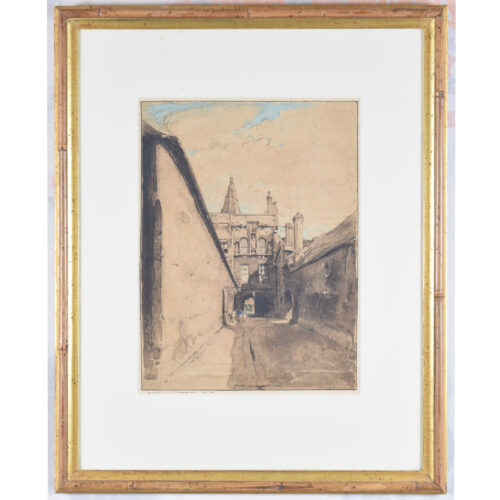
William Nicholson (1872 - 1949)
New College Lane, Oxford
Lithograph 35 x 28 cm Signed lower left and numbered 10 in ink. Between 1902 and 1904 William Nicholson lived in Woodstock; during this period he made several architectural studies of Oxford's colleges and other University buildings. Sir William Nicholson was a British painter and printmaker. He is also known as an illustrator, author of children’s books, stained glass designer, and theatre set designer. Condition: very good. If you are interested, please email info@manningfineart.co.uk or call us on 07929 749056. Click here for other pictures of New College, Oxford. -
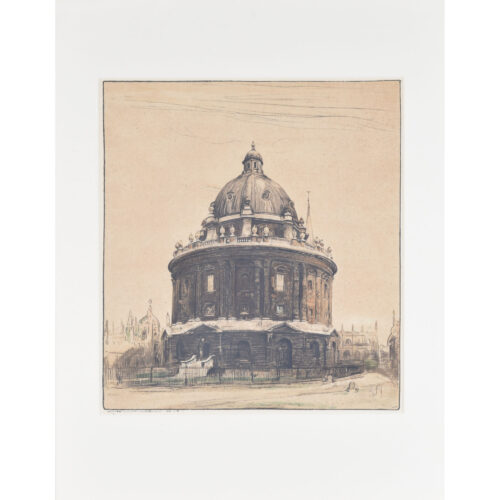
William Nicholson (1872 - 1949)
The Radcliffe Camera, Oxford
Lithograph 35 x 28 cm Signed lower left and numbered 10 in ink. Between 1902 and 1904 William Nicholson lived in Woodstock; during this period he made several architectural studies of Oxford's colleges and other University buildings. Sir William Nicholson was a British painter and printmaker. He is also known as an illustrator, author of children’s books, stained glass designer, and theatre set designer. Condition: very good. If you are interested, please email info@manningfineart.co.uk or call us on 07929 749056. Click here for other general views of Oxford. -
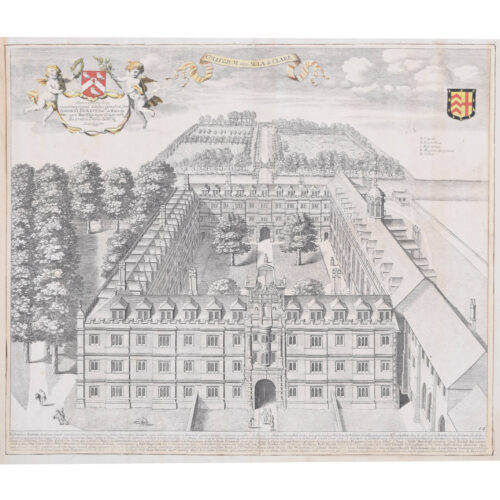
David Loggan (1634 - 1692)
Clare College, Cambridge (1690)
Engraving with later hand-colouring 36 x 43 cm Loggan's aerial view of Clare College; the cartouche borne by two cherubs, titular banner, and college crest have been hand-coloured. Loggan was born to English and Scottish parents, and was baptised in Danzig in 1634. After studying engraving in Danzig with Willem Hondius (1598-1652 or 1658), he moved to London in the late 1650s, going on to produce the engraved title-page for the folio 1662 Book of Common Prayer. He married in 1663 and moved to Nuffield in Oxfordshire in 1665. Loggan was appointed Public Sculptor to the nearby University of Oxford in the late 1660s, having been commissioned to produce bird’s-eye views of all the Oxford colleges. He lived in Holywell Street as he did this. The 'Oxonia Illustrata' was published in 1675, with the help of Robert White (1645 - 1704). Following its completion, Loggan began work on his equivalent work for Cambridge; the 'Cantabrigia Illustrata' was finally published in 1690, when he was made engraver to Cambridge University. The 'Oxonia Illustrata' also includes an engraving of Winchester College (Winchester and New College share William of Wykeham as their founder) whilst the 'Cantabrigia Illustrata' includes one of Eton College (which shares its founder, Henry VIII, with King’s College). Bird’s-eye views from this era required a particular talent as an architectural perspectivist; it was not until 1783 that it became possible for artists to ascend via hot air balloons and view the scenes they were depicting from above. Loggan thus had to rely on his imagination in conceiving the views. Loggan’s views constitute the first accurate depictions of the two Universities, in many ways unchanged today. Whilst the Oxford engravings were produced in reasonable numbers and ran to a second edition by Henry Overton (on thicker paper and with a plate number in Roman numerals in the bottom right-hand corner), those of Cambridge were printed in much smaller numbers. The Dutchman Pieter van der Aa published some miniature versions of the engravings for James Beverell’s guidebook to the UK, 'Les Delices de la Grande Bretagne' (circa 1708). The contemporary artist Andrew Ingamells has produced a highly-acclaimed series of etchings which bring Loggan’s original vision up to date. Condition: good; trimmed to platemark and mounted to antique laid paper. Other items pasted to reverse. If you’d like to know more, please email info@manningfineart.co.uk or call us on 07929 749056. Click here for other views of Clare College, Cambridge. -
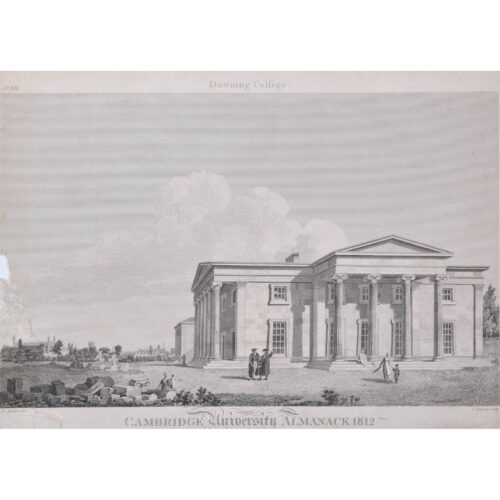
Samuel Sparrow (active 1770 - 1806) after Henry Barker (1774 - 1856)
Downing College, Cambridge (1812)
Engraving 31 x 43 cm A copy of this engraving is held by the British Museum. An early nineteenth-century engraving of Downing College, with building materials in the foreground and elegantly dressed figures, including two scholars, strolling in the College's grounds. The Cambridge University Almanack was an annual almanac published by the Cambridge University Press. It traditionally included engravings or lithographs of the University and information about the upcoming year. Condition: generally good, except loss to left hand side. If you’d like to know more, please email info@manningfineart.co.uk or call us on 07929 749056. -

Women's Auxiliary Army Corps Officer (Clerical Section) 1917 uniform
Lithograph 50 x 31 cm Produced for the Institute of Army Education. Printed for HM Stationery Office by I A Limited, Southall 51. These posters were produced by the Institute of Army Education, likely for display in barracks. Created in the 1950s, they illustrate the 'vintage' uniforms worn by the Corps during the First World War. Condition: punched holes to corners as issued; otherwise generally very good. If you are interested, please email info@manningfineart.co.uk or call us on 07929 749056. Click here for other original vintage Institute of Army Education uniform posters. -
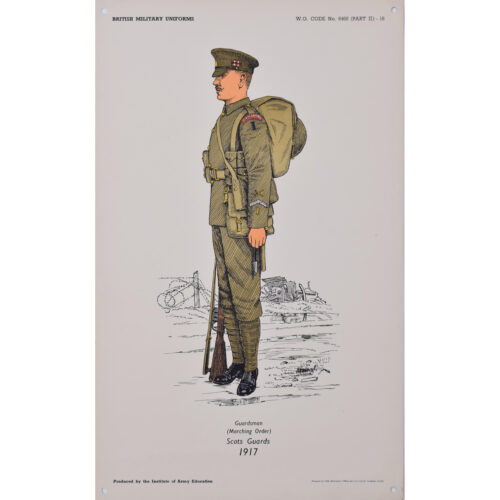
Scots Guards Guardsman (Marching Order) 1917 uniform
Lithograph 50 x 31 cm Produced for the Institute of Army Education. Printed for HM Stationery Office by I A Limited, Southall 51. These posters were produced by the Institute of Army Education, likely for display in barracks. Created in the 1950s, they illustrate the 'vintage' uniforms worn by the Corps during the First World War. Condition: punched holes to corners as issued; otherwise generally very good. If you are interested, please email info@manningfineart.co.uk or call us on 07929 749056. Click here for other original vintage Institute of Army Education uniform posters. -
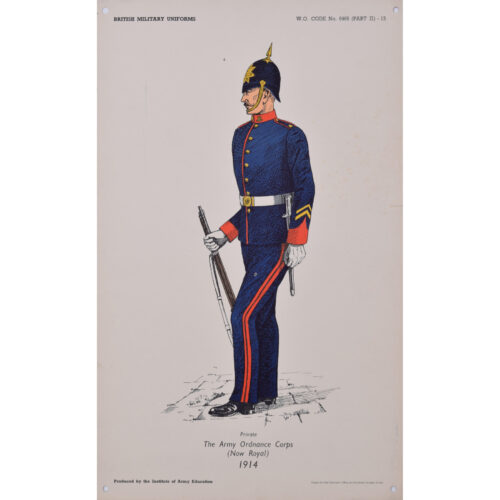
The Royal Army Ordnance Corps (now Royal Logistics Corps) 1914 uniform
Lithograph 50 x 31 cm Produced for the Institute of Army Education. Printed for HM Stationery Office by I A Limited, Southall 51. These posters were produced by the Institute of Army Education, likely for display in barracks. Created in the 1950s, they illustrate the 'vintage' uniforms worn by the Corps during the First World War. Condition: punched holes to corners as issued; faint spotting and small repaired tear to right. If you are interested, please email info@manningfineart.co.uk or call us on 07929 749056. Click here for other original vintage Institute of Army Education uniform posters. -

after Samuel Buck (1696 - 1779) and Nathaniel Buck (active 1724 - 1759)
The South View of Bindon Abbey, in the County of Dorset (1733)
Engraving 20 x 37 cm An engraved view of Bindon Abbey, a Cistercian monastery on the River Frome in Dorset. The monastery was founded in 1149 by William de Glastonia on the site since known as Little Bindon near Bindon Hill. In 1172 the monastery moved to a site near Wool, and was supported by the house of Plantagenet. The abbey was scheduled for Dissolution in 1536, and finally dissolved in 1539. Only ruins remain. Samuel and Nathaniel Buck were brothers and notable 18th century architectural artists, best known for their depictions of ancient castles and monasteries entitled 'Buck's Antiquities' and those of townscapes of England and Wales, ''Sea-Ports and Capital Towns''. Little is known about the brothers' lives. Samuel was born in Yorkshire and died in penury in London in 1779, and was buried in the churchyard of St Clement Danes. Nathaniel pre-deceased him, dying between 1759 and 1774. Condition: generally good; some age toning; mounted to board; sheet trimmed outside platemark. If you are interested, please email info@manningfineart.co.uk or call us on 07929 749056. -
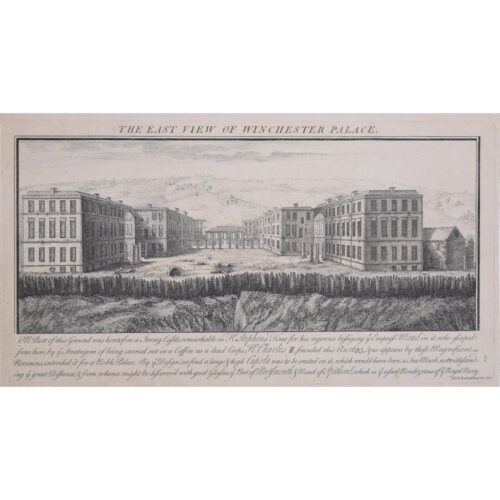
after Samuel Buck (1696 - 1779) and Nathaniel Buck (active 1724 - 1759)
The East View of Winchester Palace (1733)
Engraving 20 x 37 cm An engraved view of Winchester Palace, a bishop's palace built in the 12th century. It served as the London townhouse of the Bishops of Winchester and remained in use until around 1700, when it was divided up into tenements and warehouses. The building was largely destroyed by fire in 1814. Samuel and Nathaniel Buck were brothers and notable 18th century architectural artists, best known for their depictions of ancient castles and monasteries entitled 'Buck's Antiquities' and those of townscapes of England and Wales, ''Sea-Ports and Capital Towns''. Little is known about the brothers' lives. Samuel was born in Yorkshire and died in penury in London in 1779, and was buried in the churchyard of St Clement Danes. Nathaniel pre-deceased him, dying between 1759 and 1774. Condition: generally very good; slight age toning; sheet trimmed outside platemark; mounted to board. If you are interested, please email info@manningfineart.co.uk or call us on 07929 749056. Click here for other pictures of London. -

William Kip (active 1598 - 1610) after Christopher Saxton (1540 - 1610)
Map of Cambridgeshire (1637)
Engraving with later hand colouring 29 x 32 cm An antique map of Cambridgeshire. The map was originally published in William Camden's atlas 'Britannia', which was first published in 1586. William Kip was a goldsmith and map engraver. He was born in Utrecht in the Netherlands and moved to London to pursue his career as an engraver. Alongside William Hole, Kip re-engraved Christopher Saxton's 1574 county maps for publication in Camden's 'Britannia', and it is this venture for which he is most well-known. Christopher Saxton was an English cartographer who produced the first county maps of England and Wales. Between 1574 and 1578 he engraved maps of every county in Britain, and compiled them into an atlas in 1579. These maps bore Queen Elizabeth I's arms as well as those of Saxton's patron, Thomas Seckford. Condition: generally good; faint evidence of old staining. If you are interested, please email info@manningfineart.co.uk or call us on 07929 749056. Click here for more maps and general pictures of Cambridge. -
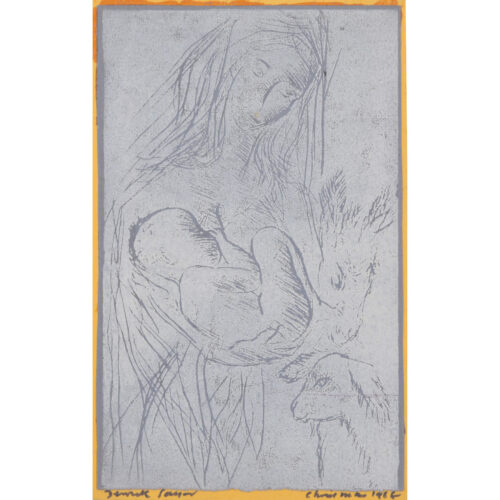
Derrick Latimer Sayer (1917 - 1992)
Madonna and Child (Christmas Card)
Linocut 21 x 13.5 cm Mounted to card, signed 'Derrick Sayer' and dated Christmas 1968. Sayer's linocut of the Virgin Mary and baby Jesus is hauntingly emotive; his spare use of line shows Mary, eyes closed, cradling her newborn son. Two animals from the stable in Bethlehem look on. Sayer studied at the Chelsea School of Art under Graham Sutherland and Henry Moore, and then in Paris in Ben Nicholson's studio. In the late 1930s he was in Cornwall, founding the Mousehole Group Art School. He was well known for his work as a poster artist and book illustrator. Condition: very good. If you are interested, please email info@manningfineart.co.uk or call us on 07929 749056. -
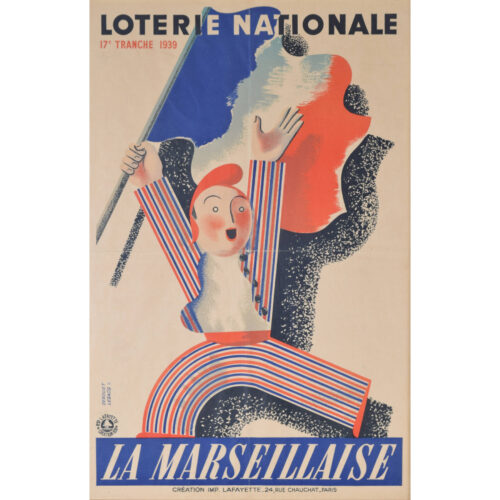
Edgard Derouet (1910 - 2001)
Loterie Nationale La Marseillaise (1939)
Original vintage poster 59 x 39 cm Derouet's famous "jumping man" motif features on this stylish Art Deco poster which advertises the National Lottery. The figure's pinstripe trousers are in the colours of the French flag, which he also waves animatedly; the figure became the figurehead of the Loterie Nationale. Edgar Derouet was a French painter and poster artist. He studied under the celebrated poster artist Paul Colin, and worked as a poster illustrator for most of his career. During the Second World War he worked for the Vichy government and the German film industry; he became the artistic director of the magazine Art et Industrie when the war ended in 1945. He stopped working as a poster artist in 1954, instead running a print shop. Condition: generally very good; folds as issued; some browning to paper. If you are interested, please email info@manningfineart.co.uk or call us on 07929 749056. Click here for other original vintage posters. -
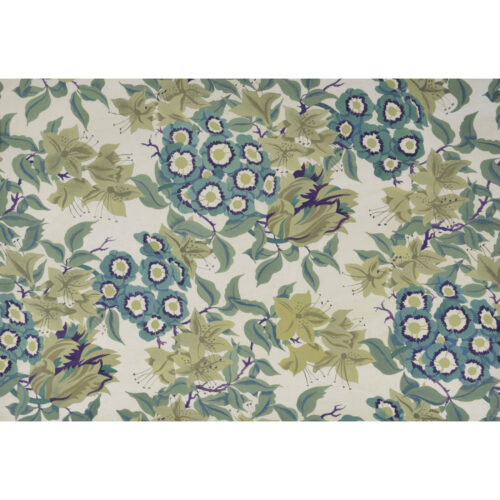
Glasgow School of Art
Wallpaper design
Gouache 33 x 48 cm An Arts and Crafts wallpaper design in the style popularised by William Morris, featuring pansies and lilies in shades of green, blue, and purple. Condition: generally very good; a few very faint spots. If you are interested, please email info@manningfineart.co.uk or call us on 07929 749056. -
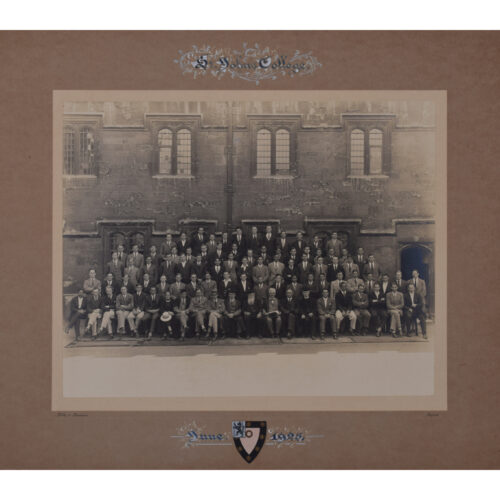
Hills and Saunders
St John's College, Oxford (1925)
Silver gelatin photograph with extensive hand-decoration of mount 43 x 49 cm A photograph taken of St John's College students and tutors in 1925. Hills & Saunders was one of the leading Victorian social photography firms. Robert Hills and Henry Saunders started the firm together in 1860 and had studios in Oxford, Cambridge, and London during the course of their partnership, as well as near certain army bases and public schools. They were given a Royal Warrant in 1867. Condition: generally very good. If you are interested, please email info@manningfineart.co.uk or call us on 07929 749056. Click here for more St John's pictures. -
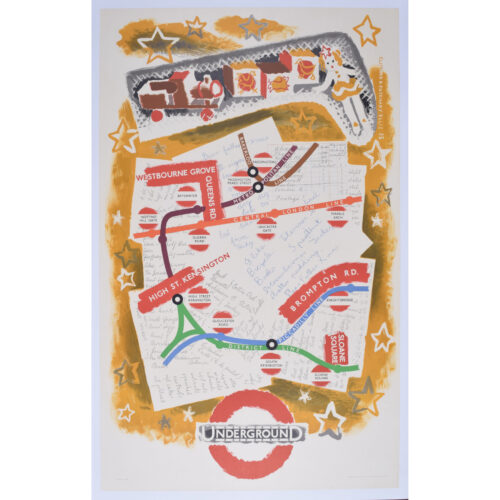
Clifford and Rosemary Ellis
London Underground Map (1935)
Original vintage poster 103 x 64 cm Signed in the plate 'Clifford & Rosemary Ellis '35". Printed by Waterlow & Sons Ltd for London Transport. Provenance: the artists' studio. This marvellous original vintage poster was designed for London Transport and encourages shoppers to use the Tube to do their Christmas shopping. The map of London's streets of shops, including High Street Kensington, Westbourne Grove, and the Brompton Road, are set on the background of Christmas wishlists and shopping lists. The cross-section of a Christmas stocking at the top of the poster includes a doll and a toy train amongst other stocking fillers. London Transport was the forerunner of London Underground. During the 1930s London Transport commissioned over forty posters a year from well-known artists such as Laura Knight, CRW Nevinson, Edward Wadsworth, Eric Ravilious, Paul Nash, Graham Sutherland, and Edward McKnight Kauffer – a bold policy that did much to popularise avant-garde artistic styles that stemmed from Cubism, Futurism and Abstraction. Condition: very good; backed to linen. If you are interested, please email info@manningfineart.co.uk or call us on 07929 749056. Click here for other original vintage London Transport posters. -
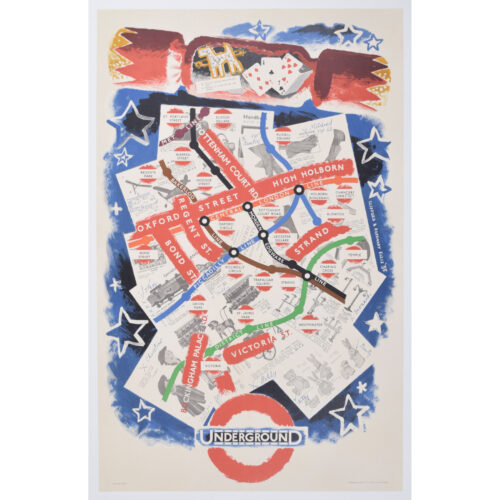
Clifford and Rosemary Ellis
London Underground Map (1935)
Original vintage poster 103 x 64 cm Signed in the plate 'Clifford & Rosemary Ellis '35". Printed by Waterlow & Sons Ltd for London Transport. Provenance: the artists' studio. This marvellous original vintage poster was designed for London Transport and encourages shoppers to use the Tube to do their Christmas shopping. The map of London's streets of shops, including Oxford Street, Regent Street, and Bond Street, are set on the background of a Christmas shopping list and various items to be purchased. The cross-section of a Christmas cracker at the top of the poster includes the joke: 'Why is a railway timetable like life?' - 'Because it is full of ups and downs. London Transport was the forerunner of London Underground. During the 1930s London Transport commissioned over forty posters a year from well-known artists such as Laura Knight, CRW Nevinson, Edward Wadsworth, Eric Ravilious, Paul Nash, Graham Sutherland, and Edward McKnight Kauffer – a bold policy that did much to popularise avant-garde artistic styles that stemmed from Cubism, Futurism and Abstraction. Condition: very good; backed to linen. If you are interested, please email info@manningfineart.co.uk or call us on 07929 749056. Click here for other original vintage London Transport posters. -
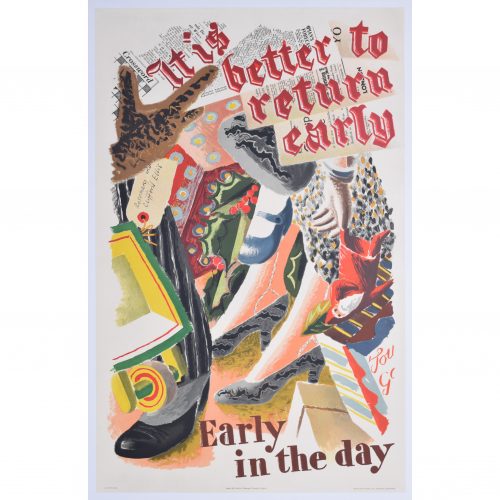
Clifford and Rosemary Ellis
It Is Better To Return Early
Lithographic poster 102 x 61 cm Printed by Waterlow & Sons Ltd for London Transport. This original vintage poster was designed for London Transport and encourages shoppers to head home earlier in the day to avoid congestion on the London Underground and buses. The well-heeled customers in the poster sport smart 1930s shoes, and jostle against their purchases (a Father Christmas puppet and red-berried holly leaves mark the design as published in time for Christmas). The pinstripe-suited gentleman's newspaper serves as the background for the first line of the poster's text, which is slanted in the synthetic cubist style (synthetic cubists were keen to explore collage in their work, often employing collage, especially of newsprint). London Transport was the forerunner of London Underground. During the 1930s London Transport commissioned over forty posters a year from well-known artists such as Laura Knight, CRW Nevinson, Edward Wadsworth, Eric Ravilious, Paul Nash, Graham Sutherland, and Edward McKnight Kauffer – a bold policy that did much to popularise avant-garde artistic styles that stemmed from Cubism, Futurism and Abstraction. Condition: very good, backed to linen. If you are interested, please email info@manningfineart.co.uk or call us on 07929 749056. Click here for other works by Clifford and Rosemary Ellis. -
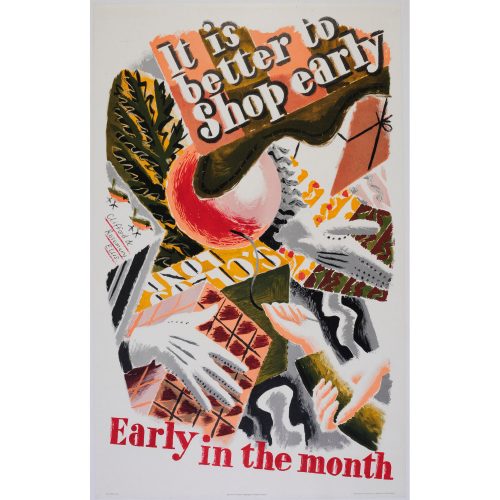
Clifford and Rosemary Ellis
Shop Early (1935)
Lithographic poster for London Transport 101 x 63.5 cm Printed by Waterlow & Sons Ltd For the artist’s biographical details and for other works by the artist available for sale please click here. If you are interested email info@manningfineart.co.uk or call us on 07929 749056. -
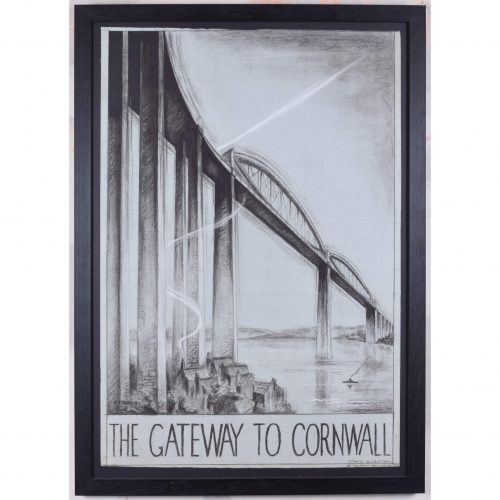
Ronald T Horley (active 1930s - 1940s)
The Gateway to Cornwall
Charcoal heightened with white 76 x 53 cm Signed and inscribed lower right 'Architect's Office, 83 Marlborough Place NW8 Marylebone'. The Great Western Railway commissioned a series of posters promoting train travel around the UK. This charcoal drawing of the Royal Albert Bridge at Saltash is the artist's original design for a poster encouraging rail travel to Devon and Cornwall. The bridge is known fondly as the 'Gateway to Cornwall'. The Royal Albert Bridge was designed by Isambard Kingdom Brunel. Surveying started in 1848 and construction commenced in 1854. The first main span was positioned in 1857 and the completed bridge was opened by Prince Albert on 2 May 1859. Condition: generally very good; a few isolated spots to bottom left corner. Click here for other original vintage travel posters and designs. -
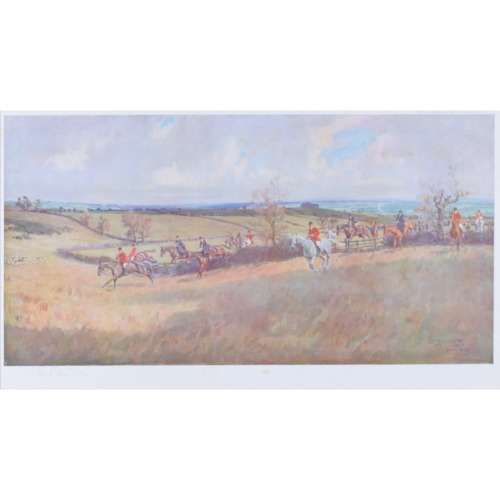
Lionel Edwards (1878 - 1966)
The Quorn Hunt (1934)
Lithograph 34 x 62 cm Signed, titled and dated in plate lower right. Signed in pencil outside plate lower left. A Lionel Edwards lithograph depicting the Quorn - part of the artist's 'Hunting Countries' series. The Quorn Hunt has a claim to be the oldest hunt in the country, being founded in 1696 by Mr Thomas Boothby of Tooley Park, Leicestershire. The hunt takes its name from the village of Quorn, where the hounds were kennelled from 1753 to 1904. Lionel Edwards was a British artist who specialised in pictures of country life, particularly horses, and provided illustrations for Country Life. He is best known for his hunting scenes but also painted pictures of horse racing, shooting and fishing. Condition: print generally good; a couple of very small brown spots. Original 3/4" black frame in generally good condition. If you are interested, please email info@manningfineart.co.uk or call us on 07929 749056. Click here for other hunting pictures. -

Lionel Edwards (1878 - 1966)
The Hertfordshire Hunt (1927)
Lithograph 36 x 50 cm Signed and dated in plate lower left. A Lionel Edwards lithograph depicting the Hertfordshire - part of the artist's 'Hunting Countries' series. The Hertfordshire Hunt was founded circa 1775 by the Countess of Salisbury, of Hatfield House. Lionel Edwards was a British artist who specialised in pictures of country life, particularly horses, and provided illustrations for Country Life. He is best known for his hunting scenes but also painted pictures of horse racing, shooting and fishing. Condition: print generally good; a couple of tiny scuffs to surface. Modern frame. If you are interested, please email info@manningfineart.co.uk or call us on 07929 749056. Click here for other hunting pictures. -
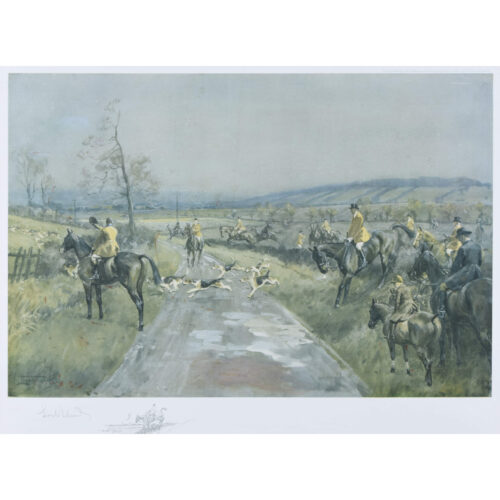
Lionel Edwards (1878 - 1966)
The South Notts Hunt (1928)
Lithograph 31 x 51 cm Signed and dated in plate lower left, and in pencil outside plate lower left. Note to reverse (1988) identifies those illustrated. A Lionel Edwards lithograph depicting the South Notts Hunt - part of the artist's 'Hunting Countries' series. The South Notts country lies in Nottinghamshire and Derbyshire and has been hunted as far back as 1677 by the Earl of Lincoln. In 1775 it was hunted by John Musters, the great-grandfather of John Chaworth-Musters, and in 1860 Mr. John Chaworth-Musters re-established the hunt. Lionel Edwards was a British artist who specialised in pictures of country life, particularly horses, and provided illustrations for Country Life. He is best known for his hunting scenes but also painted pictures of horse racing, shooting and fishing. Condition: print good; original handsome period frame. If you are interested, please email info@manningfineart.co.uk or call us on 07929 749056. Click here for other hunting pictures. -
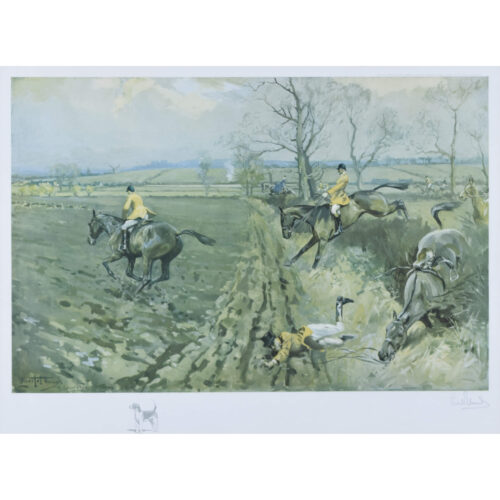
Lionel Edwards (1878 - 1966)
The Belvoir Hunt (1928)
Lithograph 31 x 51 cm Signed and dated in plate lower left, and in pencil outside plate lower left. A Lionel Edwards lithograph depicting the Belvoir - part of the artist's 'Hunting Countries' series. The Belvoir Hunt, sometimes known as the Duke of Rutland's Hounds, dates from 1750 and became a foxhound pack in 1762. Since then, the kennels have been located at Belvoir Castle. Lionel Edwards was a British artist who specialised in pictures of country life, particularly horses, and provided illustrations for Country Life. He is best known for his hunting scenes but also painted pictures of horse racing, shooting and fishing. Condition: print good; original handsome period frame; small area of loss to top of frame. If you are interested, please email info@manningfineart.co.uk or call us on 07929 749056. Click here for other hunting pictures. -
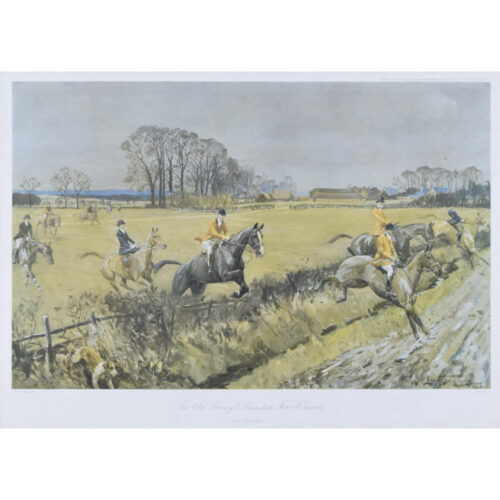
Lionel Edwards (1878 - 1966)
The Old Surrey and Burstow Fox Hounds - at Burstow (1926)
Lithograph 36 x 51 cm Signed and dated in plate lower right. In original 3/4" black frame. A Lionel Edwards lithograph depicting the Old Surrey and Burstow - part of the artist's 'Hunting Countries' series. The Old Surrey and Burstow (now the Old Surrey, Burstow and West Kent Hunt) has been hunting from Felbridge since 1909. The Burstow dates as a foxhound pack from 1866, having previously existed as a harrier pack. Lionel Edwards was a British artist who specialised in pictures of country life, particularly horses, and provided illustrations for Country Life. He is best known for his hunting scenes but also painted pictures of horse racing, shooting and fishing. Condition: print generally good; the odd tiny spot in top right corner. In original 3/4" black frame; some scratches to frame. If you are interested, please email info@manningfineart.co.uk or call us on 07929 749056. Click here for other hunting pictures. -

Lionel Edwards (1878 - 1966)
Foxhounds [unidentified pack] (1962)
Lithograph 31 x 43 cm Signed and dated in plate lower right. A Lionel Edwards lithograph - part of the artist's 'Hunting Countries' series. If you know which pack is depicted here, please let us know! Lionel Edwards was a British artist who specialised in pictures of country life, particularly horses, and provided illustrations for Country Life. He is best known for his hunting scenes but also painted pictures of horse racing, shooting and fishing. Condition: print generally good; some time staining to periphery. If you are interested, please email info@manningfineart.co.uk or call us on 07929 749056. Click here for other hunting pictures. -
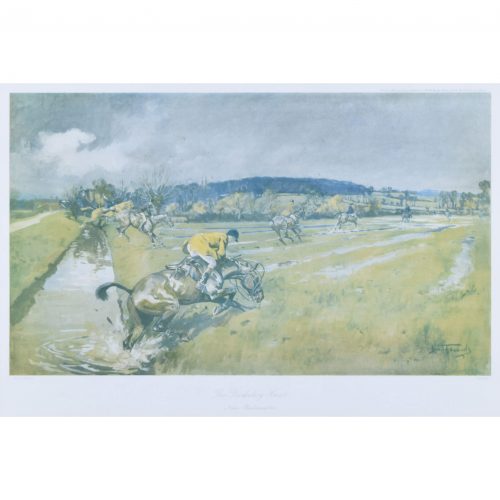
Lionel Edwards (1878 - 1966)
The Berkeley Hunt - Near Rockhampton (1925)
Lithograph 34 x 51 cm Signed in plate lower right. In original 3/4" black frame. A Lionel Edwards lithograph depicting the Berkeley - part of the artist's 1925 'Hunting Countries' series. The yellow coats with green collars and the running fox on the lapel are worn by the Masters and Hunt Staff and are unique in hunting circles, representing the outdoor livery of the Berkeley family; the ladies' colours of navy and maroon represent the indoor livery. The Berkeley is the oldest pack in the country and is one of the very few that are still family owned. The Fifth Earl of Berkeley could hunt his hounds from Berkeley Castle to Berkeley Square in London and had six kennels along the route. The season would start in Berkeley and progress to each of his kennels to London and then in stages back again to Gloucestershire. The present kennels date from the early 18th century and are home to around 90 hounds. Lionel Edwards was a British artist who specialised in pictures of country life, particularly horses, and provided illustrations for Country Life. He is best known for his hunting scenes but also painted pictures of horse racing, shooting and fishing. Condition: print generally good; the odd tiny spot in top left area. In original 3/4" black frame - some scratches to frame. If you are interested, please email info@manningfineart.co.uk or call us on 07929 749056. Click here for other hunting pictures. -
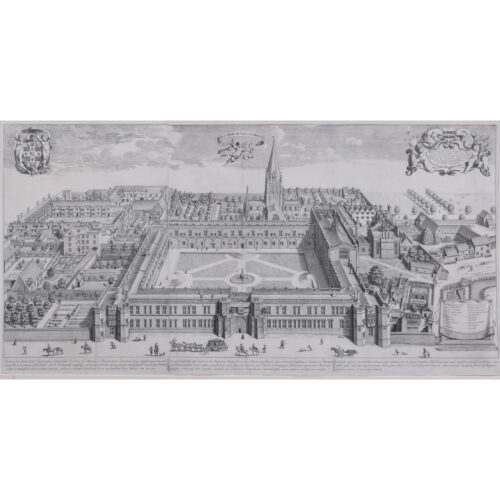
David Loggan (1634 - 1692)
Christ Church, Oxford (1675)
Engraving 42 x 84 cm Loggan's view of Christ Church from the 'Oxonia Illustrata'. Loggan was born to English and Scottish parents, and was baptised in Danzig in 1634. After studying engraving in Danzig with Willem Hondius (1598-1652 or 1658), he moved to London in the late 1650s, going on to produce the engraved title-page for the folio 1662 Book of Common Prayer. He married in 1663 and moved to Nuffield in Oxfordshire in 1665. Loggan was appointed Public Sculptor to the nearby University of Oxford in the late 1660s, having been commissioned to produce bird’s-eye views of all the Oxford colleges. He lived in Holywell Street as he did this. The 'Oxonia Illustrata' was published in 1675, with the help of Robert White (1645-1704). Following its completion, Loggan began work on his equivalent work for Cambridge; the 'Cantabrigia Illustrata' was finally published in 1690, when he was made engraver to Cambridge University. The 'Oxonia Illustrata' also includes an engraving of Winchester College (Winchester and New College share William of Wykeham as their founder) whilst the 'Cantabrigia Illustrata' includes one of Eton College (which shares its founder, Henry VIII, with King’s College). Bird’s-eye views from this era required a particular talent as an architectural perspectivist; it was not until 1783 that it became possible for artists to ascend via hot air balloons and view the scenes they were depicting from above. Loggan thus had to rely on his imagination in conceiving the views. Loggan’s views constitute the first accurate depictions of the two Universities, in many ways unchanged today. Whilst the Oxford engravings were produced in reasonable numbers and ran to a second edition by Henry Overton (on thicker paper and with a plate number in Roman numerals in the bottom right-hand corner), those of Cambridge were printed in much smaller numbers. The Dutchman Pieter van der Aa published some miniature versions of the engravings for James Beverell’s guidebook to the UK, 'Les Delices de la Grande Bretagne' (circa 1708). The contemporary artist Andrew Ingamells (born 1956) has produced a highly-acclaimed series of etchings which bring Loggan’s original vision up to date. Condition: very good. If you are interested, please email info@manningfineart.co.uk or call us on 07929 749056. Click here for other views of Christ Church. -
Out of stock
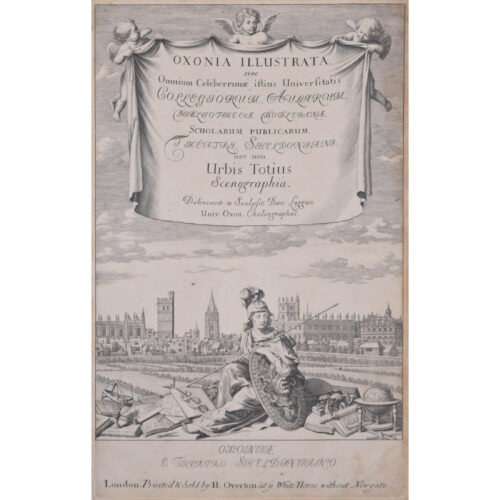
David Loggan (1634 - 1692)
Frontispiece to the Oxonia Illustrata (1675)
Engraving 38 x 24 cm The intricately engraved frontispiece to Loggan's 'Oxonia Illustrata', featuring cherubs bearing the volume's title on a banner and Minerva, goddess of wisdom, sitting before a panorama of Oxford's resplendent architecture. David Loggan's view of Oxford's medieval Divinity School, which was once the beating heart of theological studies at the University. Of particular interest here is the trompe l'oeil scroll of torn paper which frames the view. Loggan was born to English and Scottish parents, and was baptised in Danzig in 1634. After studying engraving in Danzig with Willem Hondius (1598-1652 or 1658), he moved to London in the late 1650s, going on to produce the engraved title-page for the folio 1662 Book of Common Prayer. He married in 1663 and moved to Nuffield in Oxfordshire in 1665. Loggan was appointed Public Sculptor to the nearby University of Oxford in the late 1660s, having been commissioned to produce bird’s-eye views of all the Oxford colleges. He lived in Holywell Street as he did this. The 'Oxonia Illustrata' was published in 1675, with the help of Robert White (1645-1704). Following its completion, Loggan began work on his equivalent work for Cambridge; the 'Cantabrigia Illustrata' was finally published in 1690, when he was made engraver to Cambridge University. The 'Oxonia Illustrata' also includes an engraving of Winchester College (Winchester and New College share William of Wykeham as their founder) whilst the 'Cantabrigia Illustrata' includes one of Eton College (which shares its founder, Henry VIII, with King’s College). Bird’s-eye views from this era required a particular talent as an architectural perspectivist; it was not until 1783 that it became possible for artists to ascend via hot air balloons and view the scenes they were depicting from above. Loggan thus had to rely on his imagination in conceiving the views. Loggan’s views constitute the first accurate depictions of the two Universities, in many ways unchanged today. Whilst the Oxford engravings were produced in reasonable numbers and ran to a second edition by Henry Overton (on thicker paper and with a plate number in Roman numerals in the bottom right-hand corner), those of Cambridge were printed in much smaller numbers. The Dutchman Pieter van der Aa published some miniature versions of the engravings for James Beverell’s guidebook to the UK, 'Les Delices de la Grande Bretagne' (circa 1708). The contemporary artist Andrew Ingamells (born 1956) has produced a highly-acclaimed series of etchings which bring Loggan’s original vision up to date. Condition: trimmed within platemark and mounted to board, otherwise in very good condition. If you are interested, please email info@manningfineart.co.uk or call us on 07929 749056. Click here for other general views of Oxford. -
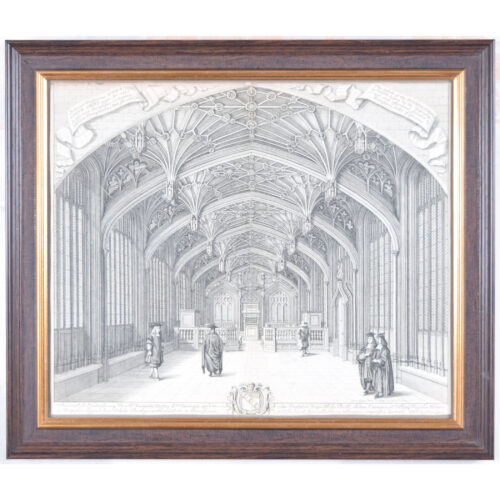
David Loggan (1634 - 1692)
The Divinity School, Oxford (1675)
Engraving 33 x 41 cm David Loggan's view of Oxford's medieval Divinity School, which was once the beating heart of theological studies at the University. Of particular interest here is the trompe l'oeil scroll of torn paper which frames the view. Loggan was born to English and Scottish parents, and was baptised in Danzig in 1634. After studying engraving in Danzig with Willem Hondius (1598-1652 or 1658), he moved to London in the late 1650s, going on to produce the engraved title-page for the folio 1662 Book of Common Prayer. He married in 1663 and moved to Nuffield in Oxfordshire in 1665. Loggan was appointed Public Sculptor to the nearby University of Oxford in the late 1660s, having been commissioned to produce bird’s-eye views of all the Oxford colleges. He lived in Holywell Street as he did this. The 'Oxonia Illustrata' was published in 1675, with the help of Robert White (1645-1704). Following its completion, Loggan began work on his equivalent work for Cambridge; the 'Cantabrigia Illustrata' was finally published in 1690, when he was made engraver to Cambridge University. The 'Oxonia Illustrata' also includes an engraving of Winchester College (Winchester and New College share William of Wykeham as their founder) whilst the 'Cantabrigia Illustrata' includes one of Eton College (which shares its founder, Henry VIII, with King’s College). Bird’s-eye views from this era required a particular talent as an architectural perspectivist; it was not until 1783 that it became possible for artists to ascend via hot air balloons and view the scenes they were depicting from above. Loggan thus had to rely on his imagination in conceiving the views. Loggan’s views constitute the first accurate depictions of the two Universities, in many ways unchanged today. Whilst the Oxford engravings were produced in reasonable numbers and ran to a second edition by Henry Overton (on thicker paper and with a plate number in Roman numerals in the bottom right-hand corner), those of Cambridge were printed in much smaller numbers. The Dutchman Pieter van der Aa published some miniature versions of the engravings for James Beverell’s guidebook to the UK, 'Les Delices de la Grande Bretagne' (circa 1708). The contemporary artist Andrew Ingamells (born 1956) has produced a highly-acclaimed series of etchings which bring Loggan’s original vision up to date. Condition: trimmed within platemark and mounted to board, otherwise in very good condition. If you are interested, please email info@manningfineart.co.uk or call us on 07929 749056. Click here for other general views of Oxford. -
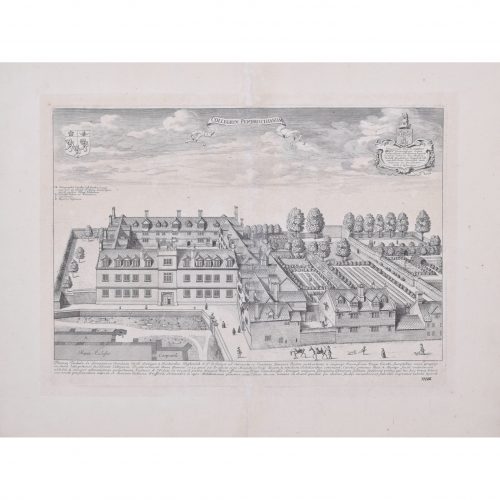
David Loggan (1634 - 1692)
Pembroke College, Oxford (1705)
Engraving 31 x 44 cm Loggan's view of Pembroke from the second edition of the 'Oxonia Illustrata'. Loggan was born to English and Scottish parents, and was baptised in Danzig in 1634. After studying engraving in Danzig with Willem Hondius (1598-1652 or 1658), he moved to London in the late 1650s, going on to produce the engraved title-page for the folio 1662 Book of Common Prayer. He married in 1663 and moved to Nuffield in Oxfordshire in 1665. Loggan was appointed Public Sculptor to the nearby University of Oxford in the late 1660s, having been commissioned to produce bird’s-eye views of all the Oxford colleges. He lived in Holywell Street as he did this. The 'Oxonia Illustrata' was published in 1675, with the help of Robert White (1645-1704). Following its completion, Loggan began work on his equivalent work for Cambridge; the 'Cantabrigia Illustrata' was finally published in 1690, when he was made engraver to Cambridge University. The 'Oxonia Illustrata' also includes an engraving of Winchester College (Winchester and New College share William of Wykeham as their founder) whilst the 'Cantabrigia Illustrata' includes one of Eton College (which shares its founder, Henry VIII, with King’s College). Bird’s-eye views from this era required a particular talent as an architectural perspectivist; it was not until 1783 that it became possible for artists to ascend via hot air balloons and view the scenes they were depicting from above. Loggan thus had to rely on his imagination in conceiving the views. Loggan’s views constitute the first accurate depictions of the two Universities, in many ways unchanged today. Whilst the Oxford engravings were produced in reasonable numbers and ran to a second edition by Henry Overton (on thicker paper and with a plate number in Roman numerals in the bottom right-hand corner), those of Cambridge were printed in much smaller numbers. The Dutchman Pieter van der Aa published some miniature versions of the engravings for James Beverell’s guidebook to the UK, 'Les Delices de la Grande Bretagne' (circa 1708). The contemporary artist Andrew Ingamells (born 1956) has produced a highly-acclaimed series of etchings which bring Loggan’s original vision up to date. Condition: good. Backed to Japanese Paper. Evidence of some historic separation to central fold. If you are interested, please email info@manningfineart.co.uk or call us on 07929 749056. Click here for other views of Pembroke College, Oxford. -
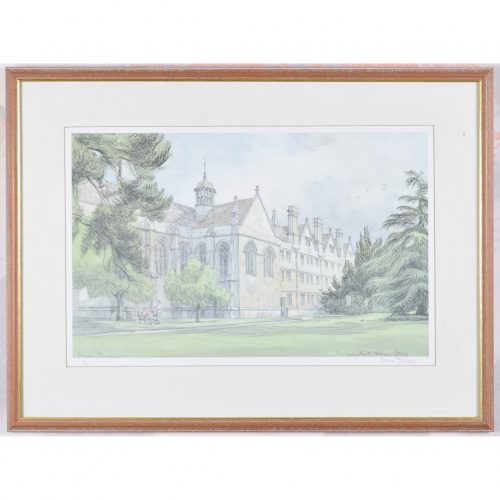
Dennis Flanders (1915 - 1994)
Wadham College, Oxford, Garden Front
Lithograph 30 x 48 cm Numbered 117/500 lower left and signed lower right, both in pencil. Signed lower left and titled lower right in the plate. A tranquil view of Wadham, verdant of grass and leafy of tree. Two undergraduates in jeans and t-shirts chat, laden down with books. Dennis Flanders RBA RWS was a British artist and draughtsman who specialised in pen and ink drawings, often of English landscapes and buildings. He is notable for his meticulous depictions of the impact of aerial bombing upon historic buildings during World War Two. After attending the Merchant Taylors' School, Flanders studied at the Regent Street Polytechnic, St. Martin's School of Art, and at the Central School of Arts and Crafts. Flanders worked at the School of Military Engineering during World War Two and made models of buildings and landscapes based on aerial reconnaissance photographs. He applied for a commission with the War Artists' Advisory Committee and, although he was unsuccessful, the Committee did agree to purchase several drawings from him. These were mostly detailed depictions of bomb-damaged buildings and churches which included views of St Paul's Cathedral and Canterbury Cathedral. After the war, Flanders became a regular exhibitor at the Royal Academy and held his first solo exhibition at Colnaghi in 1947. He illustrated several books and published two volumes of prints from his own drawings of British architecture and landscapes, which had been the dominant theme of his artistic career. Condition: very good. If you are interested, please email info@manningfineart.co.uk or call us on 07929 749056. Click here for other views of Wadham College, Oxford. -
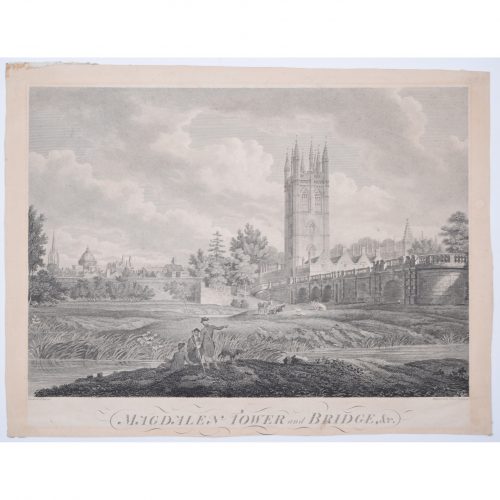
James Basire II (1769 - 1822) after Edward Dayes (1763 - 1804)
Magdalen Tower and Bridge etc. (1797)
Engraving 35 x 44 cm An engraving illustrating the pinnacles of Magdalen Tower and the Bridge below. James Basire II was a British engraver, son of James Basire I, also a celebrated engraver. In 1802 he became Engraver to the Society of Antiquaries. Edward Dayes was an English watercolour painter and mezzotint engraver. He first exhibited at the Royal Academy in 1786, when he showed a portrait and views of Waltham Cross and Canterbury. In the three following years he exhibited both miniatures and landscapes. He continued to exhibit at the Academy regularly until the year of his death, contributing a total of 64 works. He also exhibited at the Society of Artists, and worked as draughtsman to the Duke of York and Albany. Condition: generally good; some age toning within margins. If you are interested, please email info@manningfineart.co.uk or call us on 07929 749056. Click here for other views of Magdalen College, Oxford. -
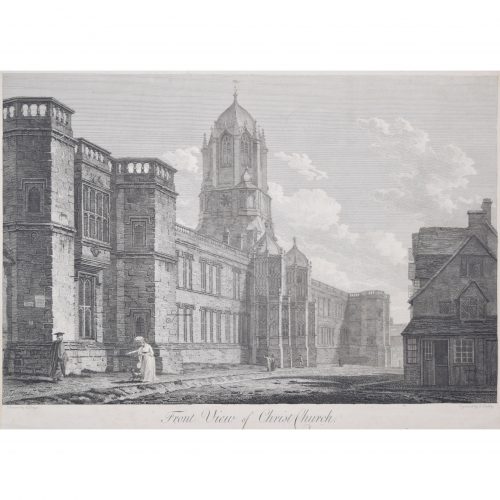
John Dadley (1767 - 1817) after Edward Dayes (1763 - 1804)
Front View of Christ Church (1796)
Engraving 33 x 45 cm An engraving illustrating the magnificent facade of Christ Church from St Aldate's, dominated by Tom Tower. John Dadley was a British portraitist and engraver. Edward Dayes was an English watercolour painter and mezzotint engraver. He first exhibited at the Royal Academy in 1786, when he showed a portrait and views of Waltham Cross and Canterbury. In the three following years he exhibited both miniatures and landscapes. He continued to exhibit at the Academy regularly until the year of his death, contributing a total of 64 works. He also exhibited at the Society of Artists, and worked as draughtsman to the Duke of York and Albany. Condition: generally very good; some age toning to margins. If you are interested, please email info@manningfineart.co.uk or call us on 07929 749056. Click here for other views of Christ Church. -
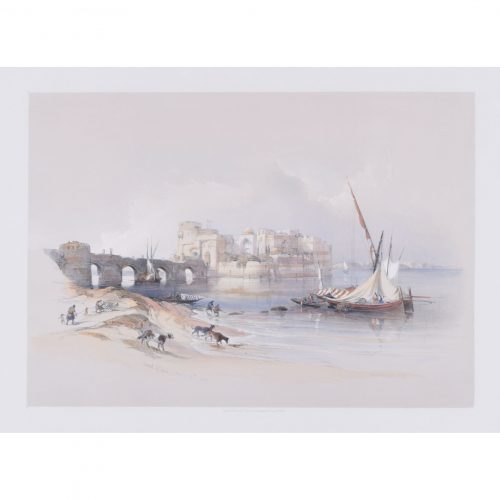
David Roberts (1769 - 1864)
Citadel of Sidon - April 28th, 1839 (published 1943)
Lithograph with hand-colouring 23 x 35 cm (sheet size 17.5 x 24.5 cm) The Citadel of Sidon, or Sidon Sea Castle, was built by crusaders in the thirteenth century as a fortress of the holy land. This lithograph is part of David Roberts' series of views of the Holy Land, which he produced from sketches made during lengthy tours of the Near East in the 1830s. Egypt was much in vogue at this time, and travellers, collectors and lovers of antiquities were keen to buy works inspired by the East or depicting the great monuments of ancient Egypt; Roberts was more than happy to produce pictures on this lucrative theme. Queen Victoria was one of his 400 subscribers, and her set of lithographs is still held by the Royal Collection Trust. The lithographer Louis Haghe worked with Roberts to turn the original sketches into high-quality lithographs, which were then published in the 1840s by the printer F. G. Moon in London. David Roberts RA RBA was a Scottish painter known for his Orientalist pictures. He was elected as a Royal Academician in 1841. -
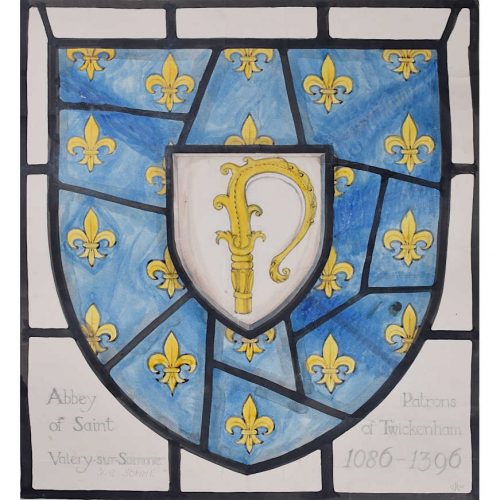
Jane Gray (b.1931)
Stained Glass Window Design, St Mary’s Church, Twickenham (1960)
Watercolour41 x 37 cm
Signed and dated l.r.This stained glass window design is one of a handful Gray designed for her local church, St Mary’s Twickenham. St Mary’s Church stands on the site of an earlier church in Twickenham, a short distance from York House and the banks of the River Thames, and incorporates a 15th-century, medieval tower. St Mary's has an impressive and illustrious history of notable parishioners including the painter Godfrey Kneller who, after the collapse of the ancient church's 14th-century nave in 1714, took active involvement in redesigning the church in the Neo-classical style alongside local architect John James, as well as Henry Fielding and Alfred Lord Tennyson whose sons were both baptised here. Gray had a personal connection to St Mary’s, her great grandfather having been the vicar some years before. This design, in particular, commemorates the benedictine monastery at the mouth of the Somme River: the Abbey of Saint Valery-sur-Somme. The imagery focusses on the repeated motif of the heraldic and highly symbolic fleur-de-lis, set against a sky blue background, the central shield containing the head of an ornate, gilt shepherd’s crook; a religious symbol of care, particularly in difficult circumstances.
Provenance: the artist’s studio sale. Condition: very good. If you are interested, please email info@manningfineart.co.uk or call us on 07929 749056. For other works by Jane Gray and more information about her, please click here. -
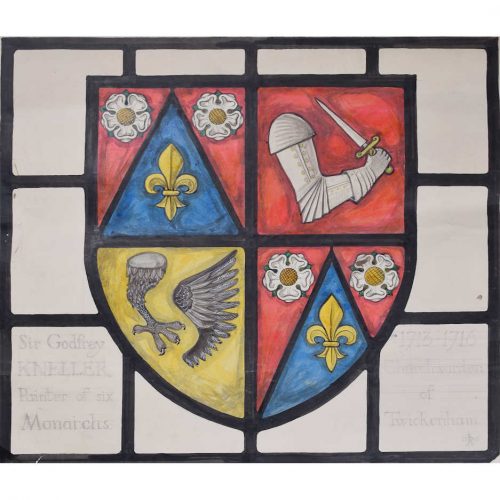
Jane Gray (b.1931)
Sir Godfrey Kneller Stained Glass Window Design, St Mary’s Church, Twickenham (1961)
Watercolour42 x 48.5 cm
Signed and dated l.r.This stained glass window design is one of a handful Gray designed for her local church, St Mary’s Twickenham. St Mary’s Church stands on the site of an earlier church in Twickenham, a short distance from York House and the banks of the River Thames, and incorporates a 15th-century, medieval tower. St Mary's has an impressive and illustrious history of notable parishioners including the painter Godfrey Kneller who, after the collapse of the ancient church's 14th-century nave in 1714, took active involvement in redesigning the church in the Neo-classical style alongside local architect John James, as well as Henry Fielding and Alfred Lord Tennyson whose sons were both baptised here. Gray had a personal connection to St Mary’s, her great grandfather having been the vicar some years before. This design, in particular, commemorates Godfrey Kneller and his active involvement in the church and its redesign in the eighteenth century.
Provenance: the artist’s studio sale. Condition: very good. If you are interested, please email info@manningfineart.co.uk or call us on 07929 749056. For other works by Jane Gray and more information about her, please click here. -
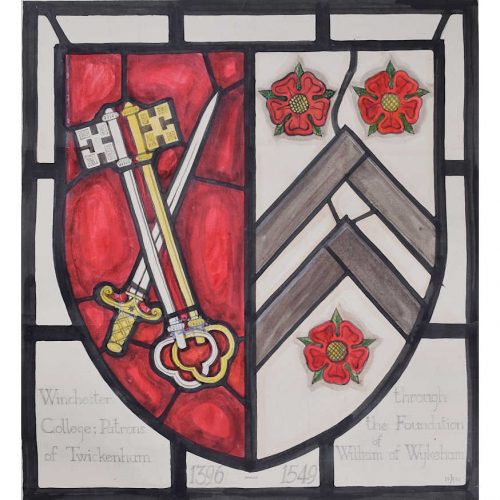
Jane Gray (b.1931)
Winchester College: Patrons of Twickenham Stained Glass Window Design, St Mary’s Church, Twickenham (1960)
Watercolour41.5 x 37.5 cm
Signed and dated l.r.This stained glass window design is one of a handful Gray designed for her local church, St Mary’s Twickenham. St Mary’s Church stands on the site of an earlier church in Twickenham, a short distance from York House and the banks of the River Thames, and incorporates a 15th-century, medieval tower. St Mary's has an impressive and illustrious history of notable parishioners including the painter Godfrey Kneller who, after the collapse of the ancient church's 14th-century nave in 1714, took active involvement in redesigning the church in the Neo-classical style alongside local architect John James, as well as Henry Fielding and Alfred Lord Tennyson whose sons were both baptised here. Gray had a personal connection to St Mary’s, her great grandfather having been the vicar some years before. This design, in particular, focusses on the religious involvement of Winchester College, represented here by the right hand side of the shield which bears the key components of the school’s coat of arms; three red roses and two right-angled bars.
Provenance: the artist’s studio sale. Condition: very good. If you are interested, please email info@manningfineart.co.uk or call us on 07929 749056. For other works by Jane Gray and more information about her, please click here. -
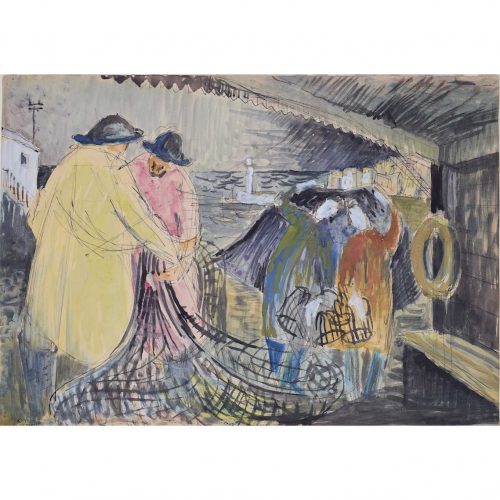
Jane Gray (b.1931)
Fishermen at Work (1950)
Watercolour and ink38.5 x 54.5 cm
Signed and dated l.l. 'Ross'This early ink and watercolour painting of fishermen hauling in a fresh catch, demonstrates Gray’s artistic versatility and highlights her bright, colourful, modern style—even when depicting a scene that is notably grey and wet. Verso, the work also holds a handful of figurative sketches of female and animal forms, and is signed and dated 1948.
Provenance: the artist’s studio sale. Condition: very good. If you are interested, please email info@manningfineart.co.uk or call us on 07929 749056. For other works by Jane Gray and more information about her, please click here. -
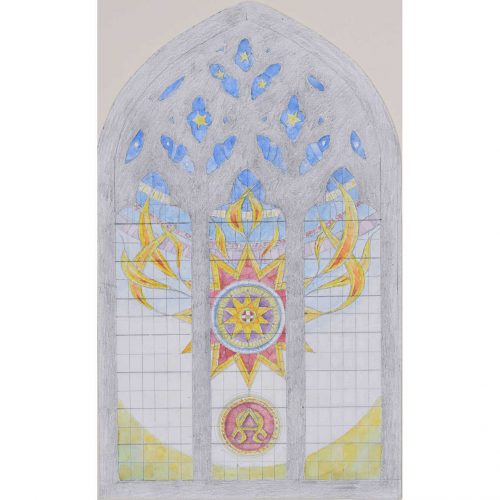
Jane Gray (b.1931)
Design for Large Stained Glass Window in a Church
Watercolour and pencil33.5 x 20.5 cm
This design for a stained glass window draws together Gray’s modern yet traditional approach to designing church windows. The design features a central, inwardly repeating star shape with bright flame-like shapes curling upwards from its corners. This central motif sits against a blue sky background with smaller stars scattered in the smaller glass panes at the top of the design.
Provenance: the artist’s studio sale. Condition: very good. If you are interested, please email info@manningfineart.co.uk or call us on 07929 749056. For other works by Jane Gray and more information about her, please click here. -
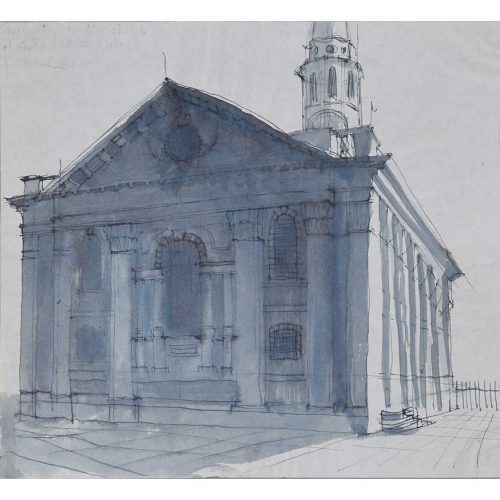
Jane Gray (b.1931)
St Martin in the Fields
Ink and watercolour18 x 19.5 cm
Detailed in the artist's handThis early architectural sketch, depicts, as Gray notes below the drawing, St Martin in the Fields, London, in blue and grey tones, and shows Gray to be an observant and sensitive draughtsman. St Martin-in-the-Fields is a Church of England parish church at the north-east corner of Trafalgar Square in the City of Westminster and is dedicated to Saint Martin of Tours.
Provenance: the artist’s studio sale. Condition: very good. If you are interested, please email info@manningfineart.co.uk or call us on 07929 749056. For other works by Jane Gray and more information about her, please click here. -
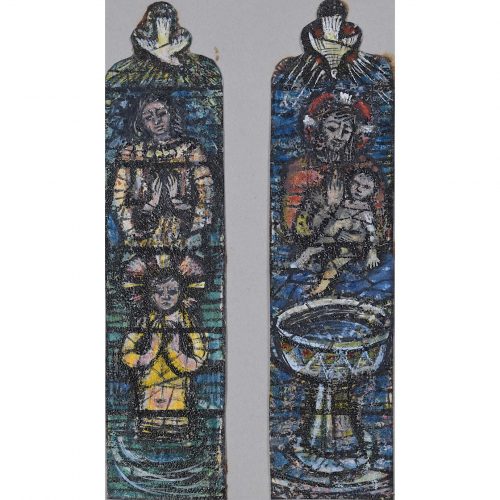
Jane Gray (b.1931)
Baptism Stained Glass Window Designs
Acrylic crackle6 x 13.5 cm
This design for a pair of stained glass windows depicts two baptisms: the baptism of Christ by John on the banks of the Jordan river and, in turn, Christ baptising a child, although, this time, the baptism involves a font. Both images, however, share an identically placed dove, above their respective baptism scenes.
Provenance: the artist’s studio sale. Condition: very good. If you are interested, please email info@manningfineart.co.uk or call us on 07929 749056. For other works by Jane Gray and more information about her, please click here. -
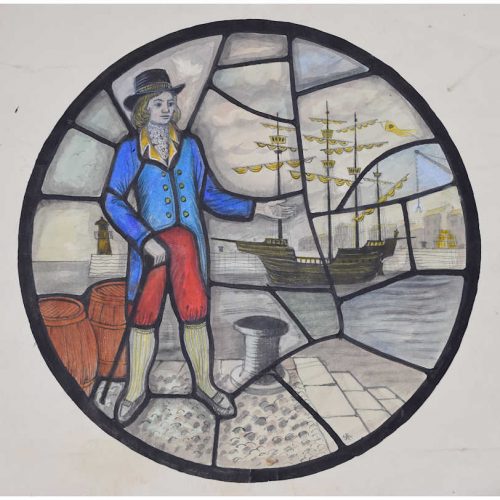
Jane Gray (b.1931)
Port Scene Design for Stained Glass Roundel (1962)
WatercolourD. 25.5 cm
One of Gray’s most interesting stained glass designs, this roundel depicts a colourful port scene, with a brightly attired middle class merchant standing on the dockside in front of an impressive carrack. Whilst a traditional scene, the design has Gray’s uniquely modern twist.
Provenance: the artist’s studio sale. Condition: very good. If you are interested, please email info@manningfineart.co.uk or call us on 07929 749056. For other works by Jane Gray and more information about her, please click here. -
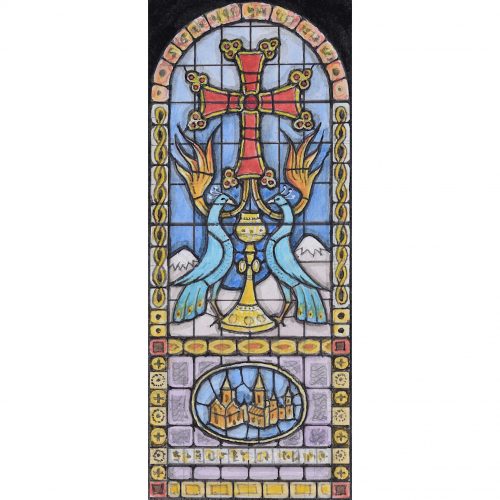
Jane Gray (b.1931)
Stained Glass Window Design for a Church
Watercolour15.5 x 6 cm
This design for a stained glass window draws together Gray’s modern yet traditional approach to designing church windows. The design features an oval external view of the church buildings beneath a pair of bright blue peacocks, two colourfully burning flames and a large red cross.
Provenance: the artist’s studio sale. Condition: very good. If you are interested, please email info@manningfineart.co.uk or call us on 07929 749056. For other works by Jane Gray and more information about her, please click here. -
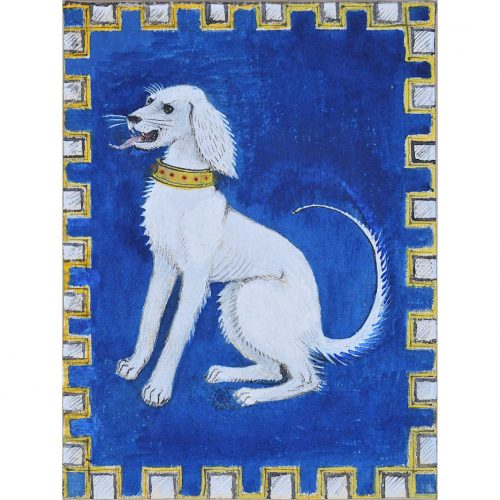
Jane Gray (b.1931)
White Dog
Gouache15.5 x 11.5 cm
This gorgeous little painting of a white dog highlights Gray’s distinctive outlook at the world; the image is at once highly traditional—as if something out of a medieval bestiary—yet also decidedly modern, bold and colourful with a striking, geometric border.
Provenance: the artist’s studio sale. Condition: very good. If you are interested, please email info@manningfineart.co.uk or call us on 07929 749056. For other works by Jane Gray and more information about her, please click here. -
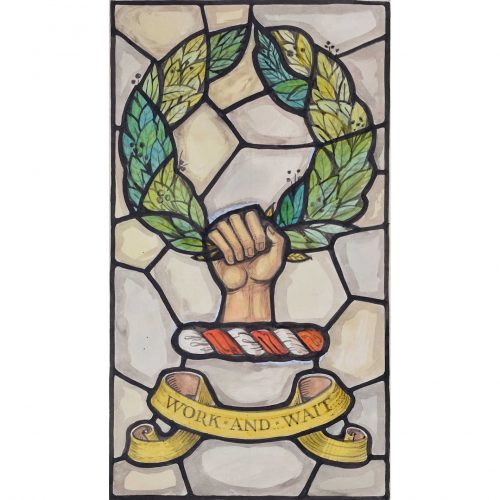
Jane Gray (b.1931)
'Work and Wait' Stained Glass Window Design
Watercolour37.5 x 20.5 cm
This highly graphic, modern stained glass design depicts a communist-style fist clasping a laurel wreath above a rope and scroll reading the motto: ‘Work and Wait’. Most likely a private commission, this design perfectly marries Gray’s traditional and modern approaches to her work.
Provenance: the artist’s studio sale. Condition: very good. If you are interested, please email info@manningfineart.co.uk or call us on 07929 749056. For other works by Jane Gray and more information about her, please click here. -
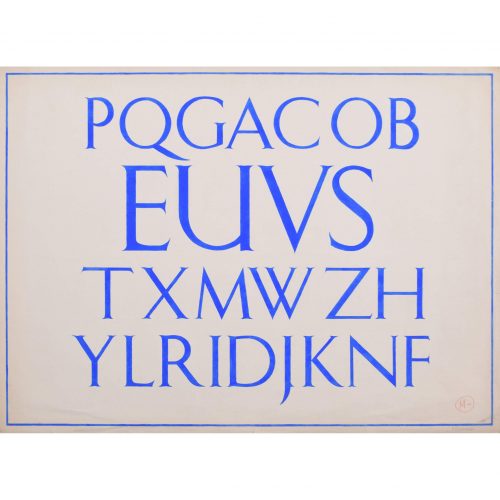
S Clapham (active 1940 - 1960)
Lettering Design
Watercolour 53 x 75 cm Examiner's mark 'M-' (likely 'lower merit') lower right within border. Signed lower right without border in pencil. A trainee architect's lettering design. It was crucial that an architectural draughtsman be skilled in depicting lettering which might appear on a building commission, and here is one of Clapham's stylish efforts, marked by an examiner. Condition: generally good, a few repaired very short edge tears not into image, with examiner's mark to bottom right. If you are interested, please email info@manningfineart.co.uk or call us on 07929 749056. Click here for other works by the artist. -
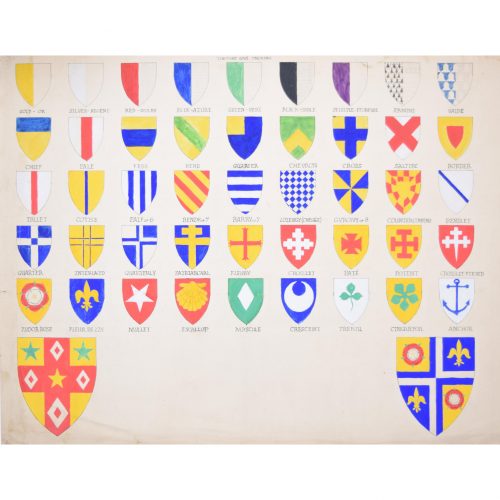
S Clapham (active 1940 - 1960)
A Heraldic Primer
Gouache and pencil 53 x 67 cm A delightful, brightly-coloured study of the various elements of heraldic shields. Condition: good; a few short and neatly-repaired marginal tears. If you are interested, please email info@manningfineart.co.uk or call us on 07929 749056. Click here for other works by the artist. -
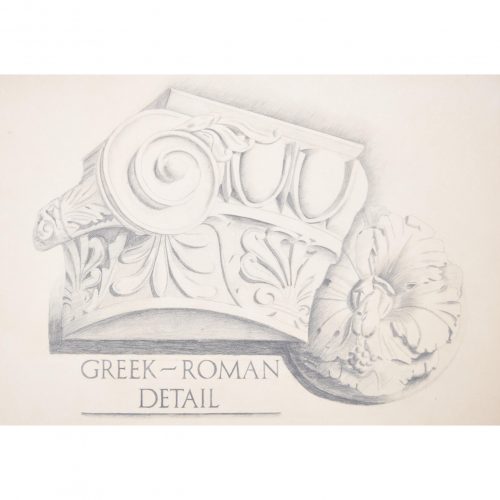
S Clapham (active 1940 - 1960)
Greek Roman Detail
Pencil 51 x 72 cm A mid-century design for a column in the neoclassical style. Clapham was an architect based in Stockwell in London. Condition: very good; mounted to board. Slight even age toning to paper. If you are interested, please email info@manningfineart.co.uk or call us on 07929 749056. Click here for other works by the artist. -
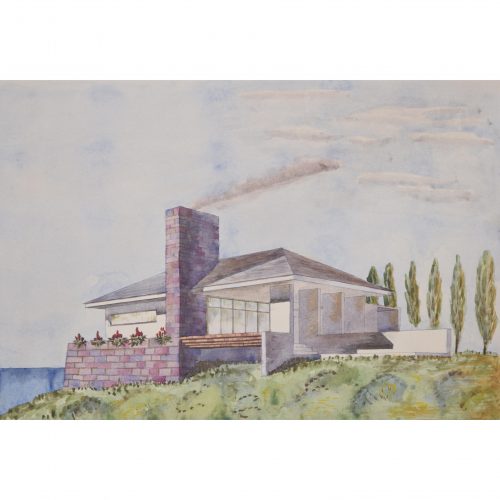
S Clapham (active 1940 - 1960)
Design for Modernist Seaside House
Watercolour 27 x 40 cm Signed lower left and inscribed to reverse. Clapham's designs for a modernist war memorial to be erected in a training area at an army base. Clapham was an architect based in Stockwell in London. Condition: very good. If you are interested, please email info@manningfineart.co.uk or call us on 07929 749056. Click here for other works by the artist. -
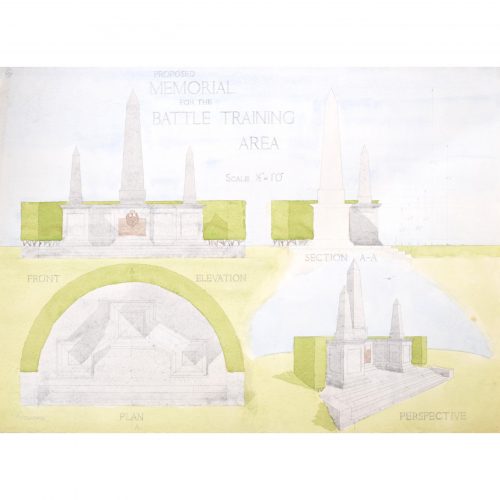
S Clapham (active 1940 - 1960)
Proposed Memorial for the Battle Training Area
Pencil wash 49 x 70 cm Signed lower left and inscribed to reverse. Clapham's designs for a modernist war memorial to be erected in a training area at an army base. Clapham was an architect based in Stockwell in London. Condition: generally very good; one small mark to far right towards bottom. If you are interested, please email info@manningfineart.co.uk or call us on 07929 749056. Click here for other works by the artist. -
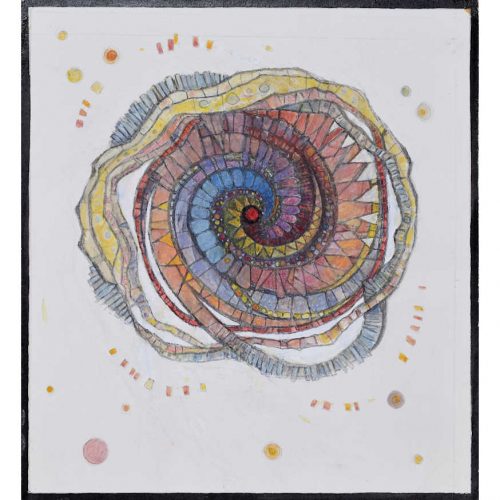
Jane Gray (b.1931)
Applique Stained Glass Window Design
Watercolour18 x 16 cm
Studio label versoIn this stained glass design, Gray uses the appliqué method to construct a highly colourful, abstract, swirling image, typical of many of her more modern works. Gray uses the same technique as in other works of hers where a sense of the transcendental is married with modern abstraction, the viewer’s gaze hypnotically pulled in to the central red dot.
Provenance: the artist’s studio sale. Condition: very good. If you are interested, please email info@manningfineart.co.uk or call us on 07929 749056. For other works by Jane Gray and more information about her, please click here. -
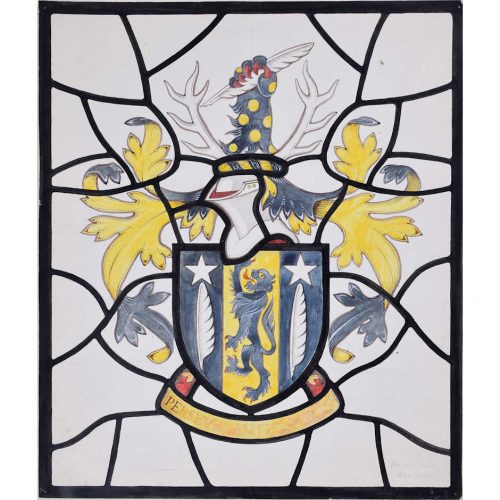
Jane Gray (b.1931)
Gilmour Coat of Arms, Stained Glass Window Design
Watercolour38.5 x 32.5 cm
Signed versoThe Gilmours are part of clan Morrison of the Isle of Lewis, and the first documented bearer of this surname was Richard Gilemore, who was recorded in the Feet of Fines of Huntindonshire in 1228 AD. The family mottoes include, as Gray uses here, Perseveranti dabitur, meaning ‘It will be given to the persevering’.
Provenance: the artist’s studio sale. Condition: very good. If you are interested, please email info@manningfineart.co.uk or call us on 07929 749056. For other works by Jane Gray and more information about her, please click here. -
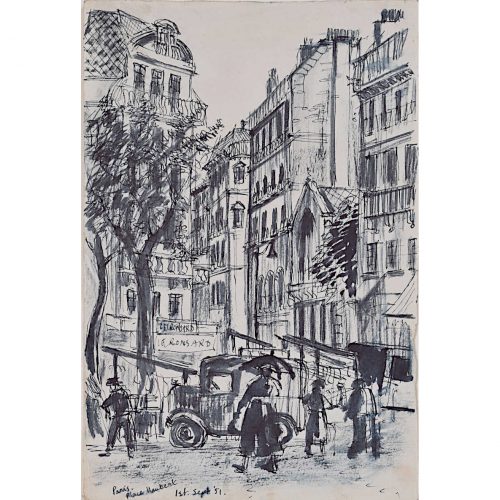
Jane Gray (b.1931)
Place Maubert, Paris (1951)
Ink on paper24.5 x 15.5 cm
Dated.This adolescent urban sketch of Paris depicts, as Gray notes next to her signature, Place Maubert, and shows Gray to be an observant and sensitive draughtsman. Lying in the 5th Arrondissement of Paris, the Place Maubert has a rich history, once used for debates and academics, and a famed site for religious pilgrimages, today it plays host to a popular open air market.
Provenance: the artist’s studio sale. Condition: very good. If you are interested, please email info@manningfineart.co.uk or call us on 07929 749056. For other works by Jane Gray and more information about her, please click here. -
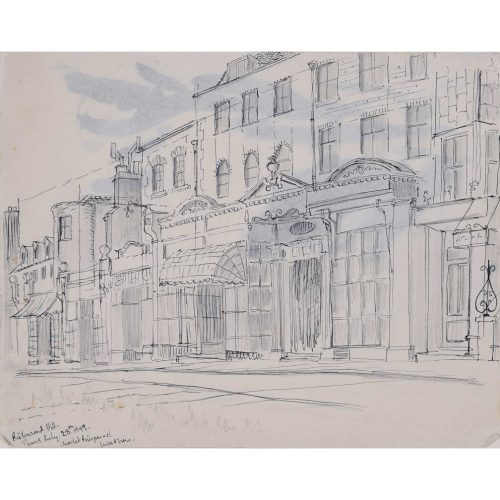
Jane Gray (b.1931)
The Scarlet Pimpernel’s Home, Richmond Hill (1949)
Ink and pencil on paper 25.5 x 20 cm Dated.This adolescent urban sketch of Richmond Hill depicts, as Gray notes next to her signature, Richmond House, the home of Baroness Orczy’s eponymous hero, Sir Percy (the Scarlet Pimpernel), and shows Gray to be an observant and sensitive draughtsman. In Orczy’s novel, Sir Percy rechristens Richmond House as Blakeney Manor and it quickly rises to the centre of fashionable society.
Provenance: the artist’s studio sale. Condition: very good. If you are interested, please email info@manningfineart.co.uk or call us on 07929 749056. For other works by Jane Gray and more information about her, please click here. -
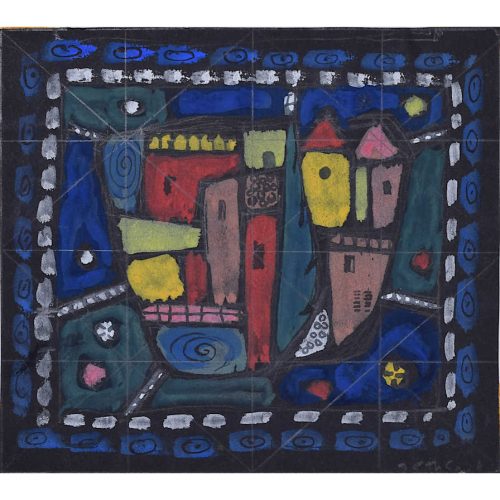
Jane Gray (b.1931)
Mosaic Design
Watercolour 11 x 12.5 cmThis highly modern, colourful and geometric stained mosaic design demonstrates Gray’s wide artistic range and love of employing colour and linear shapes in her work. The central image appears to depict a hamlet-like cluster of abstract houses surrounded by squares of field-like green.
Provenance: the artist’s studio sale. Condition: very good. If you are interested, please email info@manningfineart.co.uk or call us on 07929 749056. For other works by Jane Gray and more information about her, please click here. -
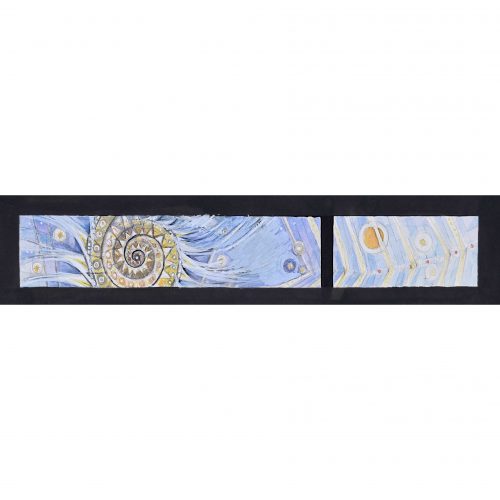
Jane Gray (b.1931)
Stained Glass Window Design
Watercolour 3 x 22.5 cmThis design for a two part stained glass window has an almost transcendental quality, the central spiralling structure hypnotically drawing the viewer’s gaze inwards. The design perfectly marries Gray’s spiritual and more abstract, secular works across her career.
Provenance: the artist’s studio sale. Condition: very good. If you are interested, please email info@manningfineart.co.uk or call us on 07929 749056. For other works by Jane Gray and more information about her, please click here. -
Out of stock
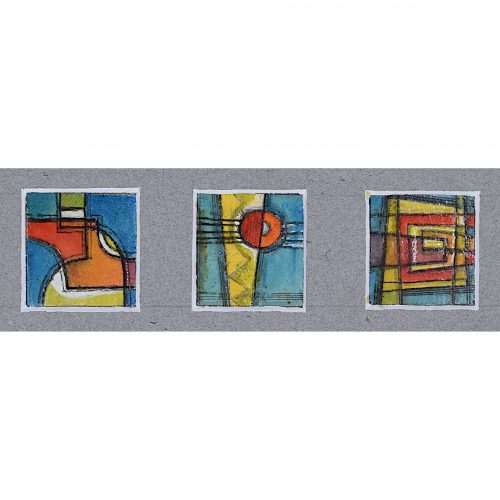
Jane Gray (b.1931)
Geometric Stained Glass Window Designs
Watercolour 18 x 4.5 cmThis triptych of highly modern, colourful and geometric stained glass designs demonstrates Gray’s wide artistic range and love of colour and shapes. The three unique panels are united in their colourful palette and geometric focus but present strong stand alone designs.
Provenance: the artist’s studio sale. Condition: very good. If you are interested, please email info@manningfineart.co.uk or call us on 07929 749056. For other works by Jane Gray and more information about her, please click here. -
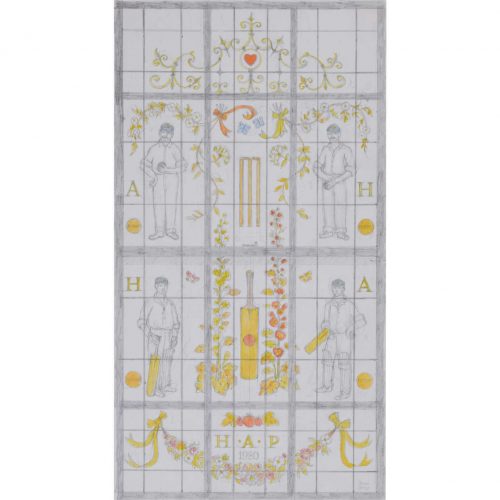
Jane Gray (b.1931)
Stained Glass Window Design for Harold Pinter and Antonia Fraser (1980)
Watercolour and pencil 30.5 x 16 cmSigned lower right corner. Dated on backboard.
Harold Pinter and Antonia Fraser married in London in November 1980, five years after they first met, and only a few months after Gray commenced designing this impressive stained glass window for their house at 52 Campden Hill Square in London. Her notes surrounding the design give insights into her process and the themes and imagery she wished the design to contain such as: Harold and Antonia’s initials, cricket, hollyhocks, butterflies, medallions of test matches.
Provenance: the artist’s studio sale. Condition: very good. If you are interested, please email info@manningfineart.co.uk or call us on 07929 749056. For other works by Jane Gray and more information about her, please click here. -
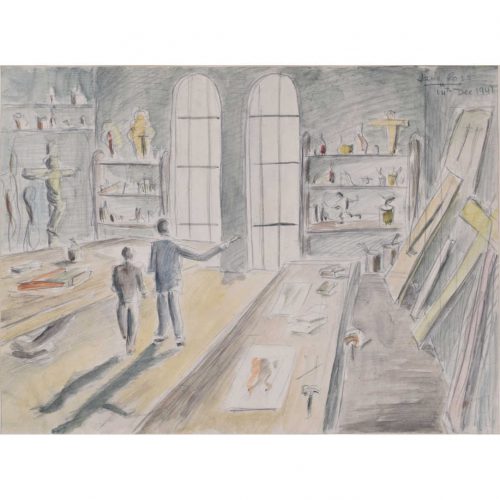
Jane Gray (b.1931)
The Artist's Studio (1947)
Watercolour 38 x 27.5 cmSigned (Jane Ross) and dated top right corner. Prize labels verso.
This rare, early watercolour interior of an artist’s studio by Gray, then Ross, was submitted to the Royal Drawing Society’s Exhibition Competition when Gray was only sixteen years old. Demonstrating fine draughtsmanship and a keen understanding of space, light and form, it is no surprise that the picture received a First Class Commendation.
Provenance: the artist’s studio sale. Condition: very good. If you are interested, please email info@manningfineart.co.uk or call us on 07929 749056. For other works by Jane Gray and more information about her, please click here. -
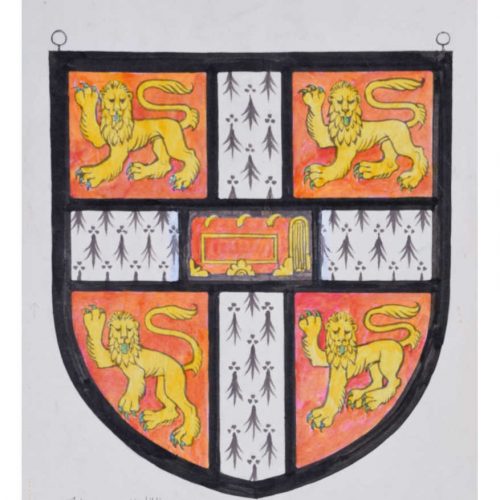
Jane Gray (b.1931)
Arms of University of Cambridge Design for Stained Glass Window
Watercolour 23 x 21 cm Detailed in artist's handThe University of Cambridge is one of the world’s oldest universities, with groups of scholars first congregating at the ancient Roman trading post of Cambridge for the purpose of study in 1209, the first college (Peterhouse) being founded in 1284. The university was granted its arms some years later in 1573 by Robert Cooke, Clarenceux King of Arms and a graduate of St. John's College. The granted arms are described in heraldic terminology, or blazon, as follows: Gules on a Cross Ermine between four Lions passant guardant Or a Bible fesswise Gules clasped and garnished Or the clasps in base.
Provenance: the artist’s studio sale. Condition: very good. If you are interested, please email info@manningfineart.co.uk or call us on 07929 749056. For other works by Jane Gray and more information about her, please click here. -
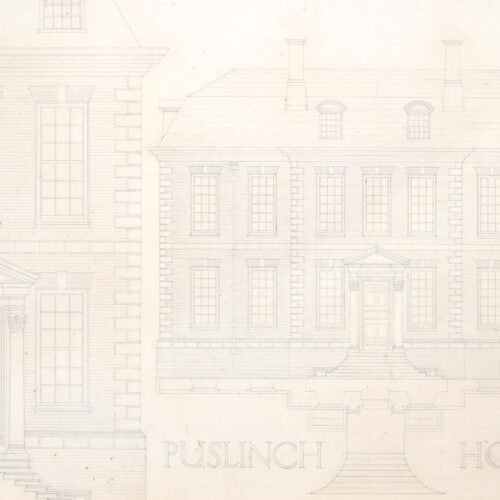
S Clapham (active 1940 - 1960)
Puslinch House
Pencil 55 x 77 cm An architectural drawing of Puslinch House, a fine Christopher Wren-style Georgian mansion in Devon. The estate was owned by the Poslylinch, Mohun, and Upton families before being taken over by the Yonge family in 1718, following the marriage of John Yonge and Mary Upton. The Queen Anne House mansion was built on the occasion of their wedding and an earlier mediaeval house still exists in the grounds as a country cottage. During the war, the house was used as a voluntary hospital for wounded officers. Clapham was an architect based in Stockwell in London. Condition: generally good; a little spotting, backed to board by artist and signed to board lower right. If you are interested, please email info@manningfineart.co.uk or call us on 07929 749056. Click here for other works by the artist. -
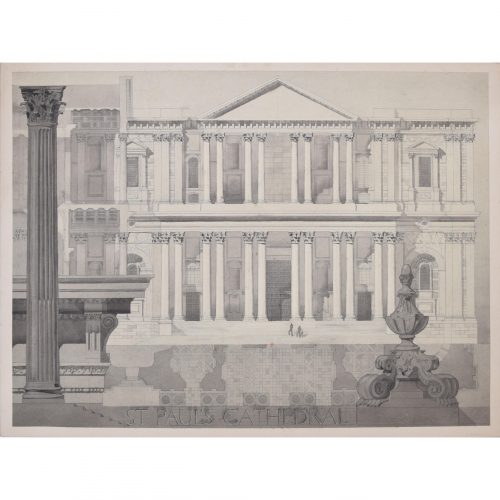
S Clapham (active 1940 - 1960)
St Paul's Cathedral
Watercolour 51 x 68 cm Signed lower right. This architectural watercolour is a panegyric to the English Baroque grandeur of St Paul's Cathedral. Three small figures climb the steps, emphasising the size and magnificence of the architecture around them. St Paul's was built between 1675 and 1711 by Sir Christopher Wren. The foundation stone was laid in 1675 when Wren was 43 years old, and the building works were completed 35 years later by Wren's son. Its construction was part of a major rebuilding programme in the city after the Great Fire of London. Clapham was an architect based in Stockwell in London. Condition: generally very good; a couple of spots. Mounted to board by artist and signed to board. If you are interested, please email info@manningfineart.co.uk or call us on 07929 749056. Click here for other works by the artist. -
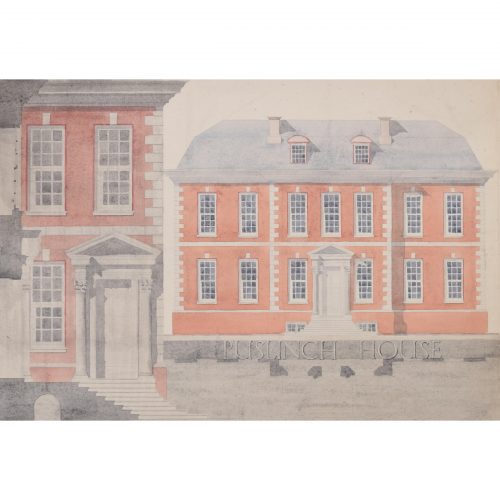
S Clapham (active 1940 - 1960)
Puslinch House
Watercolour 49 x 70 cm A beautifully-coloured watercolour of Puslinch House, a fine Christopher Wren-style Georgian mansion in Devon. The estate was owned by the Poslylinch, Mohun, and Upton families before being taken over by the Yonge family in 1718, following the marriage of John Yonge and Mary Upton. The Queen Anne House mansion was built on the occasion of their wedding and an earlier mediaeval house still exists in the grounds as a country cottage. During the war, the house was used as a voluntary hospital for wounded officers. Clapham was an architect based in Stockwell in London. Condition: generally very good; a little faint spotting to top right corner. If you are interested, please email info@manningfineart.co.uk or call us on 07929 749056. Click here for other works by the artist. -
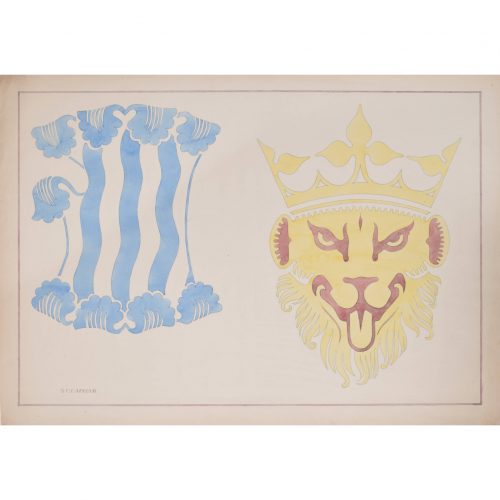
S Clapham (active 1940 - 1960)
A Pair of Heraldic Designs
Watercolour 49 x 70 cm Signed lower right. Clapham was an architect based in Stockwell in London. Condition: generally very good; short repaired edge tear (barely visible) to left side. If you are interested, please email info@manningfineart.co.uk or call us on 07929 749056. Click here for other works by the artist. -
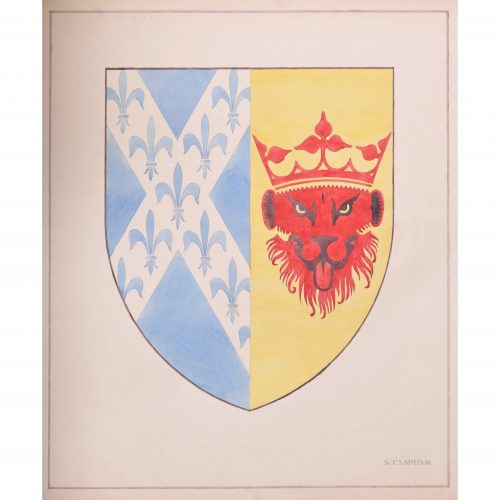
S Clapham (active 1940 - 1960)
Heraldic Design
Watercolour 51 x43 cm Signed lower right. Clapham was an architect based in Stockwell in London. Condition: very good. If you are interested, please email info@manningfineart.co.uk or call us on 07929 749056. Click here for other works by the artist. -
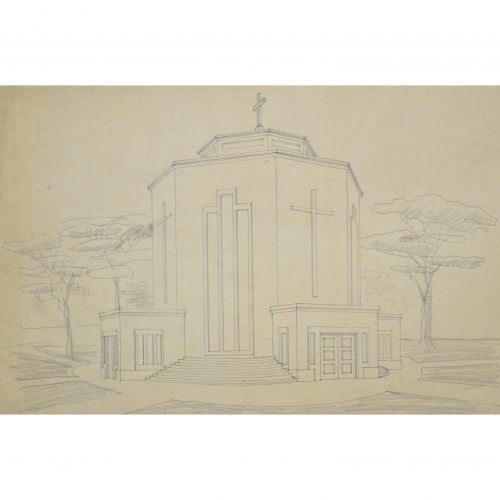
S Clapham (active 1940 - 1960)
A Modernist Church
Pencil 29 x 43 cm A design for an octagonal church in the modernist mid-century style. Clapham was an architect based in Stockwell in London. Condition: generally very good. If you are interested, please email info@manningfineart.co.uk or call us on 07929 749056. Click here for other works by the artist. -
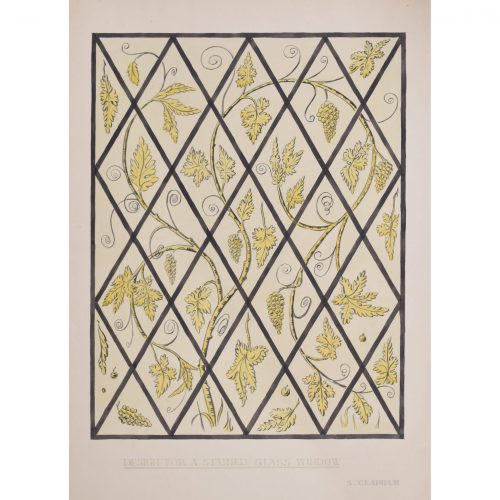
S Clapham (active 1940 - 1960)
Designs for a Stained Glass Window
Watercolour 71 x 56 cm Signed lower right. A beautiful stained glass window design in the medievalist Arts and Crafts style popularised by William Morris in the 1890s. Clapham was an architect based in Stockwell in London. Condition: very good. If you are interested, please email info@manningfineart.co.uk or call us on 07929 749056. Click here for other works by the artist. -
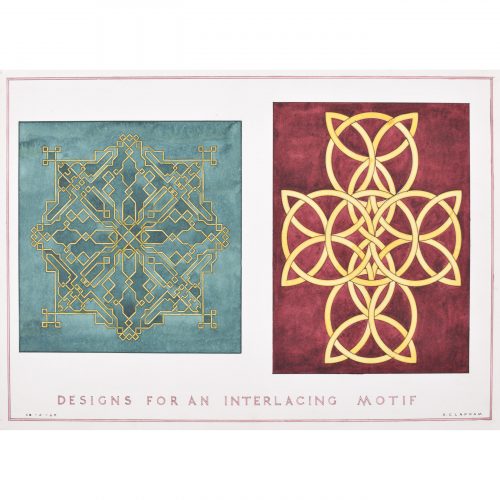
S Clapham (active 1940 - 1960)
Designs for an Interlacing Motif (1949)
Watercolour 37 x 52 cm Dated 26-2-1949 and signed. Clapham was an architect based in Stockwell in London. Condition: very good. If you are interested, please email info@manningfineart.co.uk or call us on 07929 749056. Click here for other works by the artist. -
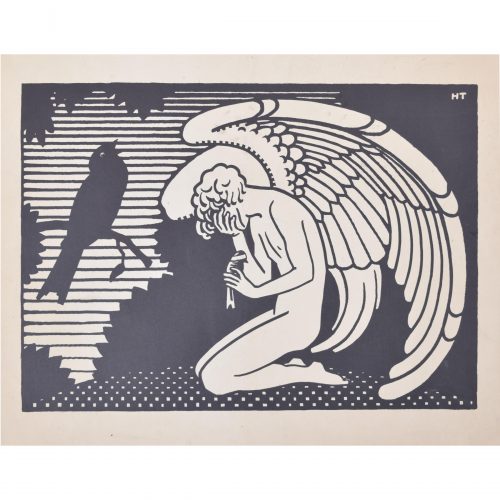
"HT"
Raven and Angel
Block print 28 x 41 cm Signed 'HT' upper right in the plate. A monochrome print of an angel holding a bird - usually a symbol of peace or prophecy. The birds here are black, however, rather than the more typical white dove, and the bird held by the weeping angel seems to be injured. Condition: generally very good; vertical crease to centre; even overall slight toning to paper. If you are interested, please email info@manningfineart.co.uk or call us on 07929 749056. -
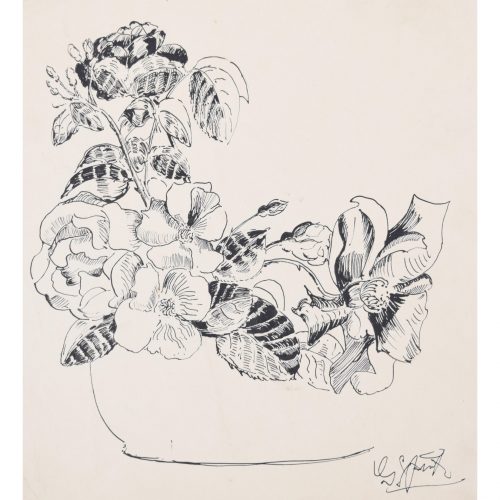
Gerald Mac Spink (flourished 1920 - 1940)
Flowers
Pen and ink 15 x 23 cm Signed 'G Spink' lower right. Spink was a skilled artist, illustrator, and designer who produced a series of posters in the inter-war period for companies including the London Underground, Southern Railways, LNER, Hawker Engineering, and British Steel. He won a prize in 1933 from the Imperial Institute for his poster artwork. He also worked as an aeronautical engineer in Kingston-on-Thames for Hawker Engineering; his greatest achievement was the creation of the 'Squanderbug', a 500cc racing car which he built in 1947, and which races even to this day. Provenance: the artist's estate. Condition: generally very good. If you are interested, please email info@manningfineart.co.uk or call us on 07929 749056. Click here for other works by the artist. -
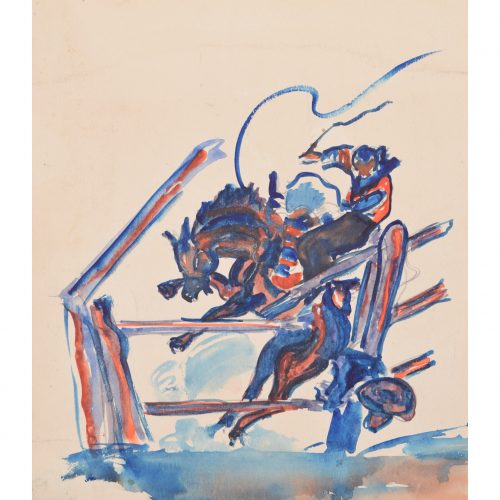
Gerald Mac Spink (flourished 1920 - 1940)
Rodeo
Watercolour 15 x 23 cm Stallion bucking and whip cracking, a cowboy loses his hat. A depiction of the magnificent chapel at Kelham Hall, a sumptuous Gothic Revival Victorian country house designed by George Gilbert Scott. The artist highlights the soaring, cavernous proportions of the chapel and the delicate beauty of its focal point: a raised crucifix which also acts as an altar screen. There have been three halls at Kelham over the centuries, all built by the Manners Sutton family, whose links with Nottinghamshire go back to the 12th century. The first Kelham Hall was built shortly after the end of the Civil War for Robert Sutton, 1st Lord Lexington. It was destroyed by fire in 1728 and rebuilt for Bridget, the Duchess of Rutland, the daughter of the 2nd Lord Lexington. Bridget Sutton had married John Manners, the 3rd Duke of Rutland. Today's Kelham Hall was built by the revered Victorian architect Sir George Gilbert Scott after the second Hall was destroyed by fire in 1857. Between 1903 and 1973 the hall was used an Anglican theological college for the Society of the Sacred Mission, which built the domed chapel in 1928. The Hall is now a sought-after wedding venue. Spink was a skilled artist, illustrator, and designer who produced a series of posters in the inter-war period for companies including the London Underground, Southern Railways, LNER, Hawker Engineering, and British Steel. He won a prize in 1933 from the Imperial Institute for his poster artwork. He also worked as an aeronautical engineer in Kingston-on-Thames for Hawker Engineering; his greatest achievement was the creation of the 'Squanderbug', a 500cc racing car which he built in 1947, and which races even to this day. Provenance: the artist's estate. Condition: generally very good. If you are interested, please email info@manningfineart.co.uk or call us on 07929 749056. Click here for other works by the artist. -
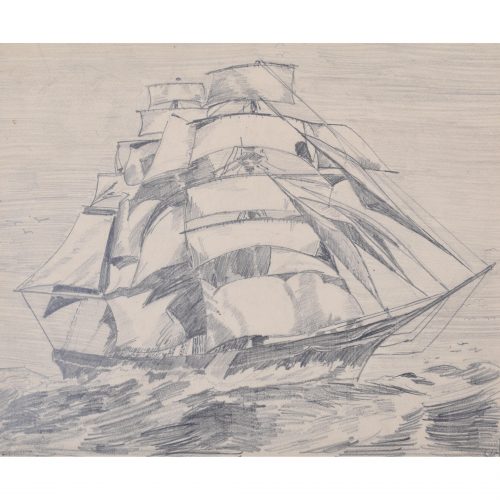
Gerald Mac Spink (flourished 1920 - 1940)
Sailing ship
Pencil 31 x 38 cm A stormy sea and the wind in her sails. Spink was a skilled artist, illustrator, and designer who produced a series of posters in the inter-war period for companies including the London Underground, Southern Railways, LNER, Hawker Engineering, and British Steel. He won a prize in 1933 from the Imperial Institute for his poster artwork. He also worked as an aeronautical engineer in Kingston-on-Thames for Hawker Engineering; his greatest achievement was the creation of the 'Squanderbug', a 500cc racing car which he built in 1947, and which races even to this day. Provenance: the artist's estate. Condition: generally very good. If you are interested, please email info@manningfineart.co.uk or call us on 07929 749056. Click here for other works by the artist. -
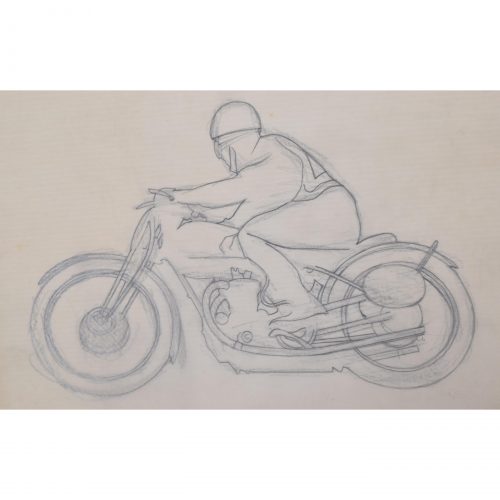
Gerald Mac Spink (flourished 1920 - 1940)
Motorcyclist
Pencil on tracing paper 20 x 32 cm Spink was a skilled artist, illustrator, and designer who produced a series of posters in the inter-war period for companies including the London Underground, Southern Railways, LNER, Hawker Engineering, and British Steel. He won a prize in 1933 from the Imperial Institute for his poster artwork. He also worked as an aeronautical engineer in Kingston-on-Thames for Hawker Engineering; his greatest achievement was the creation of the 'Squanderbug', a 500cc racing car which he built in 1947, and which races even to this day. Provenance: the artist's estate. Condition: generally very good. If you are interested, please email info@manningfineart.co.uk or call us on 07929 749056. Click here for other works by the artist. -
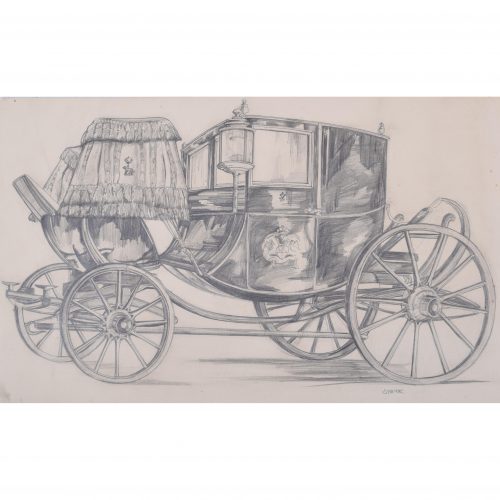
Gerald Mac Spink (flourished 1920 - 1940)
Stagecoach
Pencil 32 x 53 cm Signed 'Spink' lower right. Spink was a skilled artist, illustrator, and designer who produced a series of posters in the inter-war period for companies including the London Underground, Southern Railways, LNER, Hawker Engineering, and British Steel. He won a prize in 1933 from the Imperial Institute for his poster artwork. He also worked as an aeronautical engineer in Kingston-on-Thames for Hawker Engineering; his greatest achievement was the creation of the 'Squanderbug', a 500cc racing car which he built in 1947, and which races even to this day. Provenance: the artist's estate. Condition: generally very good. If you are interested, please email info@manningfineart.co.uk or call us on 07929 749056. Click here for other works by the artist. -
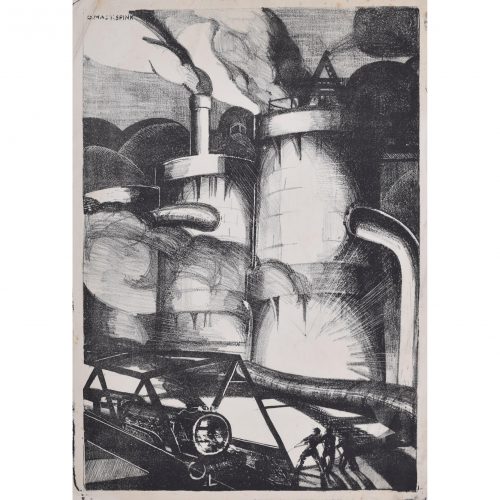
Gerald Mac Spink (flourished 1920 - 1940)
Industrial Scene with Steam Locomotive
Block print 50 x 34 cm Signed 'G Mac Spink' in plate (in reverse) upper left. A beautifully-rendered, almost futurist industrial scene depicting a steam-powered locomotive. The metals of industry dwarf the men working below them, white with heat in chiaroscuro contrast to the dark shadows in the fore- and background of the print. Spink was a skilled artist, illustrator, and designer who produced a series of posters in the inter-war period for companies including the London Underground, Southern Railways, LNER, Hawker Engineering, and British Steel. He won a prize in 1933 from the Imperial Institute for his poster artwork. He also worked as an aeronautical engineer in Kingston-on-Thames for Hawker Engineering; his greatest achievement was the creation of the 'Squanderbug', a 500cc racing car which he built in 1947, and which races even to this day. Provenance: the artist's estate. Condition: generally very good; a few gentle handling creases; three little spots within image. If you are interested, please email info@manningfineart.co.uk or call us on 07929 749056. Click here for other works by the artist. -
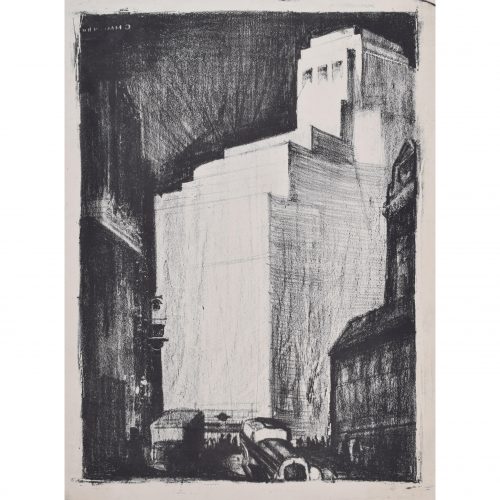
Gerald Mac Spink (flourished 1920 - 1940)
Art Deco City Scene with Engine Car
Block print 41 x 29 cm Signed 'G Mac Spink' in plate (in reverse) upper left. "Over the great bridge, with the sunlight through the girders making a constant flicker upon the moving cars, with the city rising up across the river in white heaps..." - F Scott Fitzgerald, The Great Gatsby An Art Deco city with 1920s engine-cars in the foreground. A white tower-block rises up, emerging palely from a chiaroscuro darkness, a great edifice above the tiny pedestrians below. Spink was a skilled artist, illustrator, and designer who produced a series of posters in the inter-war period for companies including the London Underground, Southern Railways, LNER, Hawker Engineering, and British Steel. He won a prize in 1933 from the Imperial Institute for his poster artwork. He also worked as an aeronautical engineer in Kingston-on-Thames for Hawker Engineering; his greatest achievement was the creation of the 'Squanderbug', a 500cc racing car which he built in 1947, and which races even to this day. Provenance: the artist's estate. Condition: very good. If you are interested, please email info@manningfineart.co.uk or call us on 07929 749056. Click here for other works by the artist. -
Out of stock
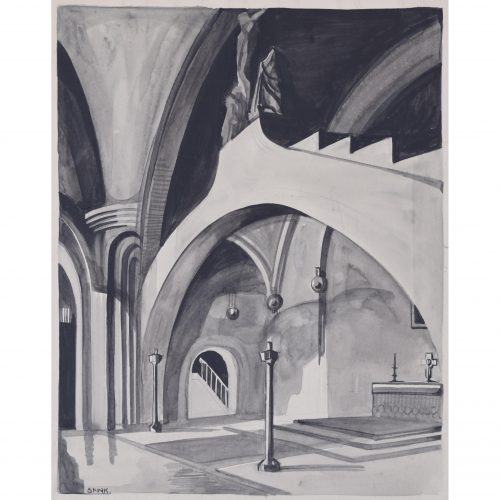
Gerald Mac Spink (flourished 1920 - 1940)
Kelham Hall Chapel II
Watercolour 29 x 24 cm Signed 'G Spink' lower left. A depiction of the magnificent chapel at Kelham Hall, a sumptuous Gothic Revival Victorian country house designed by George Gilbert Scott. The artist highlights the soaring, cavernous proportions of the chapel and the delicate beauty of its focal point: a raised crucifix which also acts as an altar screen. There have been three halls at Kelham over the centuries, all built by the Manners Sutton family, whose links with Nottinghamshire go back to the 12th century. The first Kelham Hall was built shortly after the end of the Civil War for Robert Sutton, 1st Lord Lexington. It was destroyed by fire in 1728 and rebuilt for Bridget, the Duchess of Rutland, the daughter of the 2nd Lord Lexington. Bridget Sutton had married John Manners, the 3rd Duke of Rutland. Today's Kelham Hall was built by the revered Victorian architect Sir George Gilbert Scott after the second Hall was destroyed by fire in 1857. Between 1903 and 1973 the hall was used an Anglican theological college for the Society of the Sacred Mission, which built the domed chapel in 1928. The Hall is now a sought-after wedding venue. Spink was a skilled artist, illustrator, and designer who produced a series of posters in the inter-war period for companies including the London Underground, Southern Railways, LNER, Hawker Engineering, and British Steel. He won a prize in 1933 from the Imperial Institute for his poster artwork. He also worked as an aeronautical engineer in Kingston-on-Thames for Hawker Engineering; his greatest achievement was the creation of the 'Squanderbug', a 500cc racing car which he built in 1947, and which races even to this day. Provenance: the artist's estate. Condition: very good. If you are interested, please email info@manningfineart.co.uk or call us on 07929 749056. Click here for other architectural views. -
Out of stock
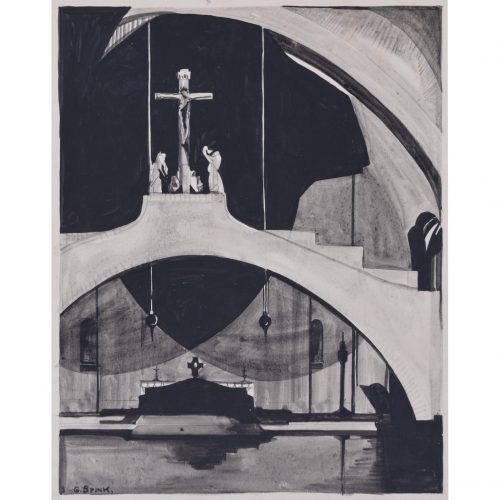
Gerald Mac Spink (flourished 1920 - 1940)
Kelham Hall Chapel I
Watercolour 29 x 24 cm Signed 'G Spink' lower left. A depiction of the magnificent chapel at Kelham Hall, a sumptuous Gothic Revival Victorian country house designed by George Gilbert Scott. The artist highlights the soaring, cavernous proportions of the chapel and the delicate beauty of its focal point: a raised crucifix which also acts as an altar screen. There have been three halls at Kelham over the centuries, all built by the Manners Sutton family, whose links with Nottinghamshire go back to the 12th century. The first Kelham Hall was built shortly after the end of the Civil War for Robert Sutton, 1st Lord Lexington. It was destroyed by fire in 1728 and rebuilt for Bridget, the Duchess of Rutland, the daughter of the 2nd Lord Lexington. Bridget Sutton had married John Manners, the 3rd Duke of Rutland. Today's Kelham Hall was built by the revered Victorian architect Sir George Gilbert Scott after the second Hall was destroyed by fire in 1857. Between 1903 and 1973 the hall was used an Anglican theological college for the Society of the Sacred Mission, which built the domed chapel in 1928. The Hall is now a sought-after wedding venue. Spink was a skilled artist, illustrator, and designer who produced a series of posters in the inter-war period for companies including the London Underground, Southern Railways, LNER, Hawker Engineering, and British Steel. He won a prize in 1933 from the Imperial Institute for his poster artwork. He also worked as an aeronautical engineer in Kingston-on-Thames for Hawker Engineering; his greatest achievement was the creation of the 'Squanderbug', a 500cc racing car which he built in 1947, and which races even to this day. Provenance: the artist's estate. Condition: very good. If you are interested, please email info@manningfineart.co.uk or call us on 07929 749056. Click here for other architectural views. -
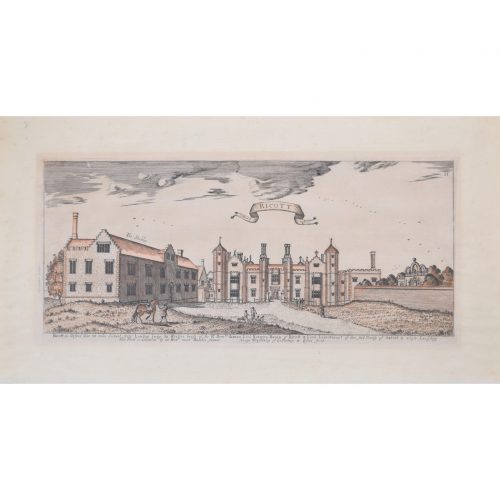
Henry Winstanley (1644 - 1703)
Rycote House, Oxfordshire
Engraving 19 x 44 cm Rycote House, Oxfordshire, was a Tudor (and later Georgian) country house. The house was built in the 16th century, and in 1920, after a period of decline, the extensive stables were converted into the present Rycote House. Condition: generally very good; some age toning. If you are interested, please email info@manningfineart.co.uk or call us on 07929 749056. Click here for other architectural drawings. -
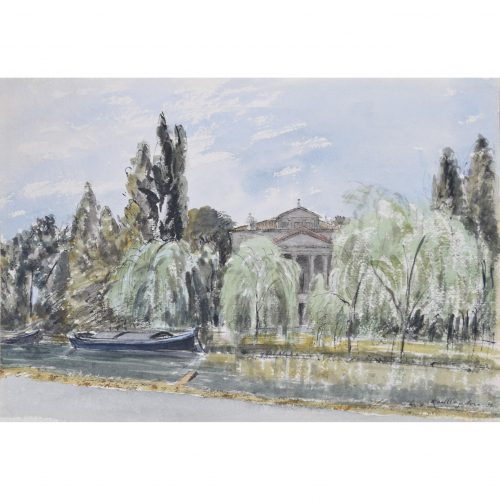
Karl Hagedorn (1889 - 1969)
The Villa Malcontenta, Venice (1958)
Watercolour and ink 33 x 50 cm Signed and dated 1958 lower right (dated August 23rd to reverse). A watercolour of the Villa Malcontenta in Venice, nestled between willow trees. The River Brenta flows serenely in the foreground. Villa Foscari is a patrician villa in Mira, near Venice, northern Italy, designed by the Italian Renaissance architect Andrea Palladio. It is also known as La Malcontenta ("The Discontented"), a nickname which - according to a legend - it received when the spouse of one of the Foscaris was locked up in the house because she allegedly did not live up to her conjugal duty. Karl Hagedorn was a painter and illustrator. He was educated in Berlin, and at the Manchester School of Technology, Manchester School of Art, and Slade School of Fine Art (where he later taught), before training in Paris under Maurice Denis. Hagedorn showed regularly at the Society of Modern Painters in Manchester, and then (from 1913 onwards), at the Royal Academy and the New English Art Club. He became a British citizen in 1914, and served in the British Army during World War I. During World War II, he sold pictures of military subjects to the United Kingdom Government's War Artists' Advisory Committee. He was also commissioned by the Recording Britain project to produce views of Middlesex and Derbyshire. Condition: very good. If you are interested, please email info@manningfineart.co.uk or call us on 07929 749056. Click here for more Modern British painting. -
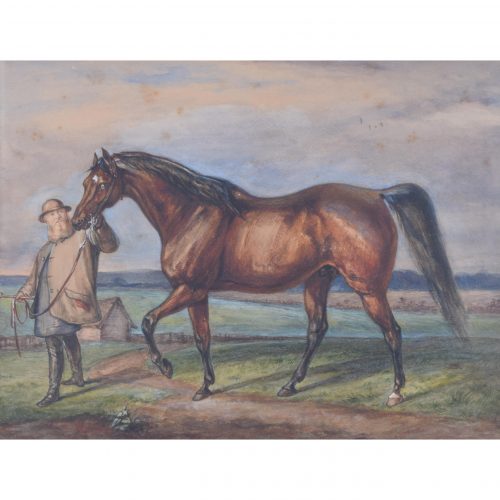
H. Fluiss
Cotherstone with stud groom "Wilson" (1862)
Watercolour 30 x 39 cm A late-nineteenth century watercolour depicting Cotherstone, the British Thoroughbred racehorse and sire. In a career that lasted from September 1841 to July 1843, he ran eleven times and won eight races. Provenance: Christie's South Kensington (2002). Condition: generally very good; couple of faint spots to sky. Frame in "country house" condition. If you are interested, please email info@manningfineart.co.uk or call us on 07929 749056. -
Out of stock
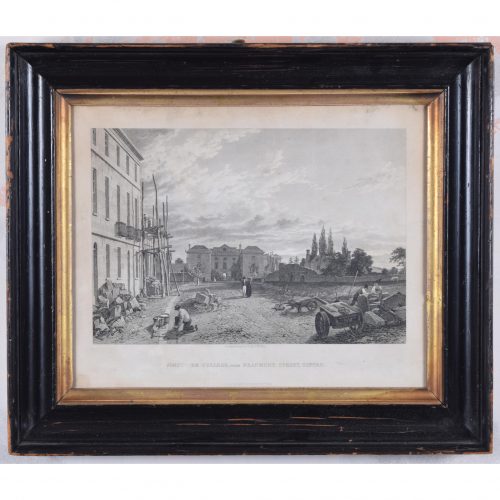
George Hollis (1793 - 1842)
Worcester College Beaumont Street, Oxford (1823)
Engraving 25 x 32 cm A handsome engraving of Worcester College from a Beaumont Street still under construction. The street was laid out in the 1820s and 1830s in the Regency style and acts as a charming approach to Worcester's facade. George Hollis was a well-known Oxford-born artist and engraver. He studied art and worked primarily in Oxford. Many of his engravings, which often depicted the colleges, were published by James Ryman, a print-seller on the High Street. Hollis' views were published separately in a single volume in 1839. Condition: good. Mounted to board; vertical crease; in antique frame. If you are interested, please email info@manningfineart.co.uk or call us on 07929 749056. Click here for other views of Worcester College, Oxford. -
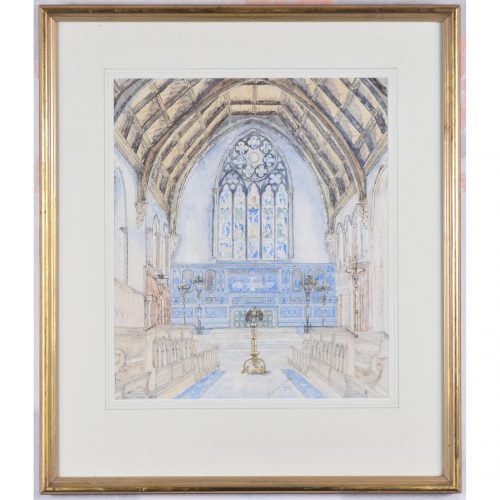
Meadows-Frost (possibly Sir John Meadows Frost [1856 - 1935])
Charterhouse School Chapel
Watercolour 37 x 31 cm Signed 'Meadows-Frost' and dated. A watercolour of Charterhouse's magnificent gothic chapel. Designed by Sir Giles Gilbert Scott, the chapel was consecrated in 1927 as a memorial to nearly 700 Carthusians who died in the Great War. It is the largest war memorial in England. Sir John Meadows Frost was the Mayor of Chester from 1913 to 1918. The following record, likely referring to Sir John's eldest son, also appears in the Charterhouse Register of 1872-1910; this watercolour was executed in 1894. It is likely that one of the family painted it, and any more information as to which individual it was would be gratefully received: "Frost, John Meadows, t). 22 April, 1885: i g. of John Meadows Frost, of Chester; (Girdlestoneites); Left C.Q. 1903. Ch. Ch., Oxf.; B.A. — In firm of Messrs. F. A. Frost & Sons (Millers). tn. 1 910, Olivia, I "U. of Henry Shelmerdine, of Southport. J. M. Frost, Esq., junr., Holmfield, Westminster Park, Chester." Another son, Thomas Laurence Frost, was educated at Charterhouse between between 1901 and 1907, spending 3 years with the Charterhouse Cadet Corps, followed by Clare College, Cambridge. Condition: very good. If you are interested, please email info@manningfineart.co.uk or call us on 07929 749056. -
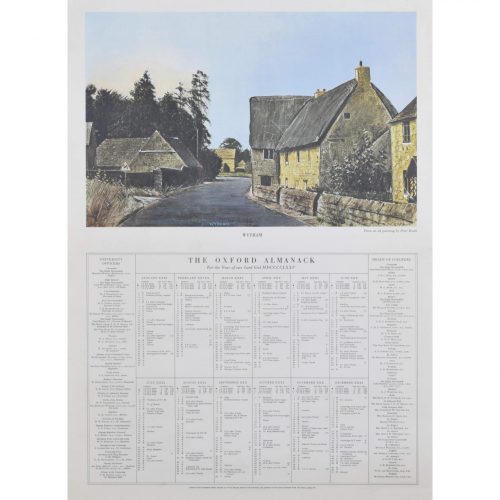
after Peter Brook (1927 - 2009)
Wytham - Oxford Almanack 1975
Lithograph 70 x 48 cm A lithograph of Wytham, a characterful and historic village north-west of Oxford. The original painting hangs in the Ashmolean Museum. Brook's painting was reproduced as a lithograph in 1975 to be published in the "Oxford Almanack". The Oxford Almanack was an annual almanack published by the Oxford University Press for the University of Oxford from 1674 through 2019 (when printing sadly ceased due to "dwindling interest"). The almanack traditionally included engravings or lithographs of the University and information about the upcoming year. Other almanack artists have included James Basire, Michael Burghers, J. M. W. Turner, and Michael Oelman. Peter Brook RBA was an English artist best known for his landscape paintings; he was nicknamed "The Pennine Landscape Painter". He was elected to the Royal Society of British Artists in 1962. Condition: very good. If you are interested, please email info@manningfineart.co.uk or call us on 07929 749056. Click here for other general views of Oxford. -
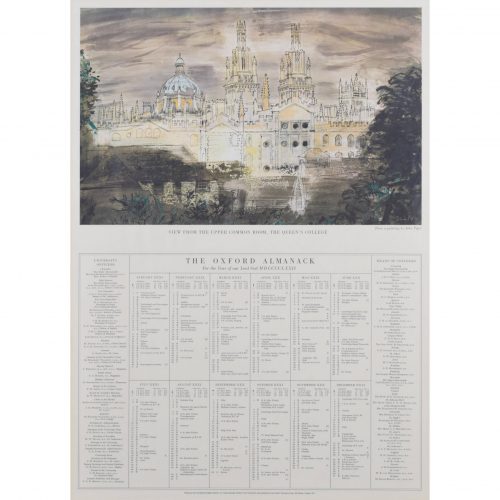
after John Piper (1903 - 1992) View from the Upper Common Room, The Queen's College - Oxford Almanac 1972
Lithograph 68 x 49 cm A lithograph featuring Oxford's skyline, including the towers of All Souls and the Radcliffe Camera, set against a blustery Piper sky. Piper's painting was reproduced as a lithograph in 1972, to be published in the "Oxford Almanack". The Oxford Almanack was an annual almanac published by the Oxford University Press for the University of Oxford from 1674 through 2019 (when printing sadly ceased due to "dwindling interest"). The almanac traditionally included engravings or lithographs of the University and information about the upcoming year. Other almanac artists have included James Basire, Michael Burghers, J. M. W. Turner, and Michael Oelman. John Piper CH was an English painter, printmaker, and designer of stained-glass windows. His work often focused on the British landscape, especially churches and monuments, and included tapestry designs, book jackets, screen-prints, photography, fabrics and ceramics. Condition: very good. If you are interested, please email info@manningfineart.co.uk or call us on 07929 749056. Click here for other views of Queen's College, Oxford. -
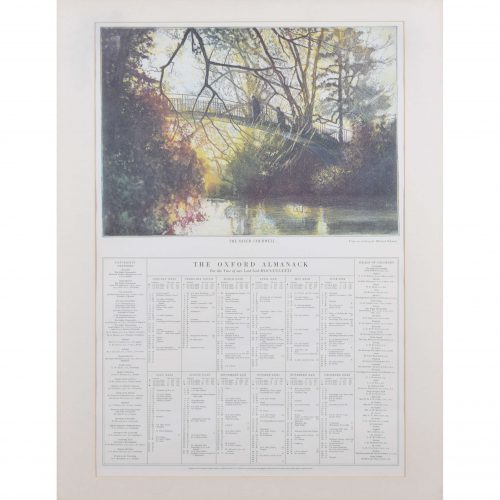
after Michael Oelman (born 1941)
The River Cherwell, The Oxford Almanac 1981
Lithograph 71 x 47 cm A lithograph featuring Oxford's wondrous River Cherwell in University Parks, after an etching by Michael Oelman. A setting sun casts its gold light over the glassy surface of the river and its surrounding trees; two figures cross the Cherwell via the famous Rainbow Bridge. The curved footbridge was built in the early 1920s by the University a project for the unemployed. Oelman's etching was reproduced as a lithograph in 1981, to be published in the "Oxford Almanack". The Oxford Almanack was an annual almanac published by the Oxford University Press for the University of Oxford from 1674 through 2019 (when printing sadly ceased due to "dwindling interest"). The almanac traditionally included engravings or lithographs of the University and information about the upcoming year. Other almanac artists have included James Basire, Michael Burghers, J. M. W. Turner, and John Piper. Michael Oelman was born in Llandudno, Wales, in 1941. He studied fine art at Reading University and then etching and lithography at the Central and Slade Schools of Art. In the 1960s he studied with S. W. Hayter in Paris, and then became a lecturer in Printmaking at Doncaster College of Art, Yorkshire. His studio is in Suffolk. Condition: very good. If you are interested, please email info@manningfineart.co.uk or call us on 07929 749056. Click here for other general views of Oxford. -
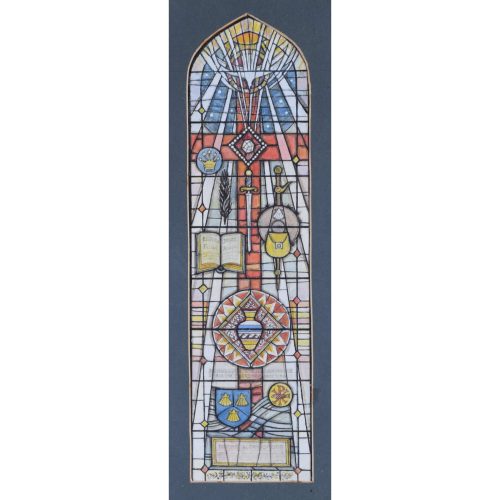
Jane Gray (b.1931)
St James, Temple Sowerby, Cumbria, Design for Stained Glass Window (1978)
Watercolour 30 x 12 cm Signed and dated verso.St James’ Church in Temple Sowerby, Cumbria was built in 1754, and enlarged in 1770, the west tower being added in 1807. In his 1831 work, A Topographical Dictionary of England, Samuel Lewis described the church as ‘a handsome structure of red freestone, with a square tower and portico’.
Provenance: the artist’s studio sale. Condition: very good. If you are interested, please email info@manningfineart.co.uk or call us on 07929 749056. For other works by Jane Gray and more information about her, please click here. -
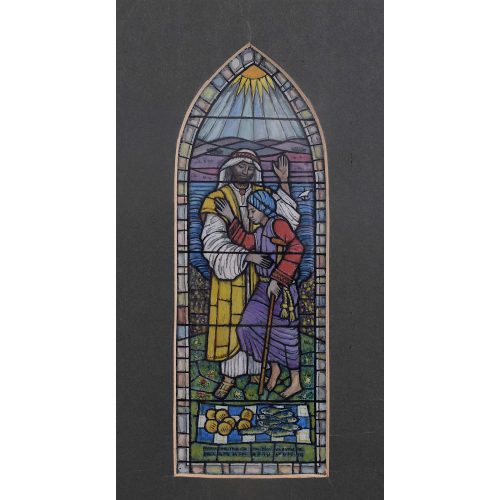
Jane Gray (b.1931)
St Anne’s Church, Copp, Great Eccleston, Design for Stained Glass Window (1979)
Watercolour 19 x 6.5 cm Studio label verso.A chapel was first built at Copp in 1723 for the members of St. Michaels on Wyre Church and Kirkham Church who were too far from their parish churches. Elswick Chapel would have been ideal for the purpose, but as it was in the hands of dissenters the bishop of the time, Bishop Gastrall, decided a new building would be preferable. On May 13th, 1723, a deed was drawn up arranging for three men to rent a piece of land (known as Higher Cop) for one peppercorn a year to build a new chapel. St. Anne's Chapel was built that same year. It wasn’t until 1849, however, that Copp Parish was formed by an Order in Council at Queen Victoria's court at Windsor. The church was completely restored in 1884, the outside transformed by building over it in Yorkshire stone, and the tower raised to 45ft. This window design centres on the scene of Christ healing a lame man and features symbolic images of loaves and fishes. The window was installed in 1979.
Provenance: the artist’s studio sale. Literature: Jane Gray, Playing with Rainbows. (Shropshire: Ellingham Press, 2011), p.75. Condition: very good. If you are interested, please email info@manningfineart.co.uk or call us on 07929 749056. For other works by Jane Gray and more information about her, please click here. -
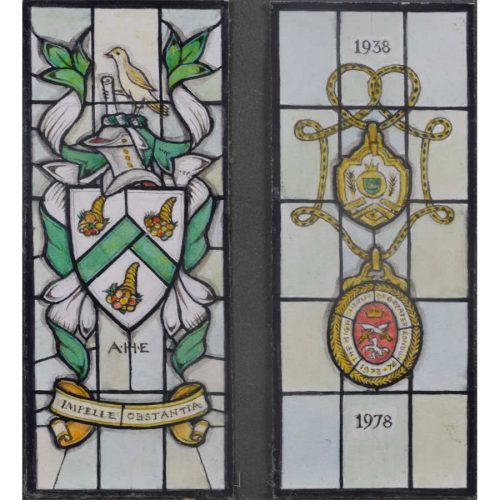
Jane Gray (b.1931)
Design for Stained Glass Panel in a Private House (1978)
Watercolour 10 x 8 cm Signed and dated verso.This design is for a window commemorating Arthur Henry Edmond Esq., of Ranelagh, 50 Russell Road, Moor Park, Northwood, Middlesex, who held the position of High Sheriff of Greater London between 1973-4. The Clan from whom the Arthurs family descends began among the ancient Dalriadan kingdom of the west coast of Scotland. Their name comes from the Celtic personal name, Arthur, which is of various and often disputed etymology. The personal name Arthur may be derived from some early cognate of the Gaelic “art” and the Welsh “arth”, meaning “bear” and may indicate early Celtic worship of the bear or one who has a high regard for the bear’s virtuous qualities. The Latin motto, ‘Impelle obstantia’ (meaning, 'Thrust aside obstacles’) would originally have acted a war cry or slogan. Mottoes first appeared in coast of arms in the 14th and 15th centuries, but were not in general use until the 17th century. The office of High Sheriff of Greater London was created in 1965 and granted armorial bearings 1966. The blazon of the arms, as depicted here is: ‘Gules, two seaxes in saltire argent, pommels and hilts or, between in chief a Saxon Crown or and in base a horse courant argent’.
Provenance: the artist’s studio sale. Condition: very good. If you are interested, please email info@manningfineart.co.uk or call us on 07929 749056. For other works by Jane Gray and more information about her, please click here. -
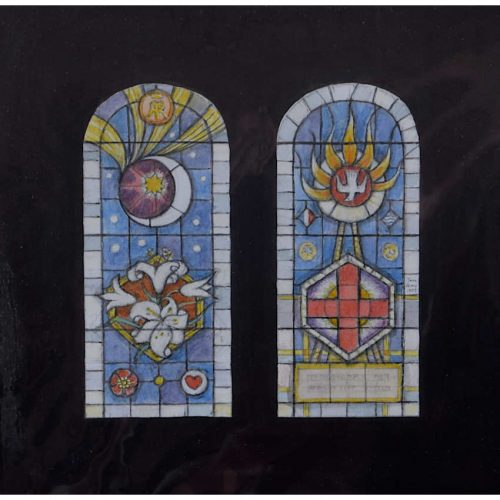
Jane Gray (b.1931)
All Saints Church, North Hillingdon, Design for Stained Glass Window (1982)
Watercolour 15 x 14 cm Studio label verso.All Saints Church, North Hillingdon was constructed in 1930—one of the first of 45 new churches from “The Forty-Five Church Funds” to build new sites of worship in and around the diocese of London. The church was designed by Sir Charles Nicholson and built in Metroland to serve families being moved from inner London. In 1932, the foundations of the church were laid and it was consecrated by in 1933 by the Bishop of Kensington.
Provenance: the artist’s studio sale. Condition: very good. If you are interested, please email info@manningfineart.co.uk or call us on 07929 749056. For other works by Jane Gray and more information about her, please click here. -
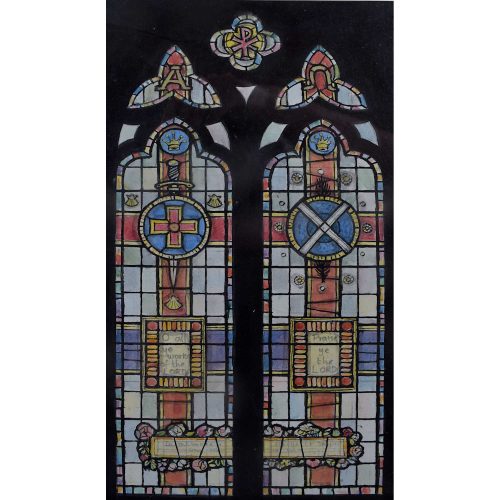
Jane Gray (b.1931)
St James’ Church, Weddington, Nuneaton, Warwickshire, Design for Stained Glass Memorial Window (1989)
Watercolour 19 x 10.5 cm Signed, dated and studio stamp verso.St James’ Church in Weddington dates back to the early-14th-century. The chancel, nave, and west tower were rebuilt in red brick in 1733, and the building was restored in 1881, when Gothic windows were inserted in place of the 1733 details. This design fantastically demonstrates Gray’s modernist style, with her colourful palette and simple yet detailed, geometrical structure. This window was installed in 1990.
Provenance: the artist’s studio sale. Literature: Jane Gray, Playing with Rainbows. (Shropshire: Ellingham Press, 2011), p.80. Condition: very good. If you are interested, please email info@manningfineart.co.uk or call us on 07929 749056. For other works by Jane Gray and more information about her, please click here. -
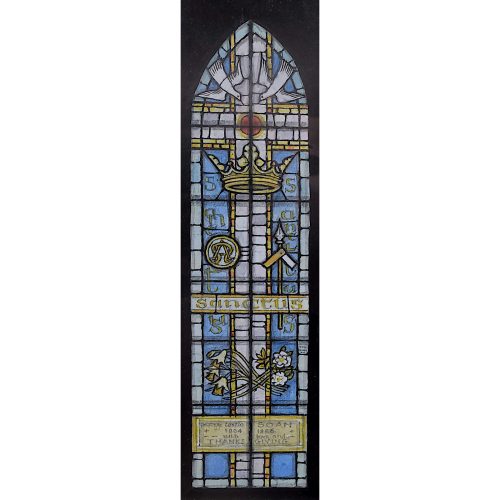
Jane Gray (b.1931)
All Saints Church, Lightwater, Surrey, Design for Stained Glass Memorial Window (1987)
Watercolour 18 x 5 cm Signed and dated verso.All Saints Church in Lightwater, Surrey was built and dedicated in 1903. Prior to this, services were held in Florence Laundry in Guildford Road as, at that time, Lightwater was a small hamlet. With the development of nurseries and cottages to house the influx of workers that followed soon after, the Conventional District of All Saints’ was formed in 1931. Before this, All Saints Church had been a daughter church of Windlesham. A Priest-in-Charge was appointed shortly after the split in 1931 and a vestry extension was added to the building. This window features a background Cross, symbols and flowers and was installed in 1988.
Provenance: the artist’s studio sale. Literature: Jane Gray, Playing with Rainbows. (Shropshire: Ellingham Press, 2011), p.79. Condition: very good. If you are interested, please email info@manningfineart.co.uk or call us on 07929 749056. For other works by Jane Gray and more information about her, please click here. -
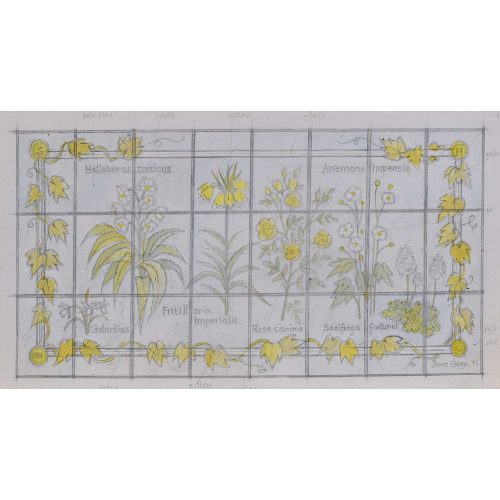
Jane Gray (b.1931)
Saling Hall, Essex, Floral Design for Stained Glass Window
Watercolour 11 x 20 cmSaling Hall, in Essex, has a long and rich history, dating back to the early 12th century when Sir Baldwin Wiscart was the first recorded Lord of the Manor. After his his son, the house passed to the knightly family of Bibbesworth, who lived there for four generations. Sir Walter de Bibbesworth was a crusader and a poet (in French). Nothing remains of the first Saling Hall which was rebuilt around 1590 by the Maxey family who had bought the hall in 1487. The house faced further remodelling by its 17th century owner, Martin Carter, a lawyer. He ornamented the new facade with Dutch gables, which are the latest example of their kind in Essex, and the house has changed little since. The hall passed through many more hands before it was bought, in 1935, by Lady Isabella Carlyle (née Barton) who was a passionate gardener and gave the Hall its first modern gardens. Lady Carlyle sold the Hall in 1971 to Hugh Johnson, a well known garden writer, who continued Lady Carlyle’s work on the gardens. This watercolour sketch is an early design for a stained glass window commissioned by Johnson for a fanlight in Saling Hall. Johnson wished the design to include the plants he grew in his own garden to symbolise the seasons. Gray designed the panel using Corsican Hellebore for winter, the Crown Imperial Fritillary for spring, Dog Rose for summer (although, this was changed to Agapanthus in the final design), and Japanese Anemones for autumn. In the final window, Gray also included vines to frame the design and nod to Johnson’s oenological interests.
Provenance: the artist’s studio sale. Literature: Jane Gray, Playing with Rainbows. (Shropshire: Ellingham Press, 2011), p.40. Condition: very good. If you are interested, please email info@manningfineart.co.uk or call us on 07929 749056. For other works by Jane Gray and more information about her, please click here. -
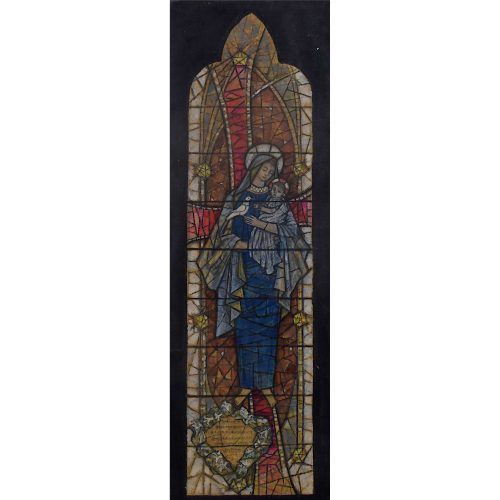
Jane Gray (b.1931)
Early Design for Stained Glass Memorial Window (1962)
Watercolour 27.5 x 9 cmA rare example of Gray’s early work, this design shows a more traditional approach to stained glass window design, something that Gray came to eschew in favour of a more modern style in much of her later work. This design was for a memorial window commemorating Rosemary Anstice, although its intended location is unknown.
Provenance: the artist’s studio sale. Condition: very good. If you are interested, please email info@manningfineart.co.uk or call us on 07929 749056. For other works by Jane Gray and more information about her, please click here. -

Jane Gray (b.1931)
St Wilfrid’s Church, Ribchester, Lancashire, Design for Stained Glass Memorial Window (1995)
Watercolour 20.5 x 3.5 cm Signed, dated and studio stamp verso.St Wilfrid’s Church, Ribchester is situated in the picturesque Ribble Valley, in the heart of rural Lancashire, and dates back to the 13th century. It has since undergone several alterations in the 14th, 15th and 16th centuries as well as substantial restoration works in the 17th, 18th and 19th centuries. The village of Ribchester grew out of the ruins of the Roman fort of Bremetenaccum and the Parish Church of St Wilfrid's stands where the key buildings of the fort would have been. This window was installed in 1996.
Provenance: the artist’s studio sale. Literature: Jane Gray, Playing with Rainbows. (Shropshire: Ellingham Press, 2011), p.84. Condition: very good. If you are interested, please email info@manningfineart.co.uk or call us on 07929 749056. For other works by Jane Gray and more information about her, please click here. -
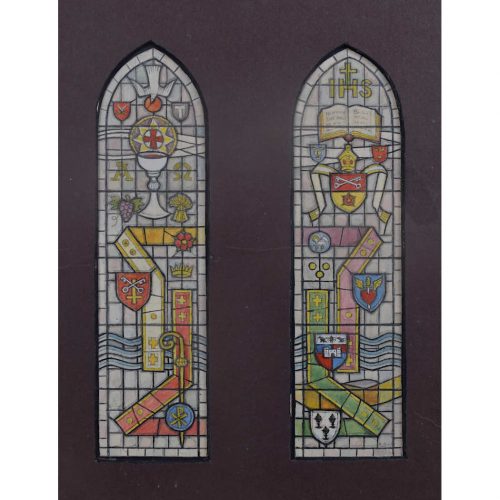
Jane Gray (b.1931)
St John’s Church, Read, Nr. Burnley, Lancashire, Design for Stained Glass Memorial Window (1980)
Watercolour 18 x 10 cm Signed, dated and studio label verso.St John’s Church in Read, Lancashire is a parish church that was dedicated to St John Evangelist in 1884 by Henry Ross of Accrington. The parish also notably includes Read Hall and Park, the seat of the Nowell family from the 14th century, Roger Nowell being a key magistrate at the time of the Lancashire Witches in 1612 sending them to Lancaster for trial and eventual execution. This window was installed in 1981.
Provenance: the artist’s studio sale. Literature: Jane Gray, Playing with Rainbows. (Shropshire: Ellingham Press, 2011), p.76. Condition: very good. If you are interested, please email info@manningfineart.co.uk or call us on 07929 749056. For other works by Jane Gray and more information about her, please click here. -
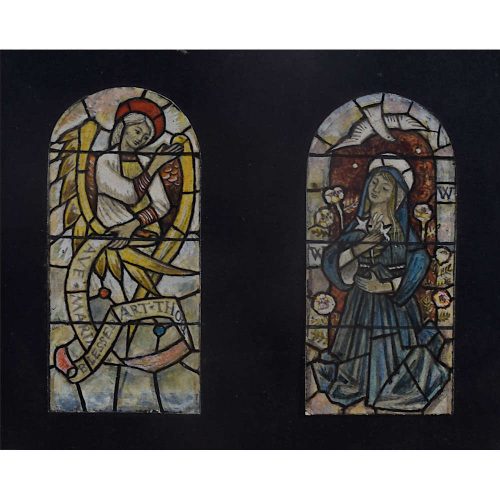
Jane Gray (b.1931)
Early Design for 'Ave Maria' Stained Glass Window (1960)
Watercolour 8 x 7cm Signed and dated verso.A rare example of Gray’s early work, this design shows a more traditional approach to stained glass window design, something that Gray came to eschew in favour of a more modern style in much of her later work. Its intended location is unknown.
Provenance: the artist’s studio sale. Condition: very good. If you are interested, please email info@manningfineart.co.uk or call us on 07929 749056. For other works by Jane Gray and more information about her, please click here. -
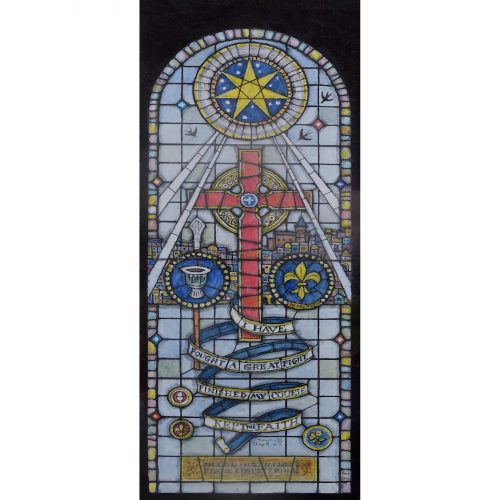
Jane Gray (b.1931)
Church of the Holy Nativity, Bristol, Design for Stained Glass Memorial Window, Commemorating Frank Ernest Pring (1997)
Watercolour 25 x 9.5 cm Signed, dated and studio stamp verso.The Church of the Holy Nativity in Bristol started out as a Mission Chapel in the latter half of the 19th century, when the population of hamlets surrounding Bristol expanded into suburbs—the result of industrial growth around Temple Meads railway station. The site chosen was close to Arnos Vale Cemetery in Knowle, where a wooden church was built to serve the local residents, opening in 1865. From the start the Mission Chapel was well attended and grew significantly in size until it became necessary to find a larger, more permanent building to accommodate the congregation. In 1867 the Chapel was moved to a new site in Wells Road, Knowle, and an appeal for building funds started. To save money the new church was developed in sections, and the Mayor of Bristol laid the foundation stone of the new church in June 1870, it was dedicated on Holy Cross Day, in September, 1871. Tragically, during the first heavy air raid on Bristol on 24th November 1940, Holy Nativity became the first church in the city to be destroyed, however, by some stroke of luck, the Tower, Clock and Bells survived the destruction and it was said that as flames consumed the church the clock continued to chime. Approval to rebuild the church was given in December 1950 and the new church was completed in November 1955. The church was consecrated on the Feast of the Conversion of St Paul, in January 1958. This window was dedicated to the memory of the late churchwarden emeritus, Ernest Pring. In this window, Gray incorporated many significant features of Ernest’s life such as his churchwarden’s staff, the Boy Scouts, his favourite biblical text and the Bristol landscape. A cross dominates the design and a star beams light across the whole design from above. Adjacent to the window is a memorial to Phyllis Pring, Ernest’s wife, also designed by Gray. This window was installed in 1998.
Provenance: the artist’s studio sale. Literature: Jane Gray, Playing with Rainbows. (Shropshire: Ellingham Press, 2011), pp.50, 60, 85. Condition: very good. If you are interested, please email info@manningfineart.co.uk or call us on 07929 749056. For other works by Jane Gray and more information about her, please click here. -
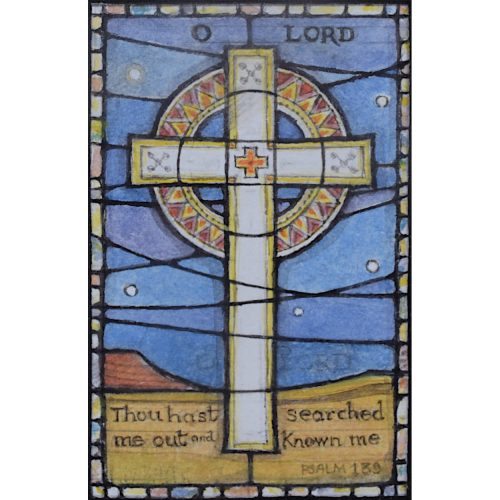
Jane Gray (b.1931)
Warrington Hospital Chapel, Design for Stained Glass Window (1984)
Watercolour 7.5 x 5 cm Dated, detailed in artist’s hand and studio label verso.Warrington Hospital was originally built as an isolation hospital in 1893. The Warrington Union Workhouse Infirmary was built on the site shortly after in 1898, and it was occupied by the Whitecross Military Hospital during the First World War. It wasn’t until 1930, that the infirmary officially became the Warrington Borough General Hospital. Gray’s design for this window in the hospital’s chapel wonderfully demonstrates her colourful, modern style and features the Cross suspended between land and sky, and a line from Psalm 139: ‘O Lord, Thou hast searched me out and known me’. This was one of Gray’s simplest but most favourite window designs, it was installed in the chapel in 1984.
Provenance: the artist’s studio sale. Literature: Jane Gray, Playing with Rainbows. (Shropshire: Ellingham Press, 2011), pp.23, 77. Condition: very good. If you are interested, please email info@manningfineart.co.uk or call us on 07929 749056. For other works by Jane Gray and more information about her, please click here. -
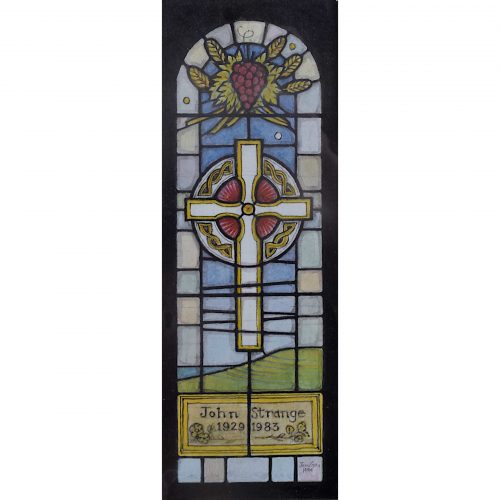
Jane Gray (b.1931)
St Nicholas Church, Worth Matravers, Dorset, Design for Memorial Stained Glass Window (1983)
Watercolour 17 x 6.5 cm Dated, detailed in artist’s hand and studio label verso.St Nicholas Church in Worth Matravers is one of the oldest churches in Dorset. It was built around the year 1100 AD. Though the majority of the church is Norman, some of the stonework appears to come from an earlier building, suggesting that there was a church here in the late Saxon period.This memorial window commemorates John Strange who died in 1984. It was commissioned in advance by John, a keen admirer of Gray’s work, after his wife, Diana, died tragically in 1977. John asked that his window included the sea view from their home, and the vine of grapes in the top panes nods to the full chalice in Diana’s window which sits directly opposite John’s and was also designed by Gray. John’s window was installed in the church in 1986.
Provenance: the artist’s studio sale. Literature: Jane Gray, Playing with Rainbows. (Shropshire: Ellingham Press, 2011), p.22, 75. Condition: very good. If you are interested, please email info@manningfineart.co.uk or call us on 07929 749056. For other works by Jane Gray and more information about her, please click here. -
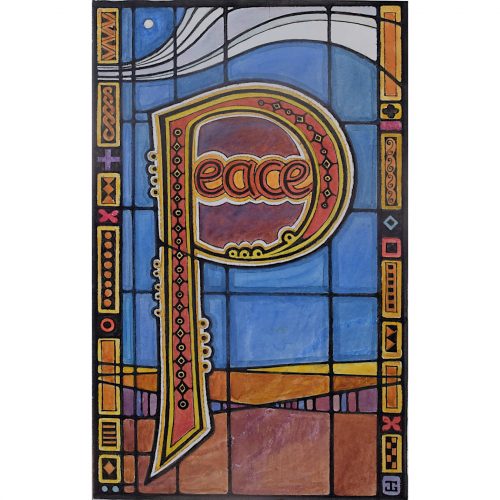
Jane Gray (b.1931)
‘Peace’ Design for a Christmas Card (1989)
Watercolour 24.5 x 14.5 cm Dated, detailed in artist’s hand and studio stamp verso.This simple but effective design for a Christmas card from 1989 beautifully demonstrates Gray’s modernist style, with her recognisably colourful palette and simple yet detailed delineation of her geometric, lettered design.
Provenance: the artist’s studio sale. Condition: very good. If you are interested, please email info@manningfineart.co.uk or call us on 07929 749056. For other works by Jane Gray and more information about her, please click here. -
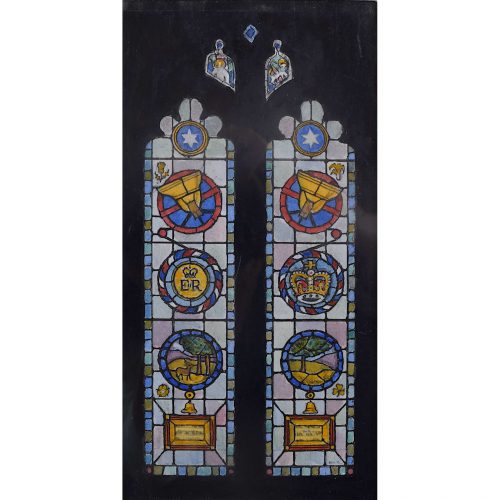
Jane Gray (b.1931)
St Giles Church, Bradford on Tone, Taunton, Somerset, Design for Stained Glass Window (2011)
Watercolour 21.5 x 11.5 cm Signed, dated and studio stamp verso.St Giles Church in Bradford on Tone lies nestled between the Blackdown and Quantock Hills and dates back from the 13th century. One of the lords of the manor, Sir John de Merit (d.1391), founded a chantry chapel here in 1387 but the church has undergone a series of renovations since. The present south aisle and most of the windows date to the 15th century, and the west tower to the early 16th century, before the church underwent full restoration works in 1867.
Provenance: the artist’s studio sale. Condition: very good. If you are interested, please email info@manningfineart.co.uk or call us on 07929 749056. For other works by Jane Gray and more information about her, please click here. -
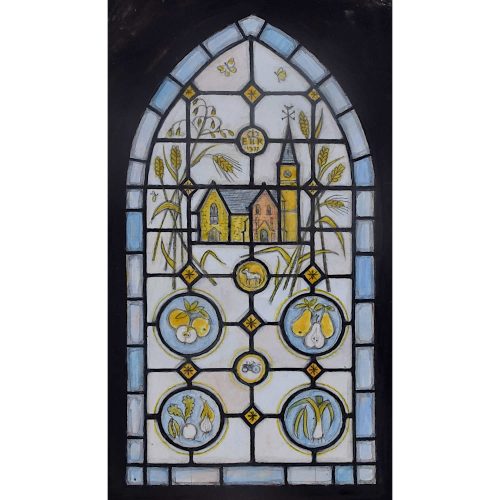
Jane Gray (b.1931)
Gatton Church, nr Redhill, Surrey, Design for Stained Glass Window (1979)
Watercolour 16 x 9 cmA church has existed in this Surrey parish since the Doomsday Survey in 1086 but the present Church dates back to the 13th century, undergoing extensive alterations in the 18th and early 19th centuries. Notably, in 1834, the pulpit and altar, bought from Nuremberg, were hopefully attributed to Albrecht Dürer; the carved doors had travelled from Rouen; the presbytery stalls from a disestablished monastery in Ghent, the altar rails from Tongeren; and the stained glass for the windows, and the wainscoting of the nave and carved canopies had come from Aarschot, near Leuven. This tiny church window was one of Gray’s smallest commissions. Her brief was to include the church at the heart of the Gatton agricultural community, and she did, supplementing this with illustrations of corn, oats, barley, poppies, bees, butterflies, ladybirds, a caterpillar and a grasshopper, alongside small roundels set amongst these containing a calf, a tractor, and a combine harvester respectively. The window was installed in 1980.
Provenance: the artist’s studio sale. Literature: Jane Gray, Playing with Rainbows. (Shropshire: Ellingham Press, 2011), pp.41, 76. Condition: very good. If you are interested, please email info@manningfineart.co.uk or call us on 07929 749056. For other works by Jane Gray and more information about her, please click here. -

Jane Gray (b.1931)
Gatton Church, nr Redhill, Surrey, Design for Stained Glass Window (1979)
Watercolour 15.5 x 8.5 cmDated. Signed verso.
A church has existed in this Surrey parish since the Doomsday Survey in 1086 but the present Church dates back to the 13th century, undergoing extensive alterations in the 18th and early 19th centuries. Notably, in 1834, the pulpit and altar, bought from Nuremberg, were hopefully attributed to Albrecht Dürer; the carved doors had travelled from Rouen; the presbytery stalls from a disestablished monastery in Ghent, the altar rails from Tongeren; and the stained glass for the windows, and the wainscoting of the nave and carved canopies had come from Aarschot, near Leuven. This tiny church window was one of Gray’s smallest commissions. Her brief was to include the church at the heart of the Gatton agricultural community, and she did, supplementing this with illustrations of corn, oats, barley, poppies, bees, butterflies, ladybirds, a caterpillar and a grasshopper, alongside small roundels set amongst these containing a calf, a tractor, and a combine harvester respectively. The window was installed in 1980.
Provenance: the artist’s studio sale. Literature: Jane Gray, Playing with Rainbows. (Shropshire: Ellingham Press, 2011), pp.41, 76. Condition: very good. If you are interested, please email info@manningfineart.co.uk or call us on 07929 749056. For other works by Jane Gray and more information about her, please click here. -
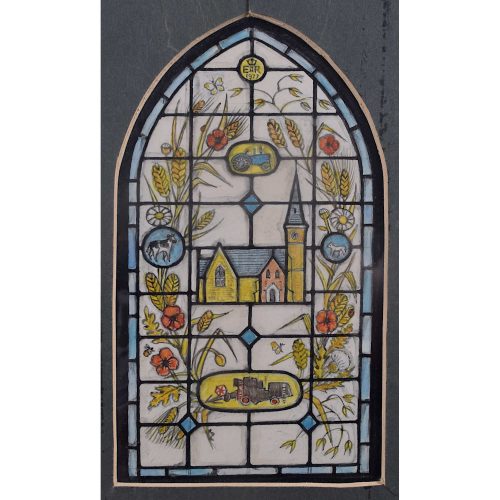
Jane Gray (b.1931)
Gatton Church, nr Redhill, Surrey, Design for Stained Glass Window (1979)
Watercolour 15.5 x 8.5 cmDated, detailed in artist’s hand and studio label verso.
A church has existed in this Surrey parish since the Doomsday Survey in 1086 but the present Church dates back to the 13th century, undergoing extensive alterations in the 18th and early 19th centuries. Notably, in 1834, the pulpit and altar, bought from Nuremberg, were hopefully attributed to Albrecht Dürer; the carved doors had travelled from Rouen; the presbytery stalls from a disestablished monastery in Ghent, the altar rails from Tongeren; and the stained glass for the windows, and the wainscoting of the nave and carved canopies had come from Aarschot, near Leuven. This tiny church window was one of Gray’s smallest commissions. Her brief was to include the church at the heart of the Gatton agricultural community, and she did, supplementing this with illustrations of corn, oats, barley, poppies, bees, butterflies, ladybirds, a caterpillar and a grasshopper, alongside small roundels set amongst these containing a calf, a tractor, and a combine harvester respectively. The window was installed in 1980.
Provenance: the artist’s studio sale. Literature: Jane Gray, Playing with Rainbows. (Shropshire: Ellingham Press, 2011), pp.41, 76. Condition: very good. If you are interested, please email info@manningfineart.co.uk or call us on 07929 749056. For other works by Jane Gray and more information about her, please click here. -
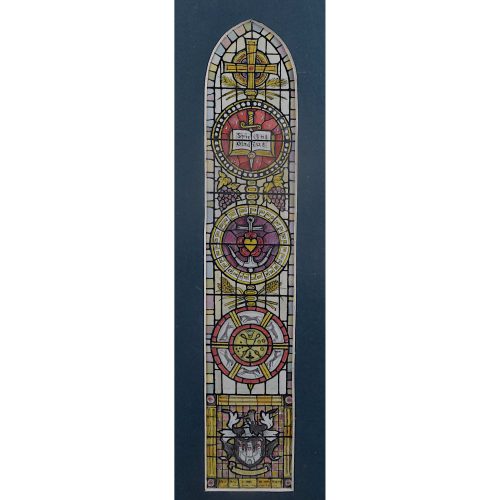
Jane Gray (b.1931)
St Paul’s Church, Warwick, Design for One of Two Stained Glass Windows (1991)
Watercolour 27.5 x 5 cmSigned, dated and studio stamp verso.
Rapid population expansion in Warwick in the early 1800s, due to the opening of the canal and industrialisation, saw the churchyards of St Mary and St Nicholas unable to cope. In 1823 both churches petitioned the Bishop of Worcester for extra burial space, but it wasn’t until 1918 that the Coventry diocese was finally created. A cemetery and chapel, known as St Mary’s Episcopal Chapel were built in 1824 on the site where St Paul’s sits today but was used exclusively for burials. In 1844 the Parish of St Paul's was formed and the church was consecrated on 26th July 1844 by the Bishop of Worcester. This window was installed in 1992.
Provenance: the artist’s studio sale. Literature: Jane Gray, Playing with Rainbows. (Shropshire: Ellingham Press, 2011), p.81. Condition: very good. If you are interested, please email info@manningfineart.co.uk or call us on 07929 749056. For other works by Jane Gray and more information about her, please click here. -
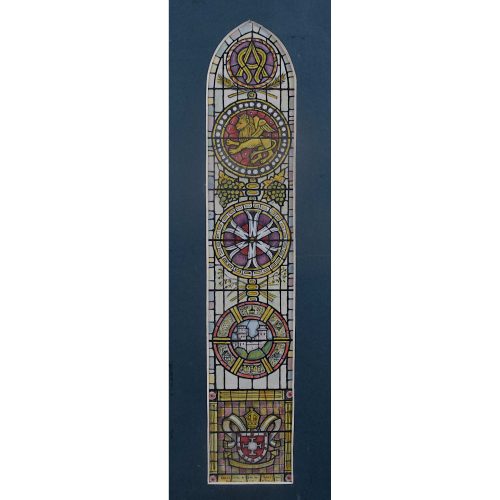
Jane Gray (b.1931)
St Paul’s Church, Warwick, Design for One of Two Stained Glass Windows (1991)
Watercolour 27.5 x 5 cmStudio stamp and notes in artist's hand verso.
Rapid population expansion in Warwick in the early 1800s, due to the opening of the canal and industrialisation, saw the churchyards of St Mary and St Nicholas unable to cope. In 1823 both churches petitioned the Bishop of Worcester for extra burial space, but it wasn’t until 1918 that the Coventry diocese was finally created. A cemetery and chapel, known as St Mary’s Episcopal Chapel were built in 1824 on the site where St Paul’s sits today but was used exclusively for burials. In 1844 the Parish of St Paul's was formed and the church was consecrated on 26th July 1844 by the Bishop of Worcester. This window was installed in 1992.
Provenance: the artist’s studio sale. Literature: Jane Gray, Playing with Rainbows. (Shropshire: Ellingham Press, 2011), p.81. Condition: very good. If you are interested, please email info@manningfineart.co.uk or call us on 07929 749056. For other works by Jane Gray and more information about her, please click here. -
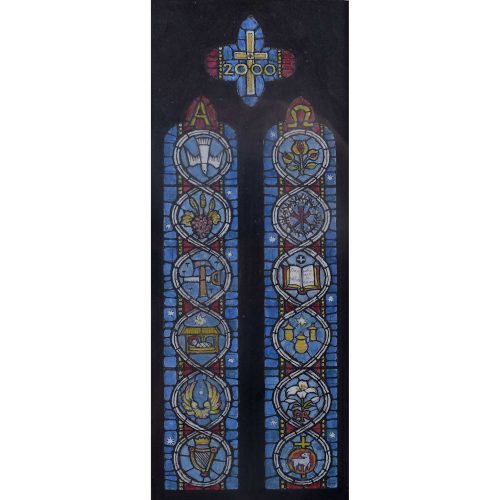
Jane Gray (b.1931)
St Lawrence Church, Weston under Penyard, Design for Stained Glass Window (1999)
Watercolour 21.5 x 8.5 cmSigned, dated and studio stamp verso.
St Catherine’s Church, Penrith is a Puginian Gothic town church, built by Fr George Haydock of Cottam and other Catholic notables in the early 19th century in the 14th century Gothic style. The church and its substantial presbytery, built in 1853, adjoin the churchyard of the Anglican parish church. This window was installed in 1992.
Provenance: the artist’s studio sale. Literature: Jane Gray, Playing with Rainbows. (Shropshire: Ellingham Press, 2011), p.87. Condition: very good. If you are interested, please email info@manningfineart.co.uk or call us on 07929 749056. For other works by Jane Gray and more information about her, please click here. -
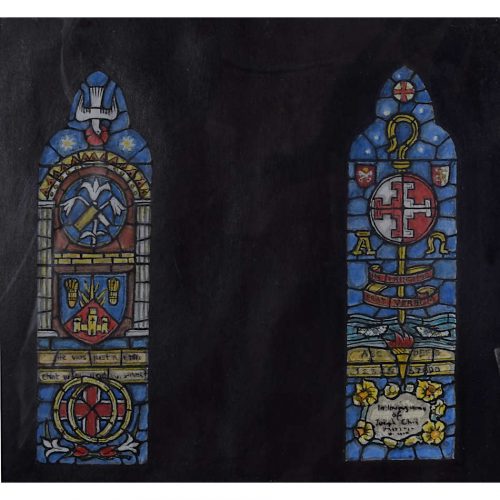
Jane Gray (b.1931)
St Catherine’s Church, Penrith, Cumbria, Design for Stained Glass Memorial Windows (1992)
Watercolour 16.5 x 15 cmSigned, dated and studio stamp verso.
St Catherine’s Church, Penrith is a Puginian Gothic town church, built by Fr George Haydock of Cottam and other Catholic notables in the early 19th century in the 14th century Gothic style. The church and its substantial presbytery, built in 1853, adjoin the churchyard of the Anglican parish church. This window was installed in 1992.
Provenance: the artist’s studio sale. Literature: Jane Gray, Playing with Rainbows. (Shropshire: Ellingham Press, 2011), p.82. Condition: very good. If you are interested, please email info@manningfineart.co.uk or call us on 07929 749056. For other works by Jane Gray and more information about her, please click here. -
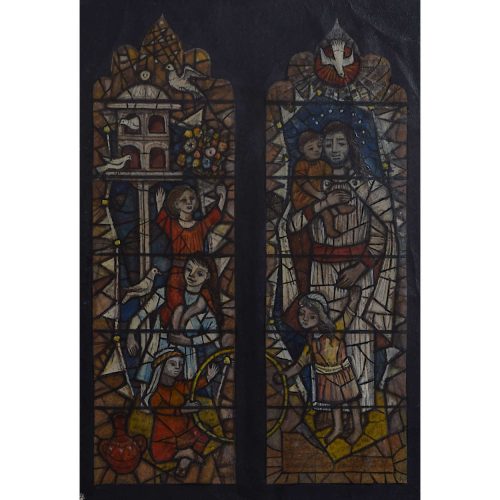
Jane Gray (b.1931)
Framfield Church, Uckfield, Sussex, Design for Stained Glass Window (1961)
Watercolour 18 x 13.5 cmSigned and dated on backing board and verso.
The village of Framfield is mentioned in the Domesday Book, suggesting that there may have been a church on this site in the 11th century; however, the building of the existing church began in the early 13th century when Hempstead chapel was erected, a prelude to the much larger church that followed, consisting of a nave, north and south aisles, western tower, chancel, and chapels. Between 1200 and 1250, this new church emerged into the structure that survives unto the present day. A rare example of Gray’s early work, this design shows a more traditional approach to stained glass window design and centres on the figure of Jesus playing with children. In much of her later work, Gray eschewed this traditional, medieval style in favour of a more modern style.
Provenance: the artist’s studio sale. Literature: Jane Gray, Playing with Rainbows. (Shropshire: Ellingham Press, 2011), p.72. Condition: very good. If you are interested, please email info@manningfineart.co.uk or call us on 07929 749056. For other works by Jane Gray and more information about her, please click here. -
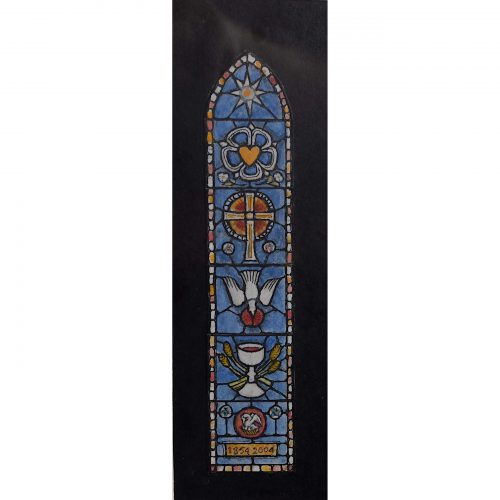
Jane Gray (b.1931)
Christ Church, Bicton, Shropshire, Design for Stained Glass Window (2005)
Watercolour 16 x 5 cmSigned, dated and studio stamp verso.
Christ Church in Bicton Heath, Shrewsbury is a fine example of an early Victorian church, built in 1854 by Edward Haycock Snr in the Early English style with many lancet features. This stained glass window above the chancel arch was commissioned to celebrate the new millennium.
Provenance: the artist’s studio sale. Condition: very good. If you are interested, please email info@manningfineart.co.uk or call us on 07929 749056. For other works by Jane Gray and more information about her, please click here. -

Jane Gray (b.1931)
Design for Stained Glass Panel in a Private House (1990)
Watercolour 14.5 x 7.5 cmSigned, dated and studio stamp verso.
This design for a staircase window in a private house features the owner’s favourite flowers, including Daffodils, Irises and Poppies, and is typical of Gray’s secular designs which were often highly colourful and often floral-centric. The window was installed in 1991.
Provenance: the artist’s studio sale. Literature: Jane Gray, Playing with Rainbows. (Shropshire: Ellingham Press, 2011), p.29. Condition: very good. If you are interested, please email info@manningfineart.co.uk or call us on 07929 749056. For other works by Jane Gray and more information about her, please click here. -
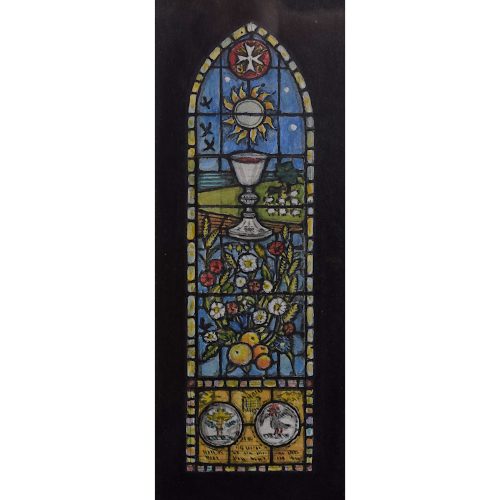
Jane Gray (b.1931)
Church of St Peter and St John the Baptist, Wivelsfield, Sussex, Design for Stained Glass Memorial Window (1993)
Watercolour 16.5 x 5.5 cmSigned, dated and studio stamp verso.
The country Church of St Peter and St John the Baptist in Wivelsfield, East Sussex, dates back to around the 11th century. Since then it has undergone several renovations; the south aisle is 13th century, the tall south chapel is 14th century, the southwest tower was built around 1500 and the chancel was lengthened in the 19th century. Originally, the church was a chapelry of Ditchling, and it wasn't until after the Reformation that the church separated completely. This window was commissioned to commemorate Sir Bryant Godman Irvine, former Deputy Speaker of the House of Commons, and to his wife, and features both their family crests. The window was installed in 1995.
Provenance: the artist’s studio sale. Literature: Jane Gray, Playing with Rainbows. (Shropshire: Ellingham Press, 2011), p.84. Condition: very good. If you are interested, please email info@manningfineart.co.uk or call us on 07929 749056. For other works by Jane Gray and more information about her, please click here. -

Jane Gray (b.1931)
St Mary’s Church, Harmondsworth, Design for Stained Glass Window (1982)
Watercolour 11.5 x 4.5 cmStudio stamp verso.
St Mary’s Church, the Parish Church of Harmondsworth, dates from the 12th-15th centuries. The South aisle, with its massive Norman columns, and the entrance are the oldest parts of the building still intact today. The North aisle dates from the 13th Century, the North Chapel the 14th Century, the chancel was remodelled in the 15th Century, and the tower was built in 1500. In the 19th century the church underwent extensive restoration and a porch and vestry were added but the original Norman font still exists today. This window features a red Cross and a wreath of flowers, and was installed in the church in 1983.
Provenance: the artist’s studio sale. Literature: Jane Gray, Playing with Rainbows. (Shropshire: Ellingham Press, 2011), p.77. Condition: very good. If you are interested, please email info@manningfineart.co.uk or call us on 07929 749056. For other works by Jane Gray and more information about her, please click here. -
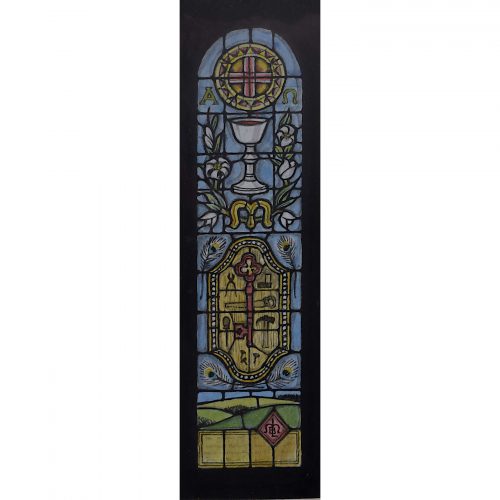
Jane Gray (b.1931)
St Mary’s Church, Sullington, Design for Stained Glass Window (1992)
Watercolour 18 x 5 cmSigned, dated and studio stamp verso.
The little church of St Mary’s, Sullington, has laid nestled beneath the Sussex Downs for almost a thousand years, within the bounds of an even older yew grove. The tower and the nave date back to c.1050 but were altered in the Norman period and again in thee 12th and 13th centuries.This small window pays remembrance to the local carpenter and verger. The design incorporates carpenters’ tools, peacock feathers from the peacocks in the neighbouring Manor House who often joined the church services, the Church’s communion chalice, and a view of the Sussex Downs. This window was installed in 1992.
Provenance: the artist’s studio sale. Literature: Jane Gray, Playing with Rainbows. (Shropshire: Ellingham Press, 2011), pp.51, 82. Condition: very good. If you are interested, please email info@manningfineart.co.uk or call us on 07929 749056. For other works by Jane Gray and more information about her, please click here. -
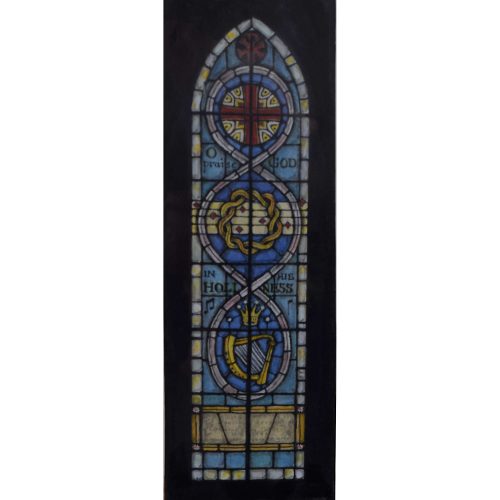
Jane Gray (b.1931)
All Saints Church, Lightwater, Surrey, Design for Stained Glass Window (1990)
Watercolour 18 x 6 cmSigned, dated and studio stamp verso.
All Saints Church in Lightwater, Surrey was built and dedicated in 1903. Prior to this, services were held in Florence Laundry in Guildford Road as, at that time, Lightwater was a small hamlet. With the development of nurseries and cottages to house the influx of workers that followed soon after, the Conventional District of All Saints’ was formed in 1931. Before this, All Saints Church had been a daughter church of Windlesham. A Priest-in-Charge was appointed shortly after the split in 1931 and a vestry extension was added to the building. This window commemorates the church’s organist, Catherine Challen, and features symbols associated with St Cecilia in acknowledgement of her musical contribution. The window was installed in 1991.
Provenance: the artist’s studio sale. Literature: Jane Gray, Playing with Rainbows. (Shropshire: Ellingham Press, 2011), p.79. Condition: very good. If you are interested, please email info@manningfineart.co.uk or call us on 07929 749056. For other works by Jane Gray and more information about her, please click here. -
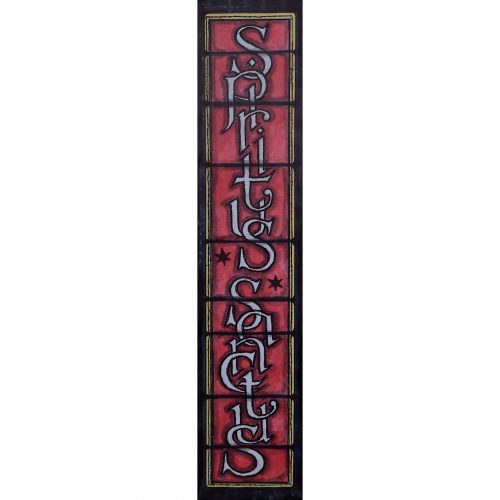
Jane Gray (b.1931)
St Peter’s Church, Cound, Shropshire, Design for Stained Glass Lettered Panel (1999)
Watercolour 24.5 x 5 cmStudio stamp verso.
St Peter’s Church, Cound lies in the grounds of the Cound Hall estate and is dedicated to St Peter because of its medieval association with Shrewsbury Abbey (dedicated to Saints Peter and Paul). The oldest part of the present church dates back to the 13th century but it has been renovated several times since then, with additions from the 14th, 15th and 19th centuries. This unique design by Gray highlights her modern style, the simple lettered panel, bearing the Latin name for the holy spirit, brimming with vibrant energy.
Provenance: the artist’s studio sale. Literature: Jane Gray, Playing with Rainbows. (Shropshire: Ellingham Press, 2011), p.86. Condition: very good. If you are interested, please email info@manningfineart.co.uk or call us on 07929 749056. For other works by Jane Gray and more information about her, please click here. -
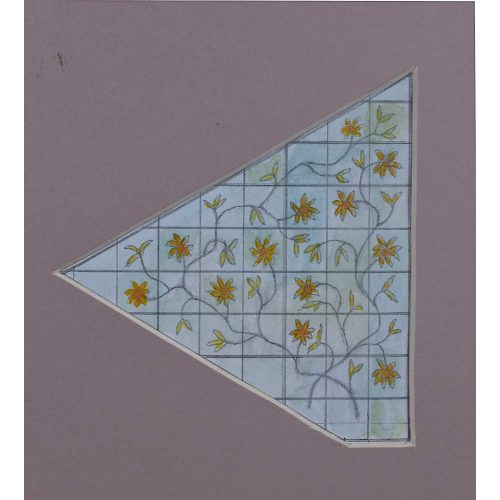
Jane Gray (b.1931)
Floral Design for Domestic Stained Glass Window
Watercolour 11.5 x 11 cmStudio stamp verso.
This uniquely shaped design for a domestic window centres on a sprawling pair of entangled floral branches that cover the small squared panels in an astute imitation of a trellis. The design is typical of many of Gray’s domestic windows which often focus on floral designs.
Provenance: the artist’s studio sale. Condition: very good. If you are interested, please email info@manningfineart.co.uk or call us on 07929 749056. For other works by Jane Gray and more information about her, please click here. -
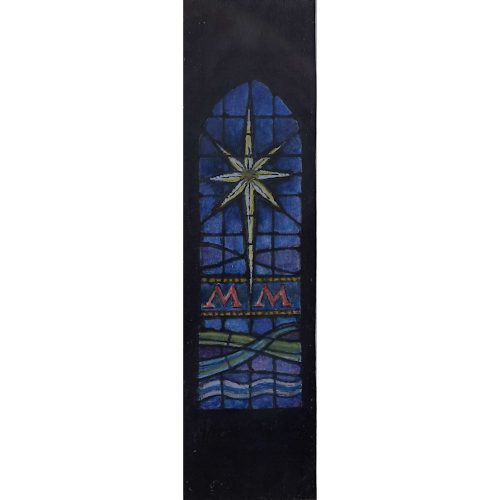
Jane Gray (b.1931)
Christ Church, Oxon, Shrewsbury, Design for Millennium Stained Glass Window (1999)
Watercolour 12.5 x 3.5 cmSigned, dated and studio stamp verso.
Christ Church in Oxon, Shrewsbury is a fine example of an early Victorian church, built in 1854 by Edward Haycock Snr in the Early English style with many lancet features. This stained glass window above the chancel arch was commissioned to celebrate the new millennium, and centres on the star of Bethlehem against a coastal backdrop. This window was installed in 2001.
Provenance: the artist’s studio sale. Literature: Jane Gray, Playing with Rainbows. (Shropshire: Ellingham Press, 2011), p.86. Condition: very good. If you are interested, please email info@manningfineart.co.uk or call us on 07929 749056. For other works by Jane Gray and more information about her, please click here. -
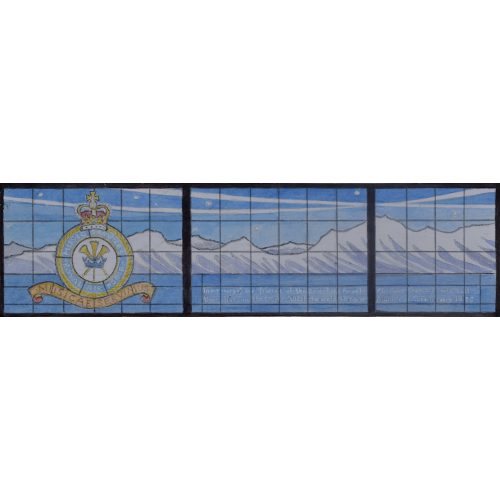
Jane Gray (b.1931)
Royal Airforce Music Services Headquarters, Design for Memorial Stained Glass Window (1985)
Watercolour 6 x 22.5 cmSigned and dated verso.
Gray’s design for this memorial window commemorates the lives of those lost in the Langenbruck bus crash, 11 February 1985, when a double-decker bus carrying 40 musicians from the band of Royal Air Force Germany, crashed on an autobahn between Nuremberg and Munich. Twenty-one of the occupants were killed in the crash. As the text in the design remembers: this window is ‘In memory of our friends of the Band of the Royal Air Force Germany who lost their lives in the tragic Autobahn accident near Munich on 11 February 1985’.
Provenance: the artist’s studio sale. Condition: very good. If you are interested, please email info@manningfineart.co.uk or call us on 07929 749056. For other works by Jane Gray and more information about her, please click here. -
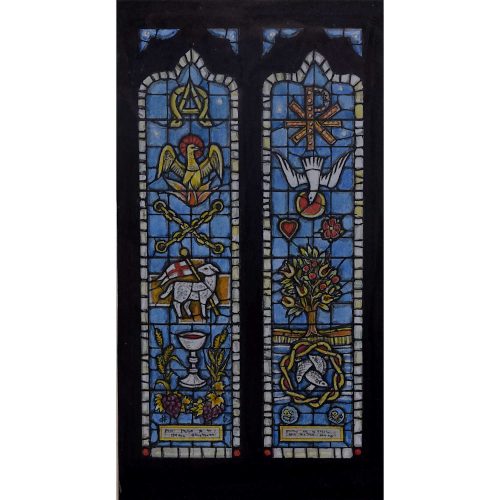
Jane Gray (b.1931)
St Leonards Church, Stagsden, Bedfordshire, Design for Stained Glass Window (1998)
Watercolour 19 x 10 cmSigned and dated verso.
Stagsden receives mention in the Domesday Book, suggesting the likely existence of a church here in the 11th century, St Leonard’s church is, however, first recorded in the 13th century, the vicar in 1229 being Reginald de Stacheden (Stagsden). The nave and the chancel of the present church date back to a similar period. Additions and renovations have since taken place, including the late 14th/early 15th century addition of the north chapel. This window was installed in 2000.
Provenance: the artist’s studio sale. Literature: Jane Gray, Playing with Rainbows. (Shropshire: Ellingham Press, 2011), p.86. Condition: very good. If you are interested, please email info@manningfineart.co.uk or call us on 07929 749056. For other works by Jane Gray and more information about her, please click here. -
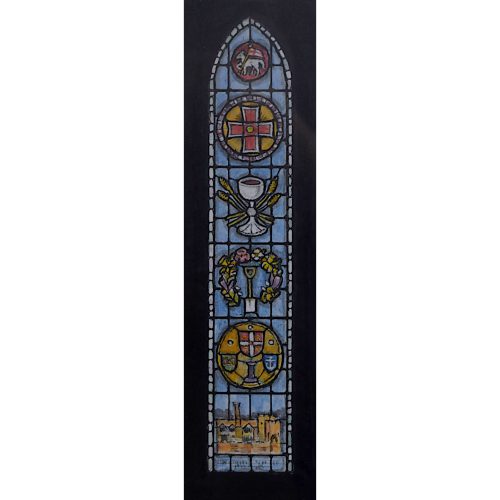
Jane Gray (b.1931)
St John the Baptist Church, Preen Manor, Design for Stained Glass Window (2003)
Watercolour 17.5 x 5 cmSigned, dated and studio stamp verso.
St John the Baptist Church sits at the heart of the Shropshire hamlet, Preen. Church Preen Manor sits adjacent to the church and lies on an old Clunjac Monastery, thought to have been built in 1159. The present church was built in the 13th century although it was originally a monastic church, founded as a cell of Wenlock Priory in 1163 and features in the Domesday Book. A prior and two or three monks would have served the church, however the priory has little remains, excepting a few visible in the gardens of Church Preen Manor.
Provenance: the artist’s studio sale. Literature: Jane Gray, Playing with Rainbows. (Shropshire: Ellingham Press, 2011), p.88. Condition: very good. If you are interested, please email info@manningfineart.co.uk or call us on 07929 749056. For other works by Jane Gray and more information about her, please click here. -
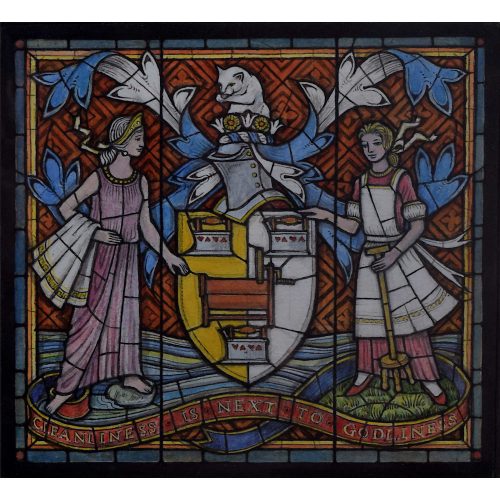
Jane Gray (b.1931)
Arms of the Worshipful Company of Launderers, Design for Stained Glass Window (1985)
Watercolour 12.5 x 13.5 cmDated and detailed in artist's hand with studio label verso.
This window was commissioned by the Worshipful Company of Launderers to oversee their banqueting hall (which belongs to the Worshipful Company of Glaziers, of which Gray was the first female member). Besides the traditional symbols of aprons, irons, and mangles, Gray’s design also humorously includes a white cat licking itself clean. Alongside this window, Gray also designed a roundel containing the Company’s Arms.
Provenance: the artist’s studio sale. Literature: Jane Gray, Playing with Rainbows. (Shropshire: Ellingham Press, 2011), p.39. Condition: very good. If you are interested, please email info@manningfineart.co.uk or call us on 07929 749056. For other works by Jane Gray and more information about her, please click here. -
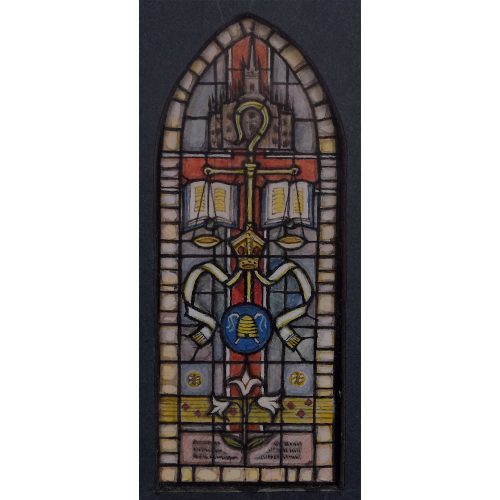
Jane Gray (b.1931)
St Ambrose Church, Leyland, Design for Stained Glass Window (1980)
Watercolour 11.5 x 4.5 cmStudio label verso.
The site of St Ambrose Church, Leyland, originally lay in the parish of St. Andrew’s Leyland; however, after a 37% population increase in the town caused by the coming of the railways and industrialisation in the 1870’s, the Vicar of St. Andrews decided to build a chapel of ease to St. Andrews. The church was rebuilt on the northern edge of the town in 1880. This window features symbols of St Ambrose and was installed in the church in 1982.
Provenance: the artist’s studio sale. Literature: Jane Gray, Playing with Rainbows. (Shropshire: Ellingham Press, 2011), p.76. Condition: very good. If you are interested, please email info@manningfineart.co.uk or call us on 07929 749056. For other works by Jane Gray and more information about her, please click here. -
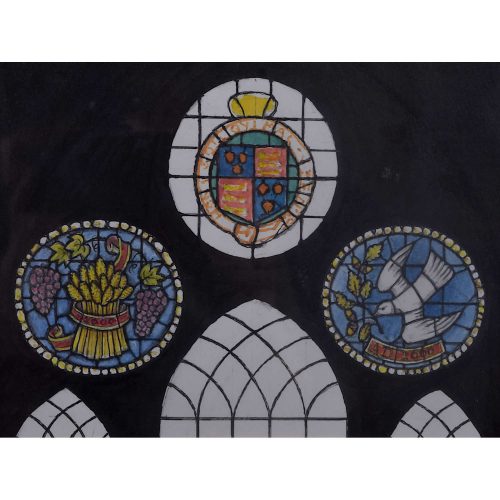
Jane Gray (b.1931)
St Mary’s Church, Longnor, Shropshire, Design for Stained Glass Millennium Commemoration Window (2000)
Watercolour 12.5 x 17.5 cmSigned, dated and studio stamp verso.
St Mary’s Church, Longnor, was originally built as a chapel to Condover around 1280 A.D. It was then a private chapel to the Corbett family of Longnor Hall, before becoming the parish church. These designs for two stained glass roundel windows in the East window were commissioned to commemorate the Millennium. This window was installed in 2001.
Provenance: the artist’s studio sale. Literature: Jane Gray, Playing with Rainbows. (Shropshire: Ellingham Press, 2011), p.87. Condition: very good. If you are interested, please email info@manningfineart.co.uk or call us on 07929 749056. For other works by Jane Gray and more information about her, please click here. -
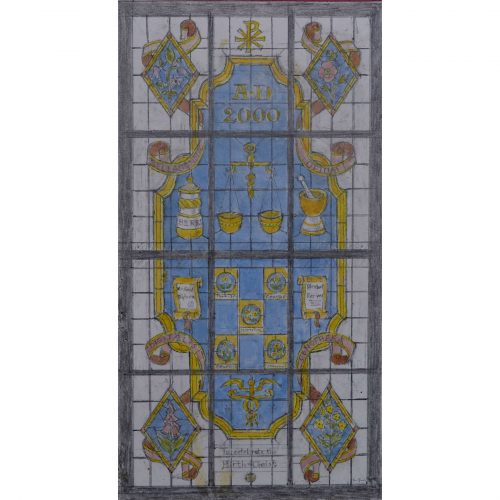
Jane Gray (b.1931)
The Worshipful Society of Apothecaries, Design for Stained Glass Millennium Window (1999)
Watercolour 25 x 13.5 cmSigned.
The Worshipful Society of Apothecaries was founded in 1617, after breaking away from the Grocers’ Company (founded 1345). The Society were granted a royal charter by James I, and, throughout the remainder of the 17th century, challenged the College of Physicians monopoly on practicing medicine. In 1704, the House of Lords overturned a ruling of the Queen’s Bench that gave apothecaries the right to practice medicine. Apothecaries, therefore, may be viewed as the forerunners of present-day general (medical) practitioners or family physicians. Gray’s design for this 2000 memorial window, in the Apothecaries Hall in Blackfriars, London, features the names and illustrations of several medicinal plants, including Belladonna, Opium, Digitalis, Oenothara, Primrose, Cowslip, Nasturtium, Camomile, and Marigold.
Provenance: the artist’s studio sale. Condition: very good. If you are interested, please email info@manningfineart.co.uk or call us on 07929 749056. For other works by Jane Gray and more information about her, please click here. -

Jane Gray (b.1931)
St Barnabas Church, Franche, Kidderminster, Design for Stained Glass Memorial Window (1992)
Watercolour 21 x 12.5 cmSigned, dated and studio stamp verso.
St Barnabas Church, a red brick church designed by Martin & Chamberlain, was established in Franche in 1871 as a chapel-of-ease to the Parish Church of Kidderminster, St Mary and All Saints. St Barnabas is known for its diverse collection of stained glass windows and, alongside Gray’s modern memorial window, features windows in the Arts and Crafts style, likely designed by Benjamin Warren.
Provenance: the artist’s studio sale. Condition: very good. If you are interested, please email info@manningfineart.co.uk or call us on 07929 749056. For other works by Jane Gray and more information about her, please click here. -
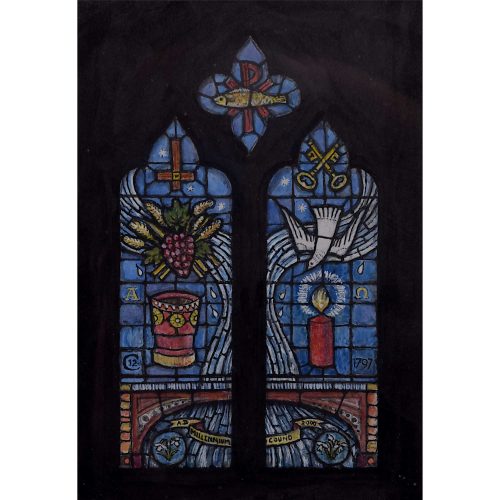
Jane Gray (b.1931)
St Peter’s Church, Cound, Shropshire, Design for Stained Glass Window (1999)
Watercolour 16.5 x 11.5 cmSigned, dated and studio stamp verso.
Proposed design for a window on the south wall, over the font. St Peter’s Church, Cound lies in the grounds of the Cound Hall estate and is dedicated to St Peter because of its medieval association with Shrewsbury Abbey (dedicated to Saints Peter and Paul). The oldest part of the present church dates back to the 13th century but it has been renovated several times since then, with additions from the 14th, 15th and 19th centuries.
Provenance: the artist’s studio sale. Condition: very good. If you are interested, please email info@manningfineart.co.uk or call us on 07929 749056. For other works by Jane Gray and more information about her, please click here. -
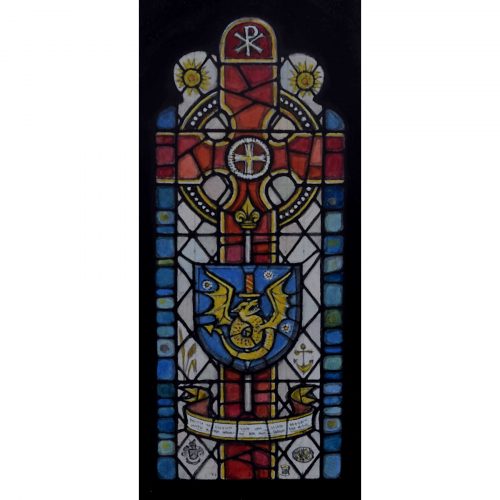
Jane Gray (b.1931)
St Margaret’s Church, Downham, Billericay, Essex, Design for Stained Glass Window
Watercolour 15.5 x 7.5 cmSigned and studio stamp verso.
It is likely that Christians have worshiped at this site for over a thousand years, but it wasn’t until the mid13th century that the first recorded church appeared. The church is dedicated to St Margaret of Antioch, a dragon slayer and patron saint of child bearing. Devotion Saint Margaret of Antioch became popular in the 13th century and there are around 80 churches today that share this dedication from the 13th century. The oldest part of the present church is the tower which dates from c.1470. The nave was rebuilt in the nineteenth century using much of the material from the thirteenth century church. An arson attack in March 1977 resulted in the gutting of the church, resulting in a highly modern interior. This window features the symbol of St Margaret and a red Cross on quarry background. The window was installed in 1988.
Provenance: the artist’s studio sale. Literature: Jane Gray, Playing with Rainbows. (Shropshire: Ellingham Press, 2011), p.79. Condition: very good. If you are interested, please email info@manningfineart.co.uk or call us on 07929 749056. For other works by Jane Gray and more information about her, please click here. -
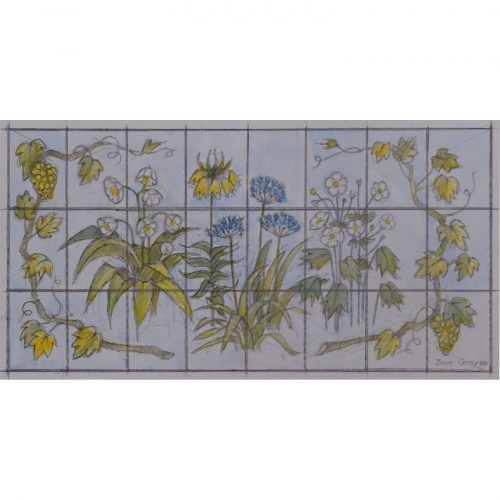
Jane Gray (b.1931)
Saling Hall, Essex, Design for Stained Glass Window (1980)
Watercolour 11 x 20 cmSigned and dated.
Saling Hall, in Essex, has a long and rich history, dating back to the early 12th century when Sir Baldwin Wiscart was the first recorded Lord of the Manor. After his his son, the house passed to the knightly family of Bibbesworth, who lived there for four generations. Sir Walter de Bibbesworth was a crusader and a poet (in French). Nothing remains of the first Saling Hall which was rebuilt around 1590 by the Maxey family who had bought the hall in 1487. The house faced further remodelling by its 17th century owner, Martin Carter, a lawyer. He ornamented the new facade with Dutch gables, which are the latest example of their kind in Essex, and the house has changed little since. The hall passed through many more hands before it was bought, in 1935, by Lady Isabella Carlyle (née Barton) who was a passionate gardener and gave the Hall its first modern gardens. Lady Carlyle sold the Hall in 1971 to Hugh Johnson, a well known garden writer, who continued Lady Carlyle’s work on the gardens. This design is a final drawing for a stained glass window commissioned by Johnson for a fanlight in Saling Hall. Johnson wished the design to include the plants he grew in his own garden to symbolise the seasons. Gray designed the panel using Corsican Hellebore for winter, the Crown Imperial Fritillary for spring, Agapanthas for summer, and Japanese Anemones for autumn. Gray also included vines to frame the design and nod to Johnson’s oenological interests.
Provenance: the artist’s studio sale. Literature: Jane Gray, Playing with Rainbows. (Shropshire: Ellingham Press, 2011), p.40. Condition: very good. If you are interested, please email info@manningfineart.co.uk or call us on 07929 749056. For other works by Jane Gray and more information about her, please click here. -
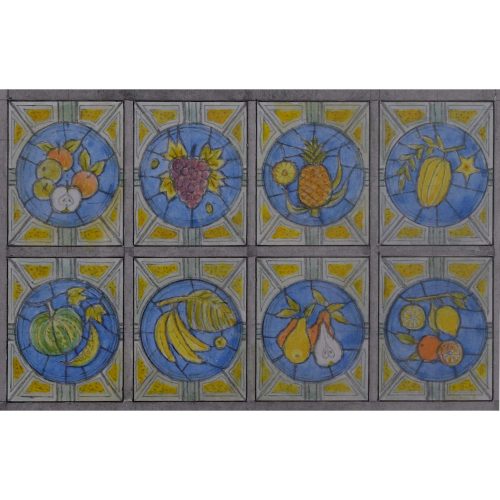
Jane Gray (b.1931)
Design for an Illuminated Panel of Stained Glass in a Private House (1994)
Watercolour 10 x 15.5 cmSigned and dated verso.
This design for a domestic window in a Bristol house was the second commission Gray received from this client. Having previously created a panel of eight squares featuring red floral designs, Gray was now faced with the challenge of another eight panel series, this time of fruits, which the client wanted to look as natural as possible. Gray succeeded in completing this effect, the screen featuring 8 bordered roundels containing apples, grapes, pineapple, starfruit, melon, bananas, pears, and citrus fruits.
Provenance: the artist’s studio sale. Literature: Jane Gray, Playing with Rainbows. (Shropshire: Ellingham Press, 2011), p.27. Condition: very good. If you are interested, please email info@manningfineart.co.uk or call us on 07929 749056. For other works by Jane Gray and more information about her, please click here. -
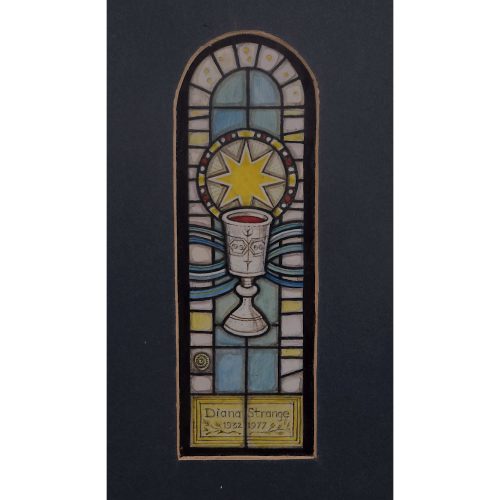
Jane Gray (b.1931)
St Nicholas Church, Worth Matravers, Dorset, Design for Memorial Stained Glass Window (1978)
Watercolour 15.5 x 5 cmDated and detailed in artist’s hand with studio label verso.
St Nicholas Church in Worth Matravers is one of the oldest churches in Dorset. It was built around the year 1100 AD. Though the majority of the church is Norman, some of the stonework appears to come from an earlier building, suggesting that there was a church here in the late Saxon period. This memorial window commemorates Diana Strange who died tragically in 1977. It was commissioned by her husband who was a keen admirer of Gray’s work and centres on the Elizabethan chalice used in St Nicholas’ Church. The window directly opposite contains another memorial window designed by Gray for Diana’s Husband, John Strange, who died seven years later. Diana's memorial window was installed in 1979.
Provenance: the artist’s studio sale. Literature: Jane Gray, Playing with Rainbows. (Shropshire: Ellingham Press, 2011), pp.22, 75. Condition: very good. If you are interested, please email info@manningfineart.co.uk or call us on 07929 749056. For other works by Jane Gray and more information about her, please click here. -
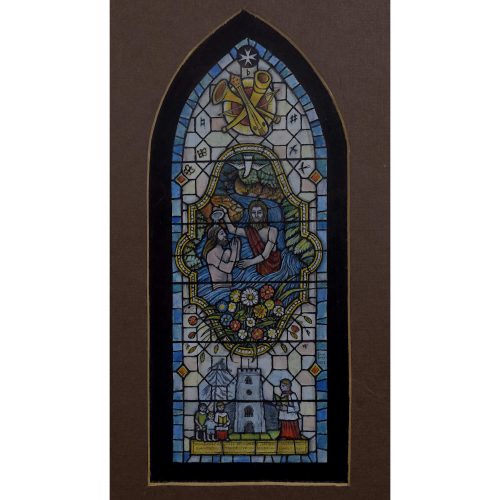
Jane Gray (b.1931)
St John’s Church, Broughton, Design for Stained Glass Window (1983)
Watercolour 20 x 9 cmStudio label verso.
St John’s Church, in rural Preston, began as a wooden family chapel for the Lord of the Manor in the 12th century. This chapel, however, was demolished in 1823. Since then, the rebuilt sandstone church has been remodelled a number of times, the oldest part of the existing church, the tower, dating back to 1533 during Henry VIII’s reign. This window centres on the baptism of Christ by St John and features symbolic imagery of music, flowers, harvest, birds, insects, choristers, schoolchildren, and the church itself. The window was installed in 1985.
Provenance: the artist’s studio sale. Literature: Jane Gray, Playing with Rainbows. (Shropshire: Ellingham Press, 2011), p.78. Condition: very good. If you are interested, please email info@manningfineart.co.uk or call us on 07929 749056. For other works by Jane Gray and more information about her, please click here. -

Jane Gray (b.1931)
St Peter’s Church, Martindale Design for Stained Glass Windows (1976)
Watercolour 17.5 x 6 cmStudio label verso.
St Peter’s Church was built in Martindale, Cumbria in 1880 by a local craftsman using stone from the surrounding area. The church is situated in an enchanting rural oasis and has connections to the acclaimed modern poet, Kathleen Raine, who lived in the Old Vicarage, as well as William and Dorothy Wordsworth who visited the area on one of their Cumbrian excursions. Gray’s ‘Martindale Era’ lasted from 1974-1981, in which time, she designed and installed fifteen stained glass windows in St Peter’s Church. These window designs are for Resurrection and Passion windows on the north-side of the church.
Provenance: the artist’s studio sale. Literature: Jane Gray, Playing with Rainbows. (Shropshire: Ellingham Press, 2011), pp.17, 74. Condition: very good. If you are interested, please email info@manningfineart.co.uk or call us on 07929 749056. For other works by Jane Gray and more information about her, please click here. -
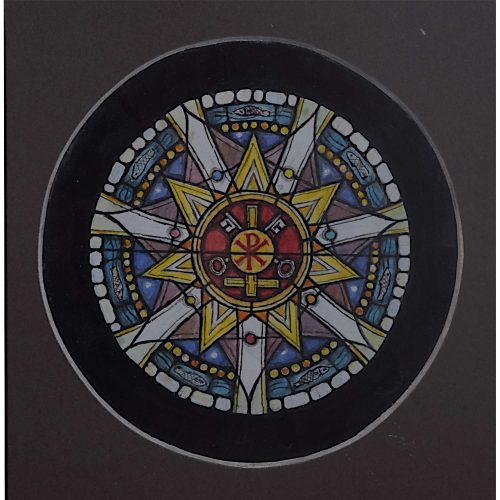
Jane Gray (b.1931)
St Peter’s Church, Monkmoor Road, Shrewsbury, Design for Stained Glass Window (1990)
Watercolour D.12 cmSigned, dated and studio stamp verso.
St Peter’s is a small, modern mission church adjoining Shrewsbury Abbey and was consecrated shortly before the outbreak of World War II in 1939. Gray’s stained glass design sensitively yet strikingly reflects this simple site of religious worship in her typical modern-medieval style. Important numbers in Christian iconography are included: three for the Trinity (Body, Mind, and Spirit), four for the material world of the Elements, and so, together, seven which combines the worlds of matter and spirit and is thus regarded as the perfect number. At the centre of the window sits the Chi-Ro, or monogram of Christ, placed against the emblems of St Peter (a pair of crossed keys and an inverted Latinate cross). Surrounding the design, seven fish swim in a turquoise sea. The window was installed in 1992.
Provenance: the artist’s studio sale. Literature: Jane Gray, Playing with Rainbows. (Shropshire: Ellingham Press, 2011), pp.48, 81. Condition: very good. If you are interested, please email info@manningfineart.co.uk or call us on 07929 749056. For other works by Jane Gray and more information about her, please click here. -
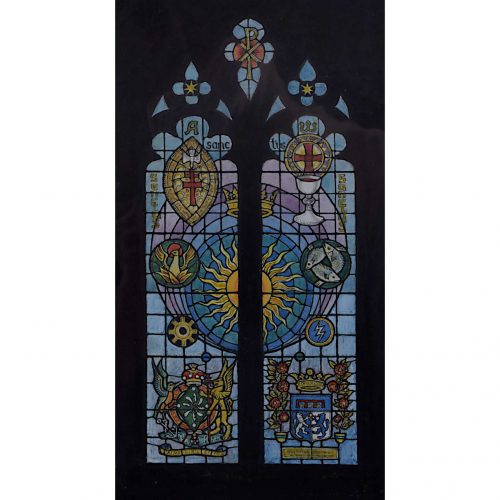
Jane Gray (b.1931)
Writtle Church, Essex, Design for Stained Glass Window (1989)
Watercolour 23 x 12.5 cmSigned, dated and studio stamp verso.
All Saints Church in Writtle, Essex has stood at the heart of the ancient manor of Writtle for over one thousand years and dates back to the early 13th century, although, a Saxon church likely existed on the site prior to this. The living of Writtle church was handed over in 1399 to the Warden and Fellows of New College Oxford in whose patronage the church has remained to this day. This window design features the Arms of Baroness Platt of Writtle linked with those of Guglielmo Marconi as well as the phoenix, and three fishes of Trinity. The window was installed in 1992.
Provenance: the artist’s studio sale. Literature: Jane Gray, Playing with Rainbows. (Shropshire: Ellingham Press, 2011), p.81. Condition: very good. If you are interested, please email info@manningfineart.co.uk or call us on 07929 749056. For other works by Jane Gray and more information about her, please click here. -
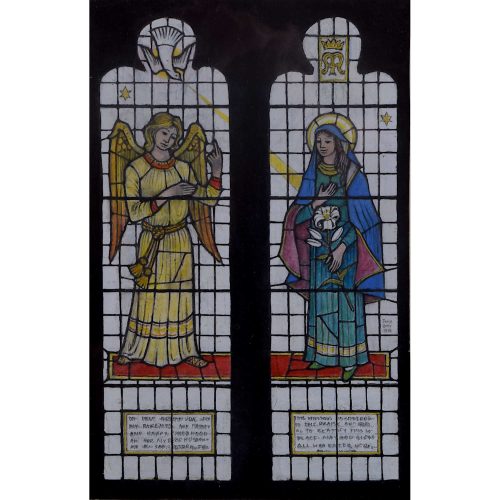
Jane Gray (b.1931)
St Mary the Virgin, Ebony, Tenterden, Design for Stained Glass Window (1983)
Watercolour 15.5 x 10 cmDated in artist's hand and artist label verso.
Worship at Ebony has taken place for some one thousand years but St Mary the Virgin Church, as it exists today, was not built until 1858. A church had previously existed on the island of Ebony where, standing 30 metres above sea level and visible for miles around, it provided a prominent landmark to ships coming up the sea creek. This church, however, was devastated by a fire in the 16th century, and from its ruins, a much smaller church, built in a simple rectangle of Kentish ragstone, was erected, serving the parish until 1858. In this year, the church was taken down, stone by stone, and moved to the nearby hamlet of Reading Street where it stands today. Gray’s design centres on the Anunciation, featuring the figures of Mary and Gabriel, and was installed in the church in 1984.
Provenance: the artist’s studio sale. Literature: Jane Gray, Playing with Rainbows. (Shropshire: Ellingham Press, 2011), p.78. Condition: very good. If you are interested, please email info@manningfineart.co.uk or call us on 07929 749056. For other works by Jane Gray and more information about her, please click here. -
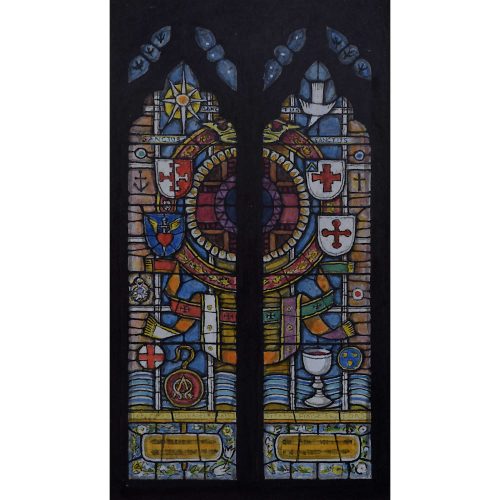
Jane Gray (b.1931)
St Michael and All Angels Church, Craven Arms, Shropshire, Design for Stained Glass Window (1995)
Watercolour 18.5 x 10.5 cmSigned, dated and studio stamp verso.
St Michael and All Angels is a Norman church that dates back to the 12th century. In 1902, it was sympathetically restored by the renowned early 20th century architect, Detmar Blow in his characteristic Arts and Crafts style, but is perhaps best known for housing both a significant fragment of a medieval wall painting, and the oldest Perpendicular pulpit (with Jacobean additions) in Shropshire.
Provenance: the artist’s studio sale. Condition: very good. If you are interested, please email info@manningfineart.co.uk or call us on 07929 749056. For other works by Jane Gray and more information about her, please click here. -
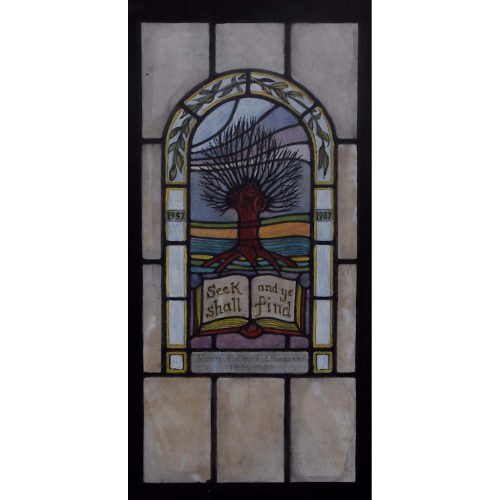
Jane Gray (b.1931)
Ruislip Library, Design for Stained Glass Window (1987)
Watercolour 18 x 8.5 cmSigned, dated and studio stamp verso.
In 1987, money was put aside for something to commemorate the Ruislip Library’s 50th anniversary; instead of another bench in a reading room, Gray received a commission for a stained glass window. This was the first window Gray made from her home in Shropshire and she used the nearby willow trees to inspire the wreath of willow leaves and central ‘Tree of Knowledge'—a pollarded willow. The choice of tree was highly intentional as, coincidentally, a librarian by the name Miss Pollard had also died that year.
Provenance: the artist’s studio sale. Literature: Jane Gray, Playing with Rainbows. (Shropshire: Ellingham Press, 2011), p.36. Condition: very good. If you are interested, please email info@manningfineart.co.uk or call us on 07929 749056. For other works by Jane Gray and more information about her, please click here. -
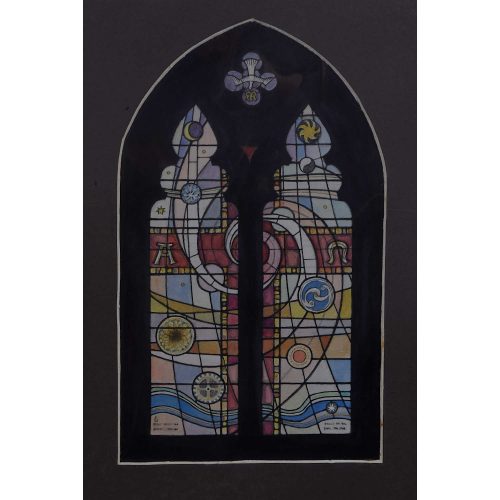
Jane Gray (b.1931)
St Mary’s Church, Bushbury, Wolverhampton, Design for Stained Glass Window (1989)
Watercolour 23 x 13.5 cmSigned, dated and studio stamp verso.
St Mary’s Church was built in the mid 14th century but underwent substantial renovations in the 19th century to the designs of Wolverhampton architect, Edward Banks with advice from the notable, Sir Gilbert Scott. St Mary’s is thought to have inspired the church at ‘M’ visited by Borrow and the Petulengroes in Chapter VIII of George Borrow’s 1857 novel, The Romany Rye. One of Gray’s most interesting and beautiful designs, this stained glass window demonstrates the artist’s distinctly modern approach, capturing something of her artistic predecessor, Hilma af Klint’s characteristic geometric style and colour palette.
Provenance: the artist’s studio sale. Condition: very good. If you are interested, please email info@manningfineart.co.uk or call us on 07929 749056. For other works by Jane Gray and more information about her, please click here. -
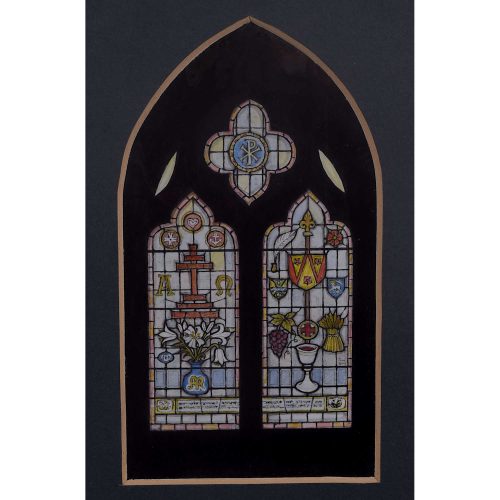
Jane Gray (b.1931)
St Mary’s Church, Penwortham, Lancashire, Design for Stained Glass Window Dedicated to the Royal British Legion (1984)
Watercolour 19.5 x 11 cmDated and artist label verso.
St Mary’s Church, set in the midst of ancient woodland, is the parish church of the Ancient Parish of Penwortham and dates from the 14th century. The church Nave and Chancel contain several memorial windows and tablets sacred to the memory of parishioners who have died; most are Victorian, such as memorial to John Horrocks, a prominent industrialist in the golden age of the Lancashire cotton industry who founded the textile company Horrockses, Miller, & Co., but the North wall features Gray’s traditional design for a window dedicated to the Royal British Legion.
Provenance: the artist’s studio sale. Condition: very good. If you are interested, please email info@manningfineart.co.uk or call us on 07929 749056. For other works by Jane Gray and more information about her, please click here. -
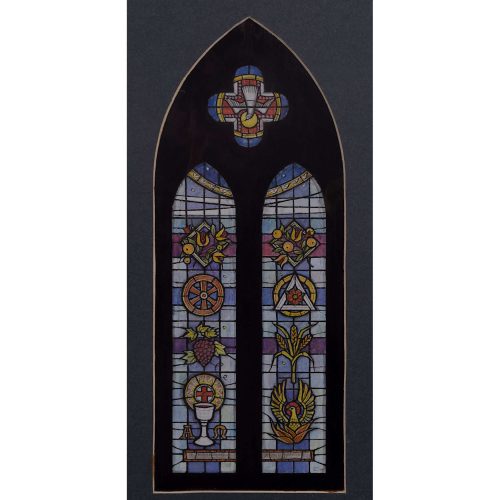
Jane Gray (b.1931)
Holy Trinity Church, Morecambe, Design for Stained Glass Window (1985)
Watercolour 25.5 x 10 cmSigned, dated and artist label verso.
Holy Trinity Church was originally built as a chapel-of-ease to St Mary’s, Lancaster in 1745 on land bequeathed for the purpose in the village blacksmith’s will of 1742. By the early 1800s the chapel was too small for the growing population and in 1840 it was redesigned and rebuilt by the Lancaster architect, Edmund Sharpe with the help of a personal contribution from Queen Victoria. The church features a number of stained glass windows designed by Shrigley and Hunt, Abbott and Company, and the Loyne Ecclesiastical Studios amongst others.
Provenance: the artist’s studio sale. Condition: very good. If you are interested, please email info@manningfineart.co.uk or call us on 07929 749056. For other works by Jane Gray and more information about her, please click here. -
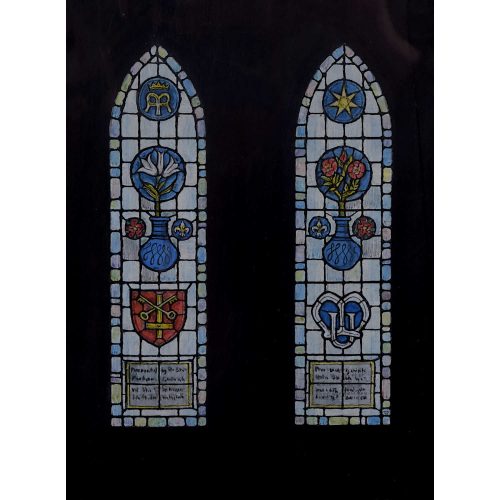
Jane Gray (b.1931)
St Peter’s Church, Chorley, Lancashire, Design for Stained Glass Window (1987)
Watercolour 18 x 13 cmSigned, dated and studio stamp verso.
St Peter’s Church was designed by the Liverpudlian architect, Charles Reed in the Early English style and built in 1850 with stone donated from Lady Hoghton’s nearby quarry. Reed wrote, ‘The general effect is expected to be very quaint and beautiful, while its elevated situation will make it a charming landmark from every side’. The church was consecrated on St Mark’s Day, 1851 by the first Bishop of Manchester, the Rt. Revd. James Prince Lee. This window was installed in 1988.
Provenance: the artist’s studio sale. Literature: Jane Gray, Playing with Rainbows. (Shropshire: Ellingham Press, 2011), p.79. Condition: very good. If you are interested, please email info@manningfineart.co.uk or call us on 07929 749056. For other works by Jane Gray and more information about her, please click here.

